

Compact Muon Solenoid
LHC, CERN
| CMS-B2G-23-002 ; CERN-EP-2024-062 | ||
| Searches for Higgs boson production through decays of heavy resonances | ||
| CMS Collaboration | ||
| 24 March 2024 | ||
| Physics Reports 1115 (2025) 368 | ||
| Abstract: The discovery of the Higgs boson has led to new possible signatures for heavy resonance searches at the LHC. Since then, search channels including at least one Higgs boson plus another particle have formed an important part of the program of new physics searches. In this report, the status of these searches by the CMS Collaboration is reviewed. Searches are discussed for resonances decaying to two Higgs bosons, a Higgs and a vector boson, or a Higgs boson and another new resonance, with proton-proton collision data collected at $ \sqrt{s}= $ 13 TeV in the years 2016-2018. A combination of the results of these searches is presented together with constraints on different beyond-the-standard model scenarios, including scenarios with extended Higgs sectors, heavy vector bosons and extra dimensions. Studies are shown for the first time by CMS on the validity of the narrow-width approximation in searches for the resonant production of a pair of Higgs bosons. The potential for a discovery at the High Luminosity LHC is also discussed. | ||
| Links: e-print arXiv:2403.16926 [hep-ex] (PDF) ; CDS record ; inSPIRE record ; HepData record ; CADI line (restricted) ; | ||
| Figures & Tables | Summary | Additional Figures | References | CMS Publications |
|---|
| Figures | |
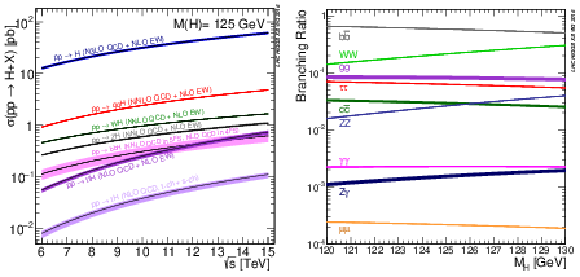
png pdf |
Figure 1:
Higgs boson production cross sections in the SM as a function of the collider centre-of-mass energy (left), and Higgs boson branching fractions in the SM as a function of the Higgs boson mass (right). Both figures are taken from Ref. [35]. |
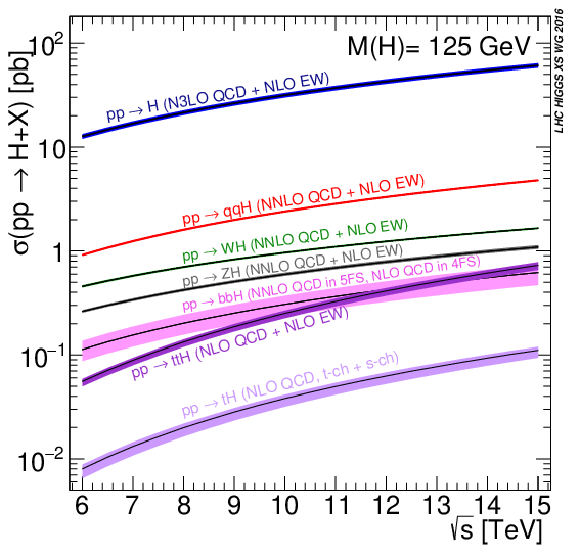
png pdf |
Figure 1-a:
Higgs boson production cross sections in the SM as a function of the collider centre-of-mass energy (left), and Higgs boson branching fractions in the SM as a function of the Higgs boson mass (right). Both figures are taken from Ref. [35]. |
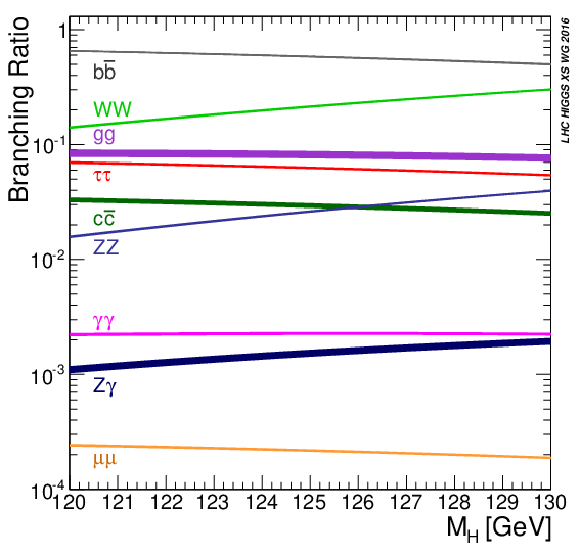
png pdf |
Figure 1-b:
Higgs boson production cross sections in the SM as a function of the collider centre-of-mass energy (left), and Higgs boson branching fractions in the SM as a function of the Higgs boson mass (right). Both figures are taken from Ref. [35]. |
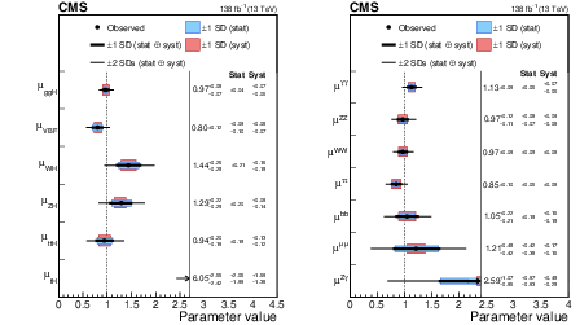
png pdf |
Figure 2:
Signal strength parameters extracted for various production modes $ \mu_i $, assuming the branching fractions $ \mathcal{B}^f = \mathcal{B}^\text{f}_\text{SM} $ (left), and decay channels $ \mu^\text{f} $, assuming the production cross sections as predicted by the SM (right). The thick and thin black lines indicate the one and two s.d. confidence intervals (labelled by SD in the figures), with the systematic and statistical components of the former indicated by the red and blue bands, respectively. The vertical dashed line at unity represents the values of $ \mu_i $ (resp. $ \mu^\text{f} $) in the SM. Taken from Ref [4]. |
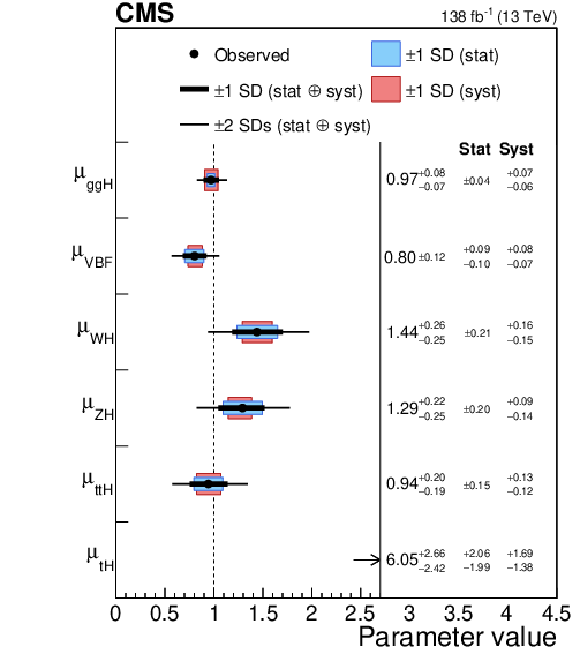
png pdf |
Figure 2-a:
Signal strength parameters extracted for various production modes $ \mu_i $, assuming the branching fractions $ \mathcal{B}^f = \mathcal{B}^\text{f}_\text{SM} $ (left), and decay channels $ \mu^\text{f} $, assuming the production cross sections as predicted by the SM (right). The thick and thin black lines indicate the one and two s.d. confidence intervals (labelled by SD in the figures), with the systematic and statistical components of the former indicated by the red and blue bands, respectively. The vertical dashed line at unity represents the values of $ \mu_i $ (resp. $ \mu^\text{f} $) in the SM. Taken from Ref [4]. |
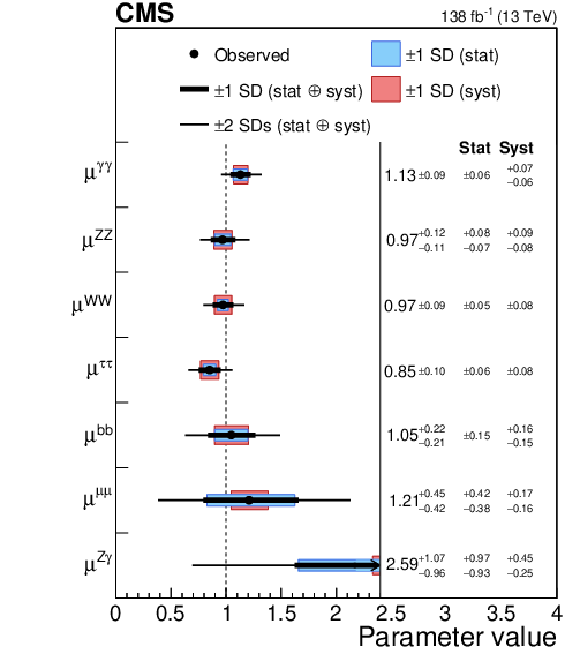
png pdf |
Figure 2-b:
Signal strength parameters extracted for various production modes $ \mu_i $, assuming the branching fractions $ \mathcal{B}^f = \mathcal{B}^\text{f}_\text{SM} $ (left), and decay channels $ \mu^\text{f} $, assuming the production cross sections as predicted by the SM (right). The thick and thin black lines indicate the one and two s.d. confidence intervals (labelled by SD in the figures), with the systematic and statistical components of the former indicated by the red and blue bands, respectively. The vertical dashed line at unity represents the values of $ \mu_i $ (resp. $ \mu^\text{f} $) in the SM. Taken from Ref [4]. |

png pdf |
Figure 3:
Measurements of the coupling modifiers $ \kappa_{i} $, allowing both invisible and undetected decay modes, with the SM value used as an upper bound on both $ \kappa_\mathrm{W} $ and $ \kappa_\mathrm{Z} $. The thick and thin black lines indicate the $ \pm $1 and $ \pm $2 s.d. confidence intervals, respectively, with the systematic and statistical components of the $ \pm $1 s.d. interval indicated by the red and blue bands. The resulting branching fractions for invisible and undetected decay modes are also displayed. Taken from Ref. [4]. |

png pdf |
Figure 4:
Leading order Feynman diagrams of Higgs boson pair production via gluon fusion. The left and middle parts of the figure show the ``triangle'' and ``box'' diagrams, respectively for nonresonant H production, as expected from the SM. The right part of the figure shows a diagram for H boson production through a new resonance of labeled as X. |
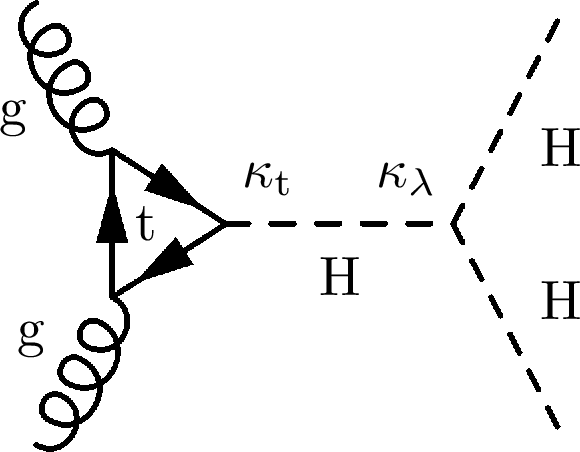
png pdf |
Figure 4-a:
Leading order Feynman diagrams of Higgs boson pair production via gluon fusion. The left and middle parts of the figure show the ``triangle'' and ``box'' diagrams, respectively for nonresonant H production, as expected from the SM. The right part of the figure shows a diagram for H boson production through a new resonance of labeled as X. |

png pdf |
Figure 4-b:
Leading order Feynman diagrams of Higgs boson pair production via gluon fusion. The left and middle parts of the figure show the ``triangle'' and ``box'' diagrams, respectively for nonresonant H production, as expected from the SM. The right part of the figure shows a diagram for H boson production through a new resonance of labeled as X. |

png pdf |
Figure 4-c:
Leading order Feynman diagrams of Higgs boson pair production via gluon fusion. The left and middle parts of the figure show the ``triangle'' and ``box'' diagrams, respectively for nonresonant H production, as expected from the SM. The right part of the figure shows a diagram for H boson production through a new resonance of labeled as X. |

png pdf |
Figure 5:
Branching fractions of $ \mathrm{X}\to{\mathrm{H}\mathrm{H}} $ decays in 2HDMs of Type I (upper) and Type II (lower) in the $ \cos(\beta - \alpha) $-$ \tan\beta $ plane for $ m_{\mathrm{X}} = $ 500 GeV (left) and in the $ m_{\mathrm{X}} $-$ \tan\beta $ plane for $ \cos(\beta - \alpha) = $ 0.02 (right). The masses of all non-SM-like Higgs bosons are set to be the same, $ m_{\mathrm{X}} = m_{ {\mathrm{A}}} $, and $ m_{12}^2 = m_{{\mathrm{A}}}^2 \tan\beta/(1 + \tan^2\beta) $. The branching fractions have been calculated with 2HDMC v1.8.0 [55, 56]. |
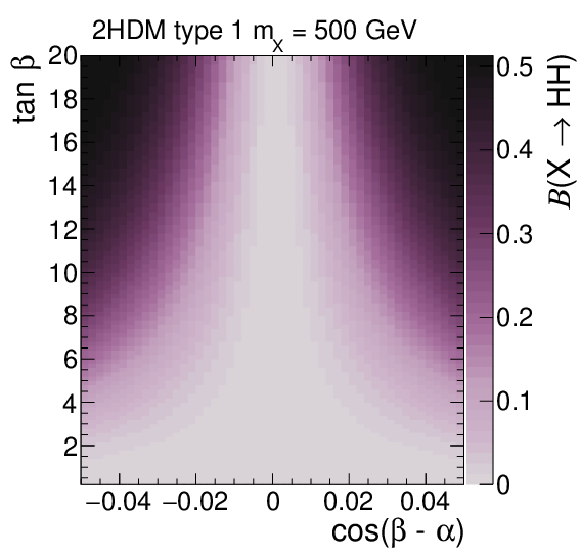
png pdf |
Figure 5-a:
Branching fractions of $ \mathrm{X}\to{\mathrm{H}\mathrm{H}} $ decays in 2HDMs of Type I (upper) and Type II (lower) in the $ \cos(\beta - \alpha) $-$ \tan\beta $ plane for $ m_{\mathrm{X}} = $ 500 GeV (left) and in the $ m_{\mathrm{X}} $-$ \tan\beta $ plane for $ \cos(\beta - \alpha) = $ 0.02 (right). The masses of all non-SM-like Higgs bosons are set to be the same, $ m_{\mathrm{X}} = m_{ {\mathrm{A}}} $, and $ m_{12}^2 = m_{{\mathrm{A}}}^2 \tan\beta/(1 + \tan^2\beta) $. The branching fractions have been calculated with 2HDMC v1.8.0 [55, 56]. |

png pdf |
Figure 5-b:
Branching fractions of $ \mathrm{X}\to{\mathrm{H}\mathrm{H}} $ decays in 2HDMs of Type I (upper) and Type II (lower) in the $ \cos(\beta - \alpha) $-$ \tan\beta $ plane for $ m_{\mathrm{X}} = $ 500 GeV (left) and in the $ m_{\mathrm{X}} $-$ \tan\beta $ plane for $ \cos(\beta - \alpha) = $ 0.02 (right). The masses of all non-SM-like Higgs bosons are set to be the same, $ m_{\mathrm{X}} = m_{ {\mathrm{A}}} $, and $ m_{12}^2 = m_{{\mathrm{A}}}^2 \tan\beta/(1 + \tan^2\beta) $. The branching fractions have been calculated with 2HDMC v1.8.0 [55, 56]. |
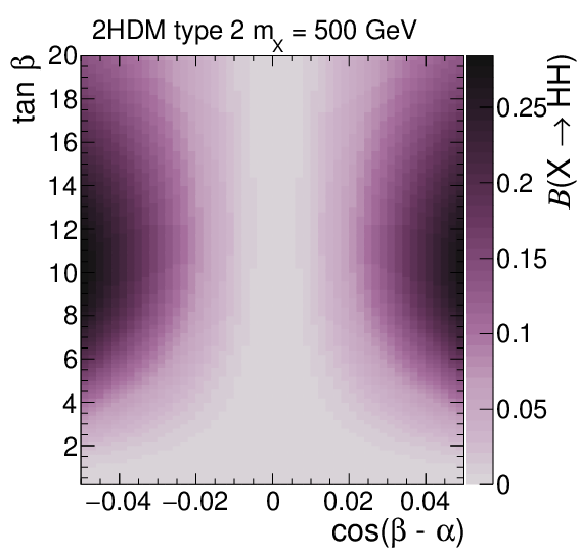
png pdf |
Figure 5-c:
Branching fractions of $ \mathrm{X}\to{\mathrm{H}\mathrm{H}} $ decays in 2HDMs of Type I (upper) and Type II (lower) in the $ \cos(\beta - \alpha) $-$ \tan\beta $ plane for $ m_{\mathrm{X}} = $ 500 GeV (left) and in the $ m_{\mathrm{X}} $-$ \tan\beta $ plane for $ \cos(\beta - \alpha) = $ 0.02 (right). The masses of all non-SM-like Higgs bosons are set to be the same, $ m_{\mathrm{X}} = m_{ {\mathrm{A}}} $, and $ m_{12}^2 = m_{{\mathrm{A}}}^2 \tan\beta/(1 + \tan^2\beta) $. The branching fractions have been calculated with 2HDMC v1.8.0 [55, 56]. |
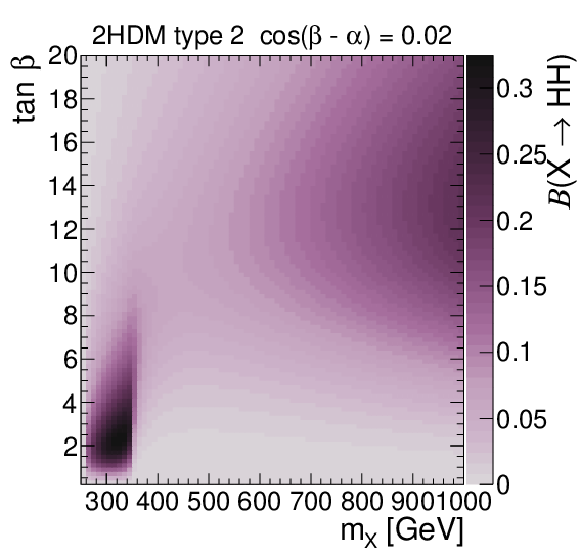
png pdf |
Figure 5-d:
Branching fractions of $ \mathrm{X}\to{\mathrm{H}\mathrm{H}} $ decays in 2HDMs of Type I (upper) and Type II (lower) in the $ \cos(\beta - \alpha) $-$ \tan\beta $ plane for $ m_{\mathrm{X}} = $ 500 GeV (left) and in the $ m_{\mathrm{X}} $-$ \tan\beta $ plane for $ \cos(\beta - \alpha) = $ 0.02 (right). The masses of all non-SM-like Higgs bosons are set to be the same, $ m_{\mathrm{X}} = m_{ {\mathrm{A}}} $, and $ m_{12}^2 = m_{{\mathrm{A}}}^2 \tan\beta/(1 + \tan^2\beta) $. The branching fractions have been calculated with 2HDMC v1.8.0 [55, 56]. |
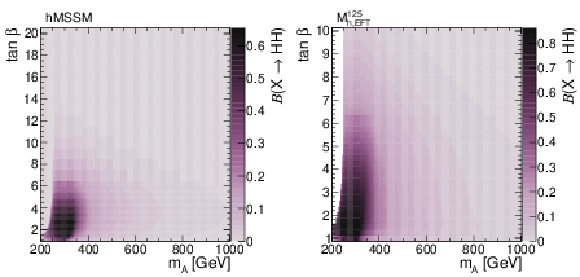
png pdf |
Figure 6:
Branching fraction of $ \mathrm{X}\to{\mathrm{H}\mathrm{H}} $ decays in the MSSM, for the hMSSM [57,58,59] (left) and the $ M^{125}_{\text{h,EFT}} $ [60] benchmarks, in the $ m_{{\mathrm{A}}} $-$ \tan \beta $ plane. The branching fractions are taken from benchmark files produced by the MSSM subgroup of the LHC Higgs Working Group [61,62]. |
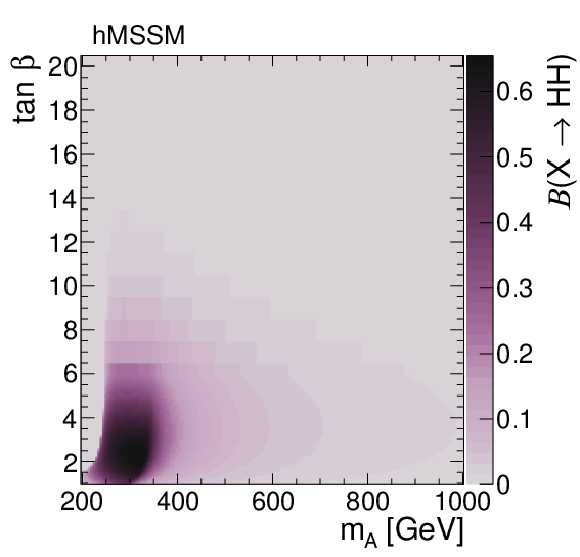
png pdf |
Figure 6-a:
Branching fraction of $ \mathrm{X}\to{\mathrm{H}\mathrm{H}} $ decays in the MSSM, for the hMSSM [57,58,59] (left) and the $ M^{125}_{\text{h,EFT}} $ [60] benchmarks, in the $ m_{{\mathrm{A}}} $-$ \tan \beta $ plane. The branching fractions are taken from benchmark files produced by the MSSM subgroup of the LHC Higgs Working Group [61,62]. |
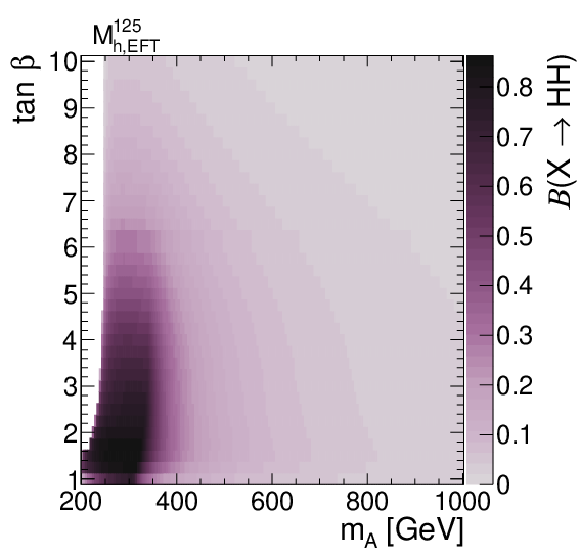
png pdf |
Figure 6-b:
Branching fraction of $ \mathrm{X}\to{\mathrm{H}\mathrm{H}} $ decays in the MSSM, for the hMSSM [57,58,59] (left) and the $ M^{125}_{\text{h,EFT}} $ [60] benchmarks, in the $ m_{{\mathrm{A}}} $-$ \tan \beta $ plane. The branching fractions are taken from benchmark files produced by the MSSM subgroup of the LHC Higgs Working Group [61,62]. |

png pdf |
Figure 7:
Localization of fields on the branes, in different types of the Randall-Sundrum (RS) model: RS1 (left) and bulk-RS (right). The $ x $-axis represents the 5th dimension with the Planck brane on the left and the TeV brane on the right. The $ y $-axis is the probability density. Adapted from Ref. [28]. |
png pdf |
Figure 7-a:
Localization of fields on the branes, in different types of the Randall-Sundrum (RS) model: RS1 (left) and bulk-RS (right). The $ x $-axis represents the 5th dimension with the Planck brane on the left and the TeV brane on the right. The $ y $-axis is the probability density. Adapted from Ref. [28]. |
png pdf |
Figure 7-b:
Localization of fields on the branes, in different types of the Randall-Sundrum (RS) model: RS1 (left) and bulk-RS (right). The $ x $-axis represents the 5th dimension with the Planck brane on the left and the TeV brane on the right. The $ y $-axis is the probability density. Adapted from Ref. [28]. |
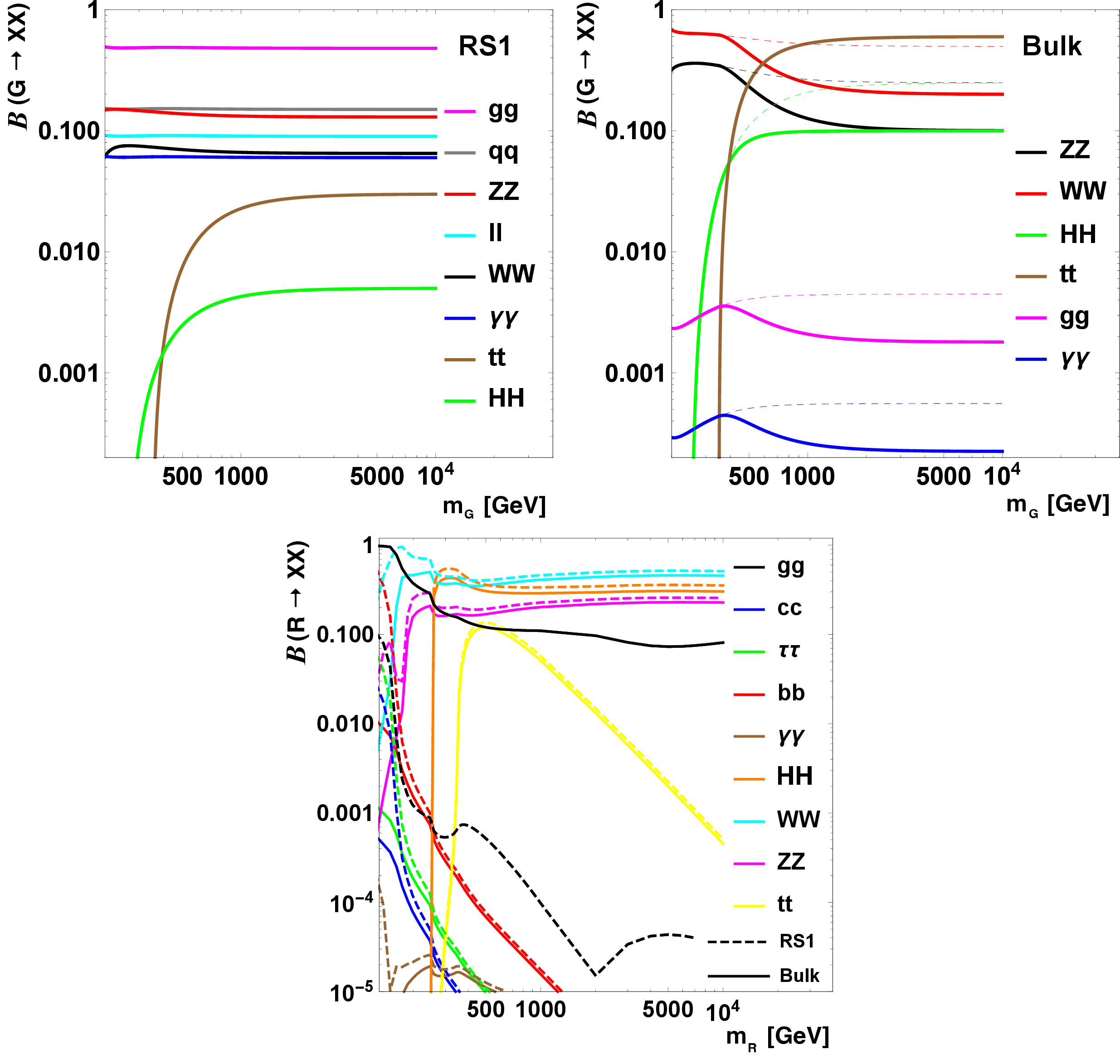
png pdf |
Figure 8:
The decay branching fractions of an RS1 graviton (top left), bulk graviton (upper right), and radion (lower). Solid lines assume a fully elementary top quark, while the dashed lines ignore the coupling of the graviton to top quarks. Adapted from Ref. [28]. |
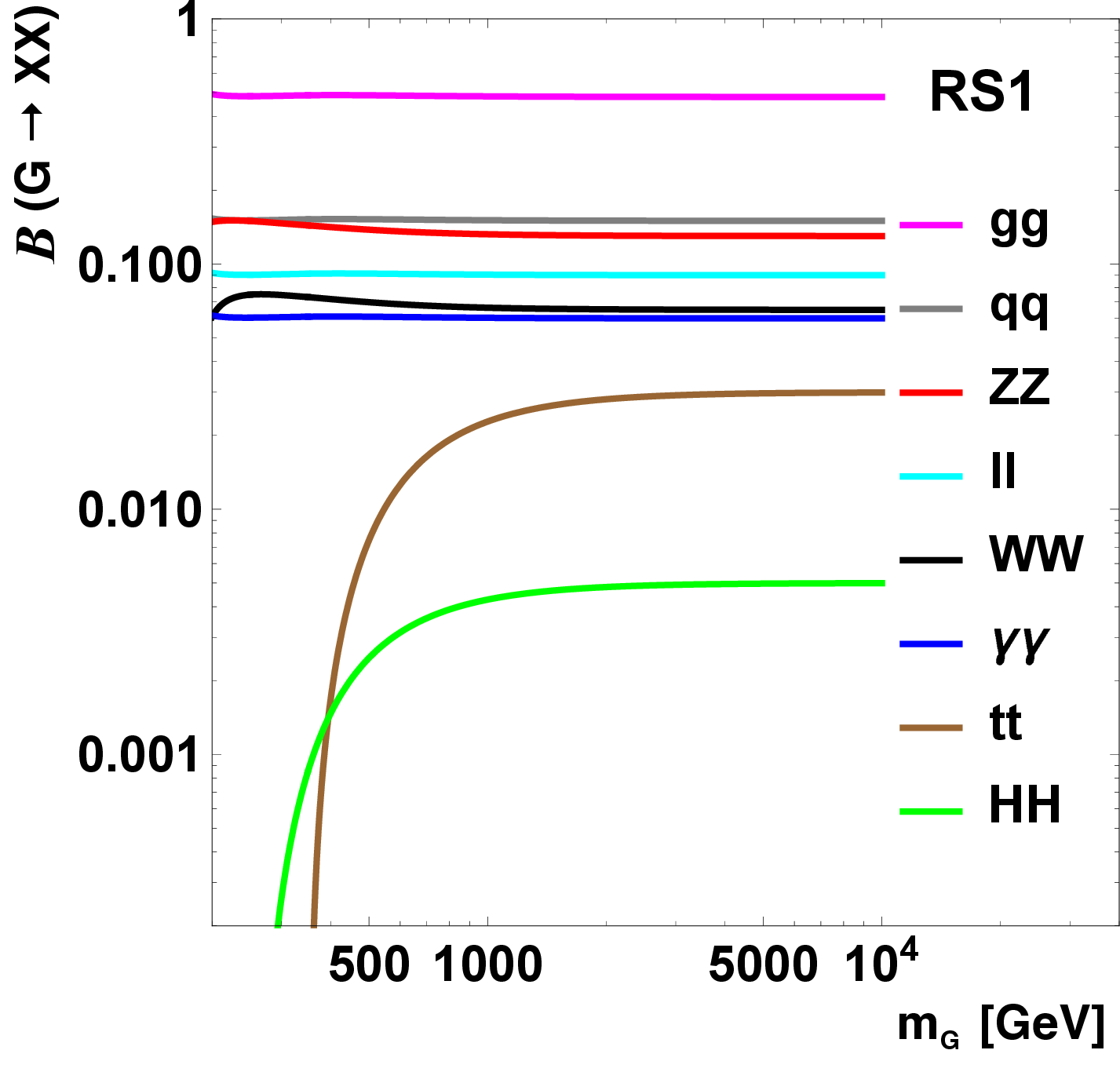
png pdf |
Figure 8-a:
The decay branching fractions of an RS1 graviton (top left), bulk graviton (upper right), and radion (lower). Solid lines assume a fully elementary top quark, while the dashed lines ignore the coupling of the graviton to top quarks. Adapted from Ref. [28]. |
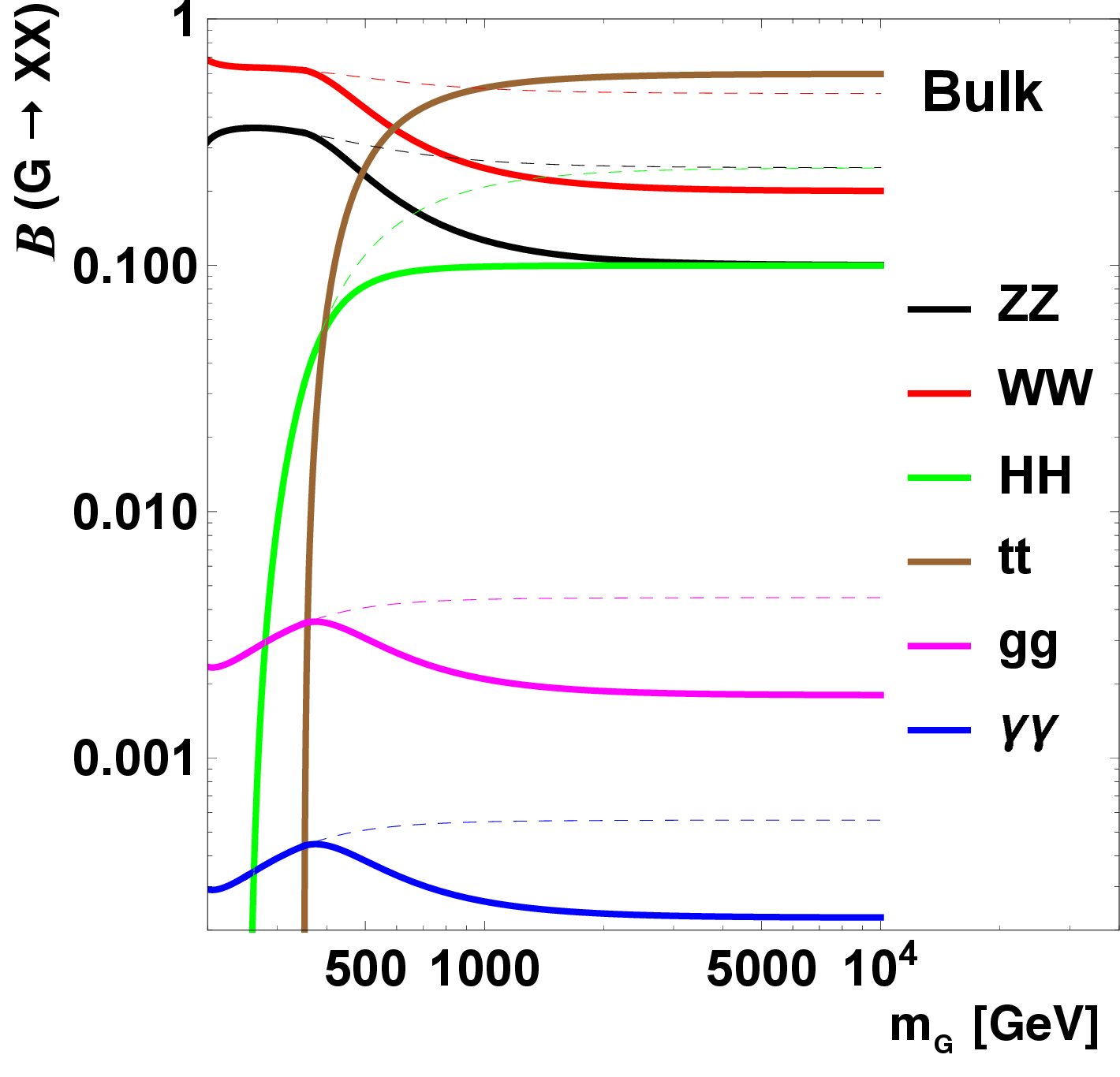
png pdf |
Figure 8-b:
The decay branching fractions of an RS1 graviton (top left), bulk graviton (upper right), and radion (lower). Solid lines assume a fully elementary top quark, while the dashed lines ignore the coupling of the graviton to top quarks. Adapted from Ref. [28]. |
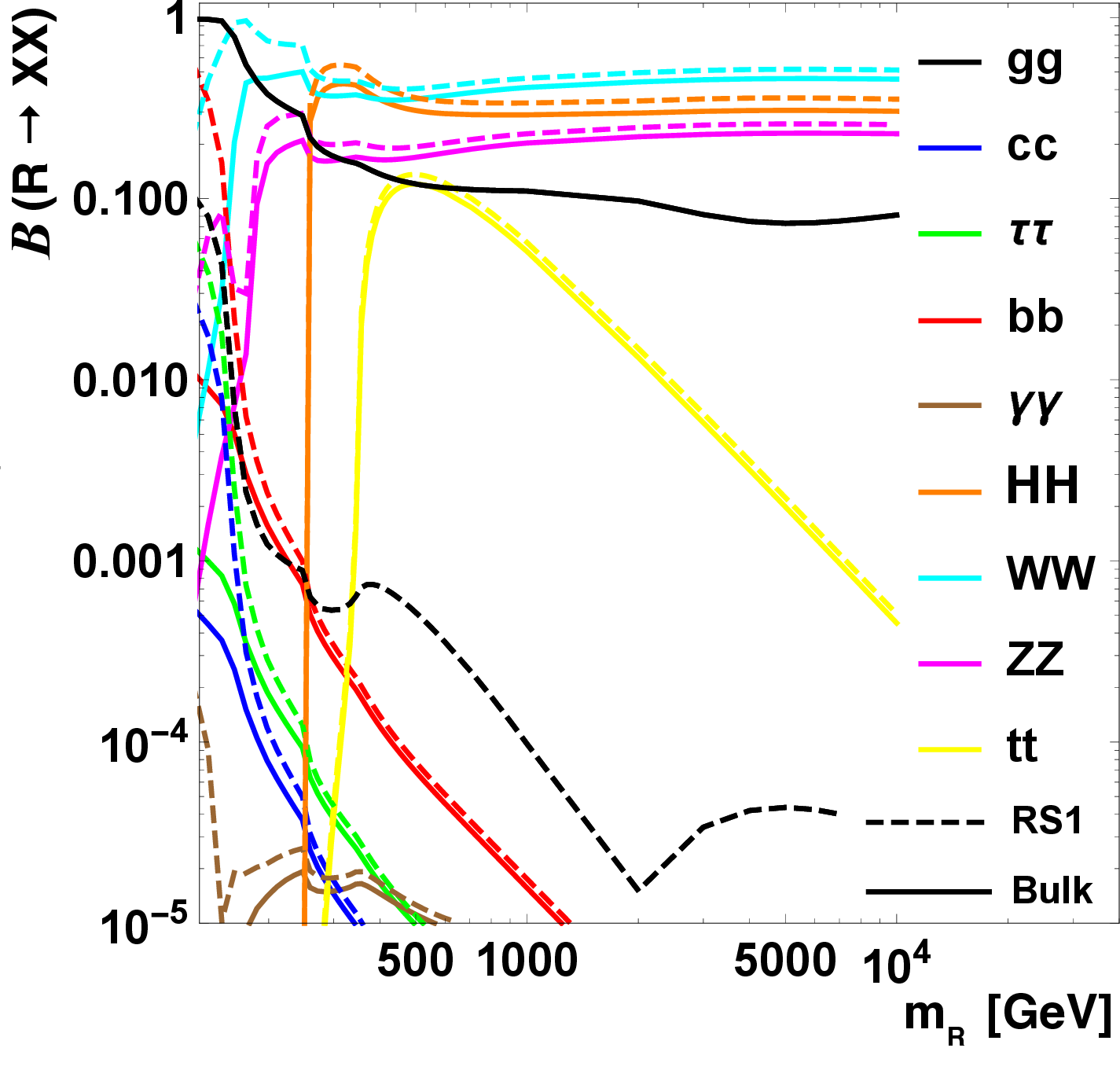
png pdf |
Figure 8-c:
The decay branching fractions of an RS1 graviton (top left), bulk graviton (upper right), and radion (lower). Solid lines assume a fully elementary top quark, while the dashed lines ignore the coupling of the graviton to top quarks. Adapted from Ref. [28]. |

png pdf |
Figure 9:
Feynman diagrams for the production of Z' and W' bosons produced through the (left) Drell-Yan and (right) vector boson fusion process. The Z' (resp. W') boson subsequently decays into ZH and WH, respectively. |
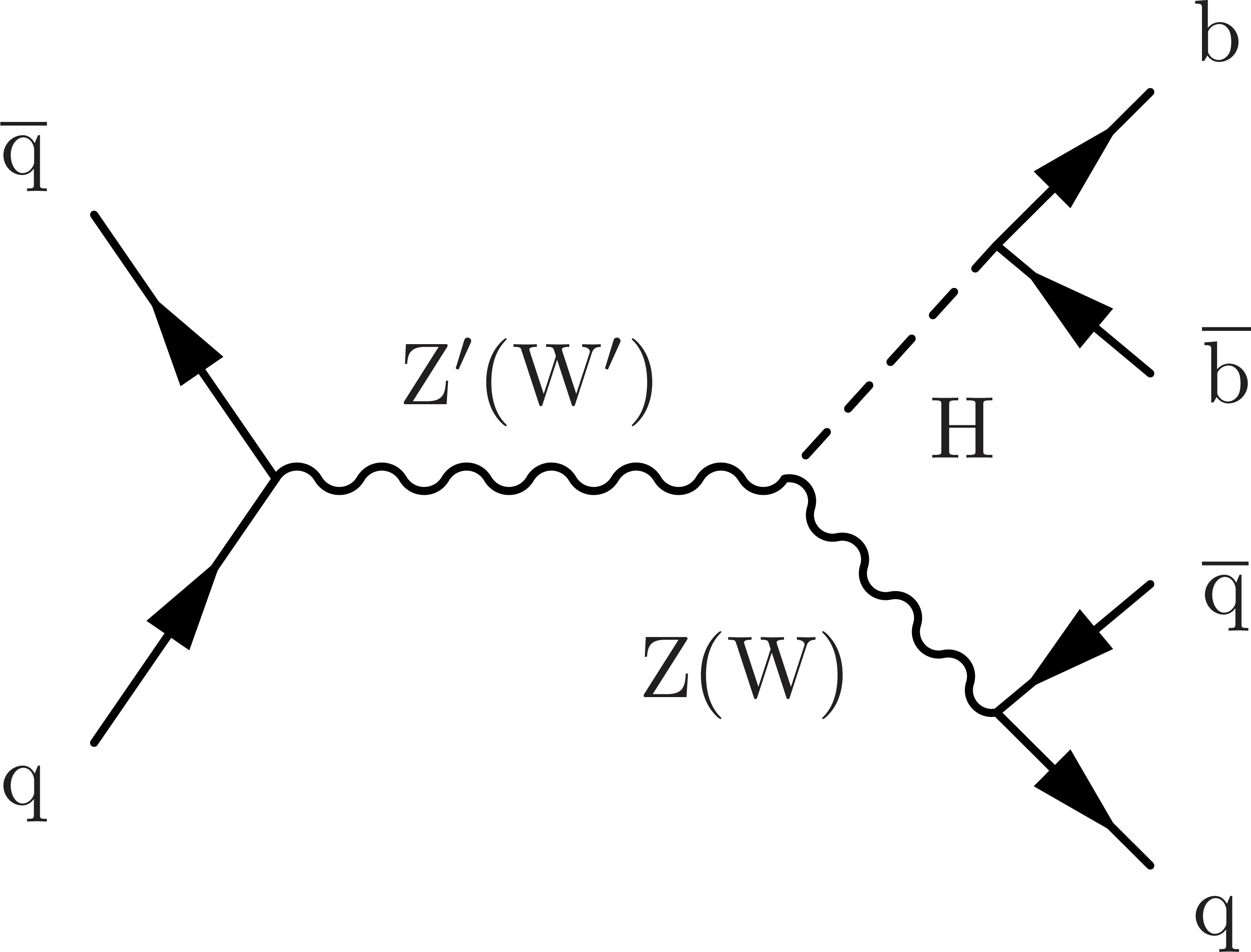
png pdf |
Figure 9-a:
Feynman diagrams for the production of Z' and W' bosons produced through the (left) Drell-Yan and (right) vector boson fusion process. The Z' (resp. W') boson subsequently decays into ZH and WH, respectively. |
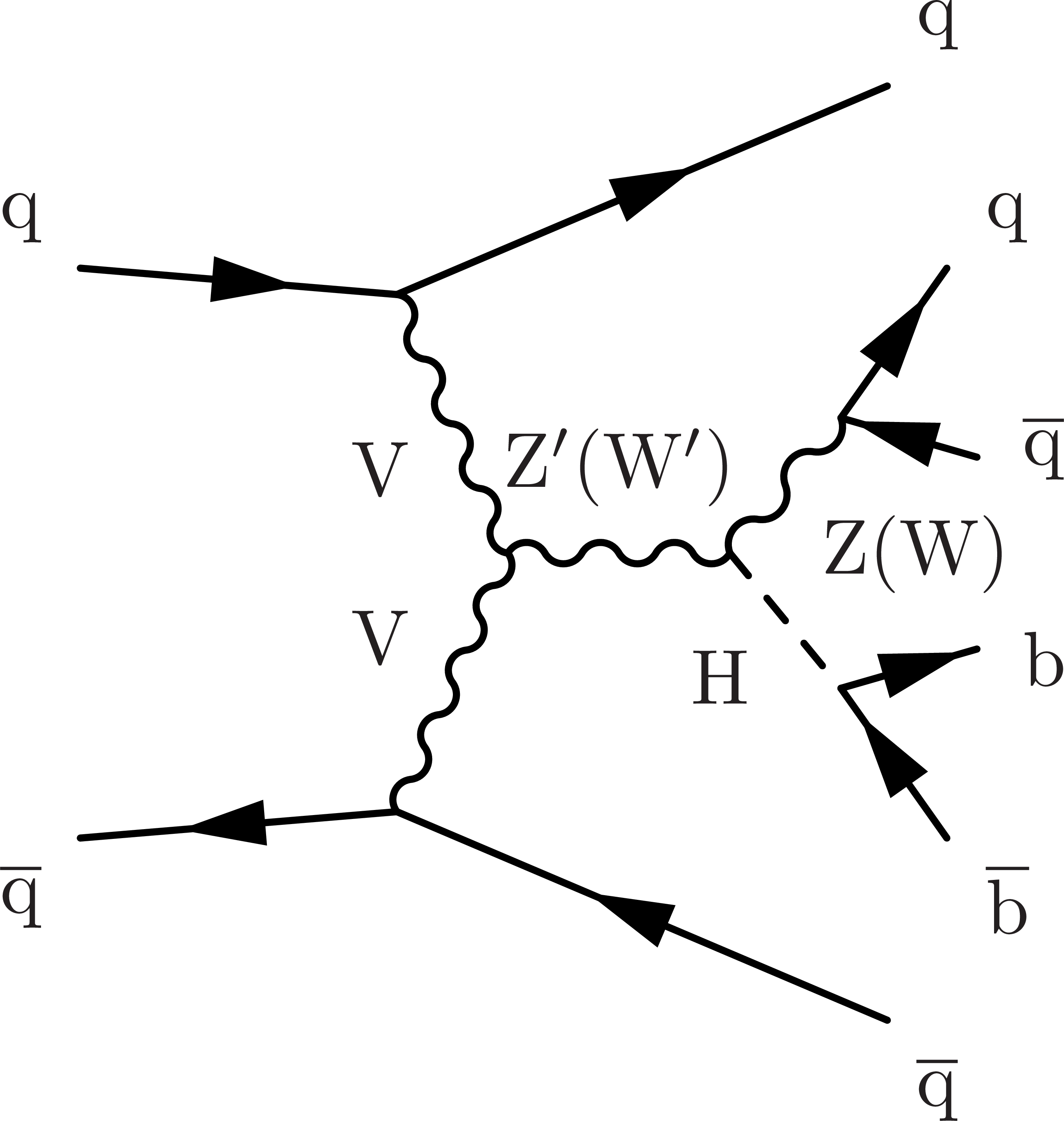
png pdf |
Figure 9-b:
Feynman diagrams for the production of Z' and W' bosons produced through the (left) Drell-Yan and (right) vector boson fusion process. The Z' (resp. W') boson subsequently decays into ZH and WH, respectively. |
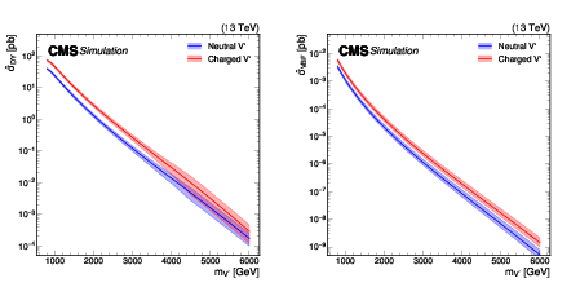
png pdf |
Figure 10:
Cross sections for (left) Drell-Yan production ($ \hat{\sigma}_{\mathrm{DY}} $) and (right) production through vector boson fusion ($ \hat{\sigma}_{\mathrm{ VBF}} $), as defined in Eqs. \eqrefeq:DY_HVT and \eqrefeq:VBF_HVT, for Z' and W' bosons in the heavy vector triplet (HVT) model B at $ \sqrt{s} = $ 13 TeV. Calculations are based on the work of Ref. [30]. |
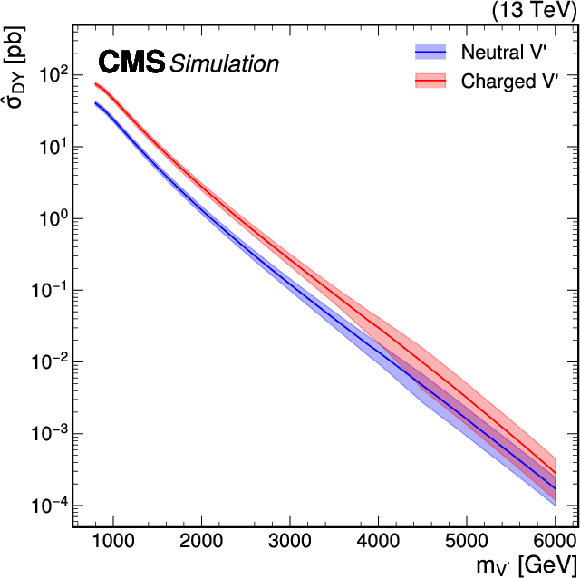
png pdf |
Figure 10-a:
Cross sections for (left) Drell-Yan production ($ \hat{\sigma}_{\mathrm{DY}} $) and (right) production through vector boson fusion ($ \hat{\sigma}_{\mathrm{ VBF}} $), as defined in Eqs. \eqrefeq:DY_HVT and \eqrefeq:VBF_HVT, for Z' and W' bosons in the heavy vector triplet (HVT) model B at $ \sqrt{s} = $ 13 TeV. Calculations are based on the work of Ref. [30]. |
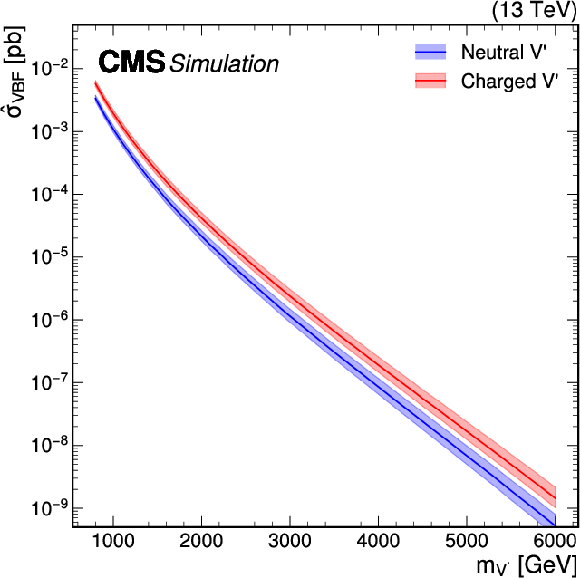
png pdf |
Figure 10-b:
Cross sections for (left) Drell-Yan production ($ \hat{\sigma}_{\mathrm{DY}} $) and (right) production through vector boson fusion ($ \hat{\sigma}_{\mathrm{ VBF}} $), as defined in Eqs. \eqrefeq:DY_HVT and \eqrefeq:VBF_HVT, for Z' and W' bosons in the heavy vector triplet (HVT) model B at $ \sqrt{s} = $ 13 TeV. Calculations are based on the work of Ref. [30]. |
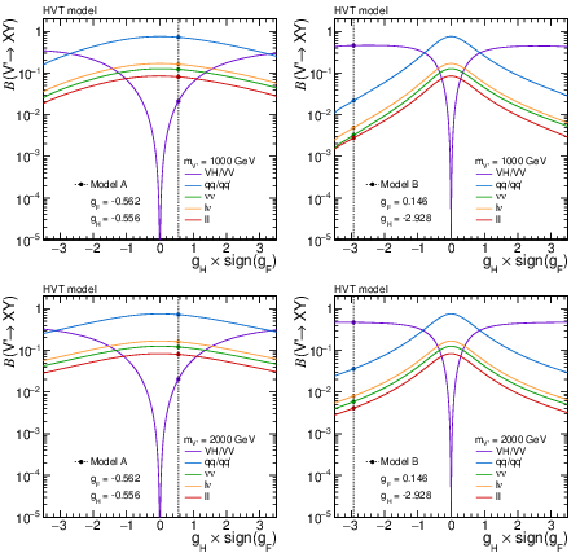
png pdf |
Figure 11:
Branching fractions for heavy vector triplet (HVT) bosons with masses of (upper) 1 and (lower) 2 TeV for values of the parameter $ g_\mathrm{F} $ corresponding to models (left) A and (right) B. The exact branching fractions of each model are indicated by the crossing points of the individual curves with the dashed vertical lines. Calculations are based on the work of Ref. [30]. |
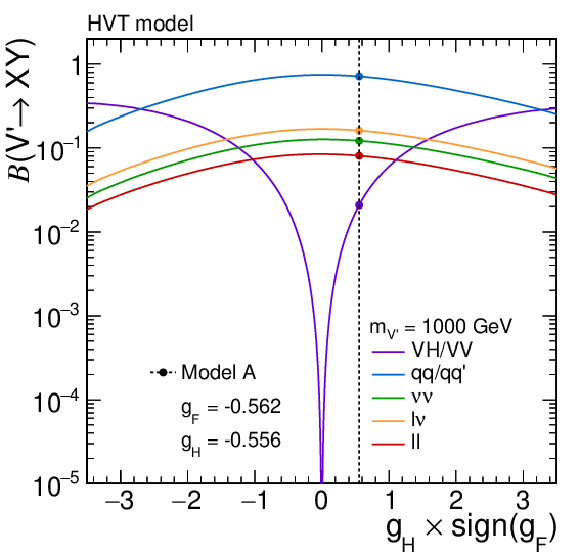
png pdf |
Figure 11-a:
Branching fractions for heavy vector triplet (HVT) bosons with masses of (upper) 1 and (lower) 2 TeV for values of the parameter $ g_\mathrm{F} $ corresponding to models (left) A and (right) B. The exact branching fractions of each model are indicated by the crossing points of the individual curves with the dashed vertical lines. Calculations are based on the work of Ref. [30]. |

png pdf |
Figure 11-b:
Branching fractions for heavy vector triplet (HVT) bosons with masses of (upper) 1 and (lower) 2 TeV for values of the parameter $ g_\mathrm{F} $ corresponding to models (left) A and (right) B. The exact branching fractions of each model are indicated by the crossing points of the individual curves with the dashed vertical lines. Calculations are based on the work of Ref. [30]. |
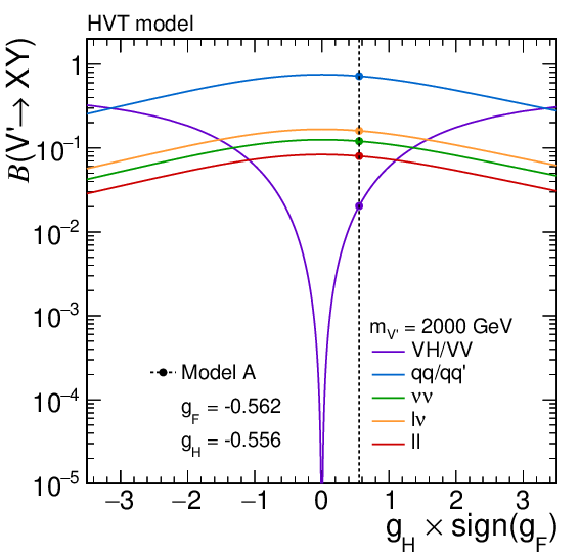
png pdf |
Figure 11-c:
Branching fractions for heavy vector triplet (HVT) bosons with masses of (upper) 1 and (lower) 2 TeV for values of the parameter $ g_\mathrm{F} $ corresponding to models (left) A and (right) B. The exact branching fractions of each model are indicated by the crossing points of the individual curves with the dashed vertical lines. Calculations are based on the work of Ref. [30]. |
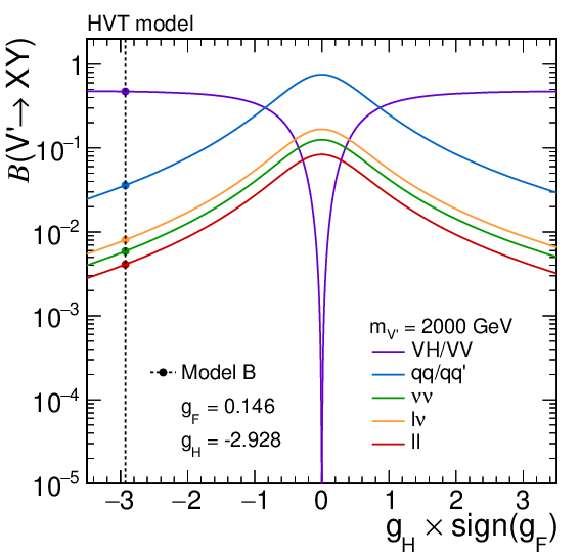
png pdf |
Figure 11-d:
Branching fractions for heavy vector triplet (HVT) bosons with masses of (upper) 1 and (lower) 2 TeV for values of the parameter $ g_\mathrm{F} $ corresponding to models (left) A and (right) B. The exact branching fractions of each model are indicated by the crossing points of the individual curves with the dashed vertical lines. Calculations are based on the work of Ref. [30]. |

png pdf |
Figure 12:
(left) Branching fraction for the decay $ \mathrm{Z}^{'}\to\mathrm{Z}\mathrm{H} $, and (right) total width of the Z' boson, for a resonance with 2 TeV mass, for different values of the parameter $ g_\mathrm{F} $. Calculations are based the work of Ref. [30]. |
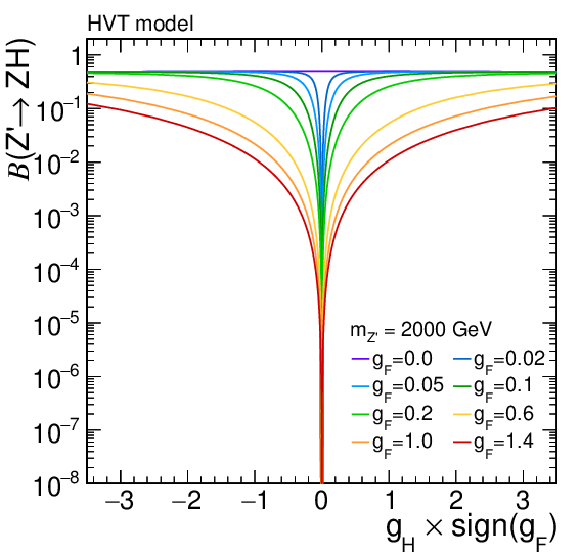
png pdf |
Figure 12-a:
(left) Branching fraction for the decay $ \mathrm{Z}^{'}\to\mathrm{Z}\mathrm{H} $, and (right) total width of the Z' boson, for a resonance with 2 TeV mass, for different values of the parameter $ g_\mathrm{F} $. Calculations are based the work of Ref. [30]. |
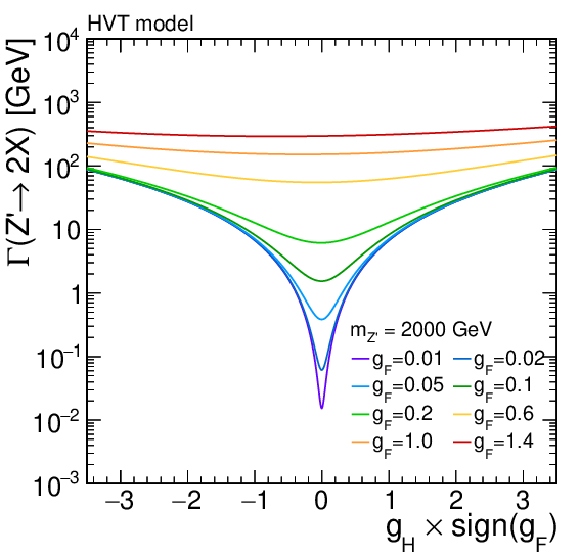
png pdf |
Figure 12-b:
(left) Branching fraction for the decay $ \mathrm{Z}^{'}\to\mathrm{Z}\mathrm{H} $, and (right) total width of the Z' boson, for a resonance with 2 TeV mass, for different values of the parameter $ g_\mathrm{F} $. Calculations are based the work of Ref. [30]. |
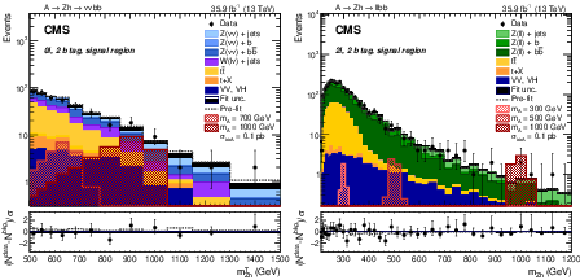
png pdf |
Figure 13:
Search for $ \mathrm{X}\to\mathrm{V}\mathrm{H}(\mathrm{b}\mathrm{b}) $: Distributions of the $ m_{\mathrm{Z}\mathrm{H}}^{\text{T}} $ and $ m_{\mathrm{Z}\mathrm{H}} $ variables, as introduced in the text, in the (left) 0 $ \ell $ and (right) 2 $ \ell $ categories, in the 2 b tag signal region of the $ {\mathrm{A}} \to\mathrm{Z}\mathrm{H}(\mathrm{b}\mathrm{b}) $ analysis [108]. In the 2 $ \ell $ categories, the contributions of the 2 e and 2 $ \mu $ channels have been summed. The gray dotted line represents the sum of all background processes before the fit to data; the shaded area represents the post-fit uncertainty. The hatched red histograms represent signal hypotheses for b quark associated X production corresponding to $ \sigma_{{\mathrm{A}} }\mathcal{B}({\mathrm{A}} \to\mathrm{Z}\mathrm{H}) \mathcal{B}(\mathrm{H}\to\mathrm{b}\mathrm{b})= $ 0.1 pb. The lower panels depict $ (N^\text{ data}-N^\text{bkg})/\sigma $ in each bin, where $ \sigma $ refers to the statistical uncertainty in the given bin. Figure from Ref. [108]. |
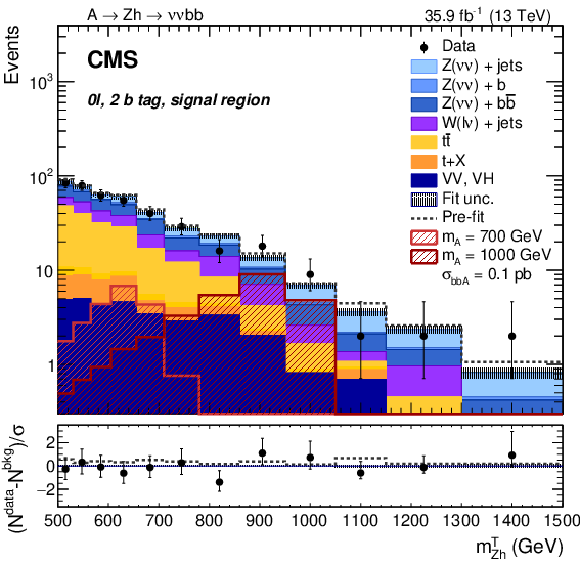
png pdf |
Figure 13-a:
Search for $ \mathrm{X}\to\mathrm{V}\mathrm{H}(\mathrm{b}\mathrm{b}) $: Distributions of the $ m_{\mathrm{Z}\mathrm{H}}^{\text{T}} $ and $ m_{\mathrm{Z}\mathrm{H}} $ variables, as introduced in the text, in the (left) 0 $ \ell $ and (right) 2 $ \ell $ categories, in the 2 b tag signal region of the $ {\mathrm{A}} \to\mathrm{Z}\mathrm{H}(\mathrm{b}\mathrm{b}) $ analysis [108]. In the 2 $ \ell $ categories, the contributions of the 2 e and 2 $ \mu $ channels have been summed. The gray dotted line represents the sum of all background processes before the fit to data; the shaded area represents the post-fit uncertainty. The hatched red histograms represent signal hypotheses for b quark associated X production corresponding to $ \sigma_{{\mathrm{A}} }\mathcal{B}({\mathrm{A}} \to\mathrm{Z}\mathrm{H}) \mathcal{B}(\mathrm{H}\to\mathrm{b}\mathrm{b})= $ 0.1 pb. The lower panels depict $ (N^\text{ data}-N^\text{bkg})/\sigma $ in each bin, where $ \sigma $ refers to the statistical uncertainty in the given bin. Figure from Ref. [108]. |
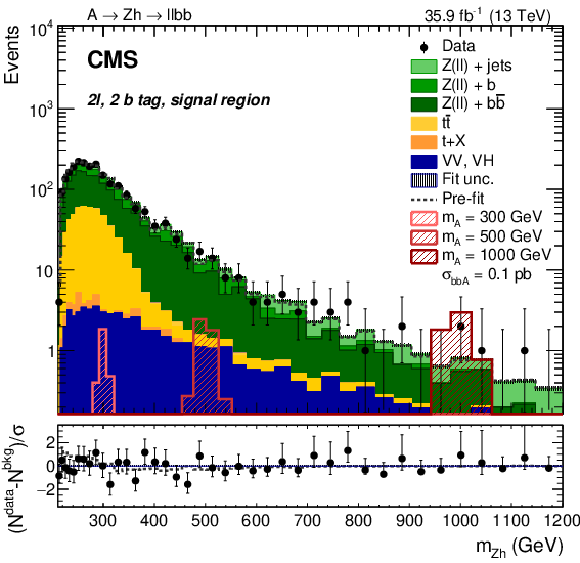
png pdf |
Figure 13-b:
Search for $ \mathrm{X}\to\mathrm{V}\mathrm{H}(\mathrm{b}\mathrm{b}) $: Distributions of the $ m_{\mathrm{Z}\mathrm{H}}^{\text{T}} $ and $ m_{\mathrm{Z}\mathrm{H}} $ variables, as introduced in the text, in the (left) 0 $ \ell $ and (right) 2 $ \ell $ categories, in the 2 b tag signal region of the $ {\mathrm{A}} \to\mathrm{Z}\mathrm{H}(\mathrm{b}\mathrm{b}) $ analysis [108]. In the 2 $ \ell $ categories, the contributions of the 2 e and 2 $ \mu $ channels have been summed. The gray dotted line represents the sum of all background processes before the fit to data; the shaded area represents the post-fit uncertainty. The hatched red histograms represent signal hypotheses for b quark associated X production corresponding to $ \sigma_{{\mathrm{A}} }\mathcal{B}({\mathrm{A}} \to\mathrm{Z}\mathrm{H}) \mathcal{B}(\mathrm{H}\to\mathrm{b}\mathrm{b})= $ 0.1 pb. The lower panels depict $ (N^\text{ data}-N^\text{bkg})/\sigma $ in each bin, where $ \sigma $ refers to the statistical uncertainty in the given bin. Figure from Ref. [108]. |
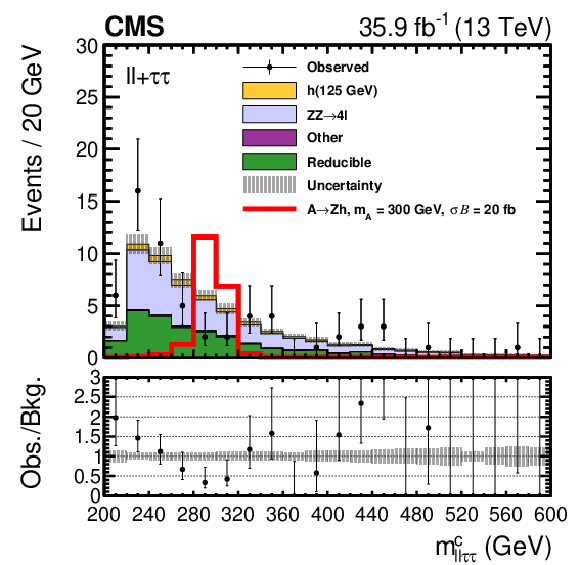
png pdf |
Figure 14:
Search for $ \mathrm{X}\to\mathrm{V}\mathrm{H}(\tau\tau) $: Distribution of the $ m_{\ell\ell\tau\tau}^{\mathrm{c}} $ variable, as introduced in the text, of the $ {\mathrm{A}} \to\mathrm{Z}\mathrm{H}(\tau\tau) $ analysis [107], after a fit of the background-only hypothesis in all eight final states. While the fit is based on corresponding distributions, for each final state individually, these have been combined into a single distribution, for visualization purposes for this figure. Uncertainties include both statistical and systematic components. The expected contribution from the $ {\mathrm{A}}\to\mathrm{Z}\mathrm{H} $ signal process is shown for a pseudoscalar Higgs boson with $ m_{{\mathrm{A}}} = $ 300 GeV with the product of the cross section and branching fraction of 20 fb. Figure from Ref. [107]. |

png pdf |
Figure 15:
Search for $ \mathrm{X}\to\mathrm{V}\mathrm{H}(\mathrm{b}\mathrm{b}) $: Distributions of (left) the jet soft drop mass of a boosted Higgs boson candidate, labeled $ m_{\mathrm{jet}} $, and (right) the mass of the X resonance candidate, labeled $ m_{\mathrm{WV}} $ in the $ \mathrm{W}(\ell\nu)\mathrm{H}(\mathrm{b}\mathrm{b}) $ channel. The notation $ m_{\mathrm{WV}} $ is used as a shorthand since the analysis also searches for resonances in the WW and WZ final states. Figures from Ref. [109]. |
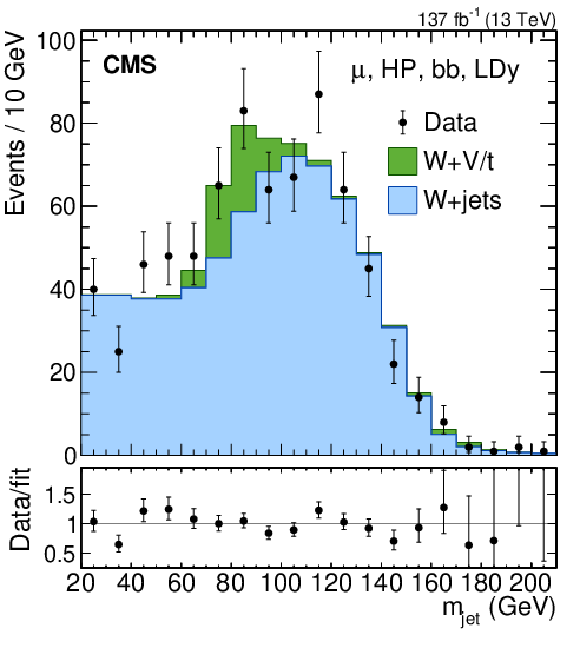
png pdf |
Figure 15-a:
Search for $ \mathrm{X}\to\mathrm{V}\mathrm{H}(\mathrm{b}\mathrm{b}) $: Distributions of (left) the jet soft drop mass of a boosted Higgs boson candidate, labeled $ m_{\mathrm{jet}} $, and (right) the mass of the X resonance candidate, labeled $ m_{\mathrm{WV}} $ in the $ \mathrm{W}(\ell\nu)\mathrm{H}(\mathrm{b}\mathrm{b}) $ channel. The notation $ m_{\mathrm{WV}} $ is used as a shorthand since the analysis also searches for resonances in the WW and WZ final states. Figures from Ref. [109]. |
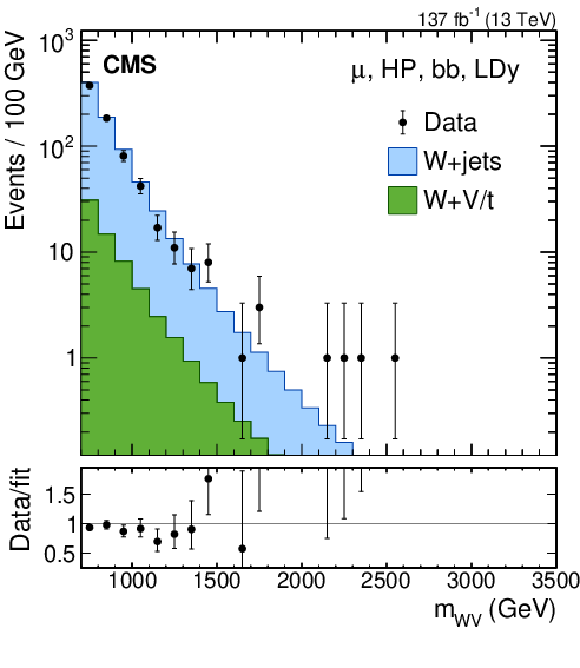
png pdf |
Figure 15-b:
Search for $ \mathrm{X}\to\mathrm{V}\mathrm{H}(\mathrm{b}\mathrm{b}) $: Distributions of (left) the jet soft drop mass of a boosted Higgs boson candidate, labeled $ m_{\mathrm{jet}} $, and (right) the mass of the X resonance candidate, labeled $ m_{\mathrm{WV}} $ in the $ \mathrm{W}(\ell\nu)\mathrm{H}(\mathrm{b}\mathrm{b}) $ channel. The notation $ m_{\mathrm{WV}} $ is used as a shorthand since the analysis also searches for resonances in the WW and WZ final states. Figures from Ref. [109]. |

png pdf |
Figure 16:
Search for $ \mathrm{X}\to\mathrm{V}\mathrm{H}(\mathrm{b}\mathrm{b}) $: Distributions of (left) the jet soft drop mass of a boosted Higgs boson candidate, labeled $ m_{\text{j}\mathrm{H}} $, and (right) the mass or transverse mass of the X resonance candidate, labeled $ m_{\mathrm{X}} $ and $ m_{\mathrm{X}}^{\mathrm{T}} $, respectively, in the $ \mathrm{Z}(\ell\ell)\mathrm{H}(\mathrm{b}\mathrm{b}) $ (upper) and $ \mathrm{Z}(\nu\nu)\mathrm{H}(\mathrm{b}\mathrm{b}) $ channels (lower). The shaded area depicts a veto region excluded from the analysis to minimize the event overlap with dedicated searches in the VV decay channel. Figures from Ref. [110]. |

png pdf |
Figure 16-a:
Search for $ \mathrm{X}\to\mathrm{V}\mathrm{H}(\mathrm{b}\mathrm{b}) $: Distributions of (left) the jet soft drop mass of a boosted Higgs boson candidate, labeled $ m_{\text{j}\mathrm{H}} $, and (right) the mass or transverse mass of the X resonance candidate, labeled $ m_{\mathrm{X}} $ and $ m_{\mathrm{X}}^{\mathrm{T}} $, respectively, in the $ \mathrm{Z}(\ell\ell)\mathrm{H}(\mathrm{b}\mathrm{b}) $ (upper) and $ \mathrm{Z}(\nu\nu)\mathrm{H}(\mathrm{b}\mathrm{b}) $ channels (lower). The shaded area depicts a veto region excluded from the analysis to minimize the event overlap with dedicated searches in the VV decay channel. Figures from Ref. [110]. |
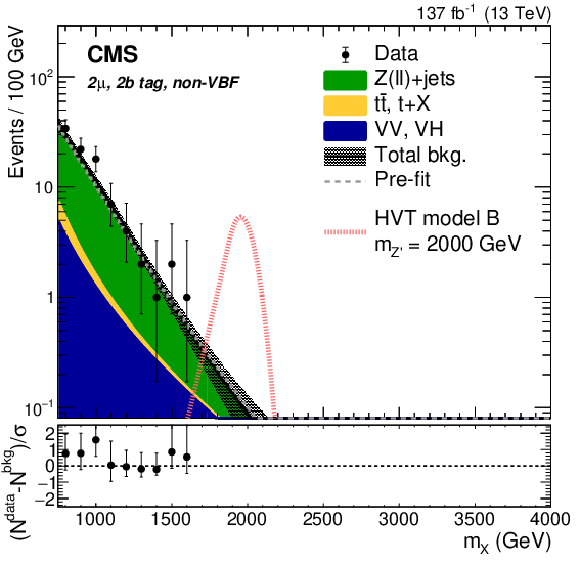
png pdf |
Figure 16-b:
Search for $ \mathrm{X}\to\mathrm{V}\mathrm{H}(\mathrm{b}\mathrm{b}) $: Distributions of (left) the jet soft drop mass of a boosted Higgs boson candidate, labeled $ m_{\text{j}\mathrm{H}} $, and (right) the mass or transverse mass of the X resonance candidate, labeled $ m_{\mathrm{X}} $ and $ m_{\mathrm{X}}^{\mathrm{T}} $, respectively, in the $ \mathrm{Z}(\ell\ell)\mathrm{H}(\mathrm{b}\mathrm{b}) $ (upper) and $ \mathrm{Z}(\nu\nu)\mathrm{H}(\mathrm{b}\mathrm{b}) $ channels (lower). The shaded area depicts a veto region excluded from the analysis to minimize the event overlap with dedicated searches in the VV decay channel. Figures from Ref. [110]. |
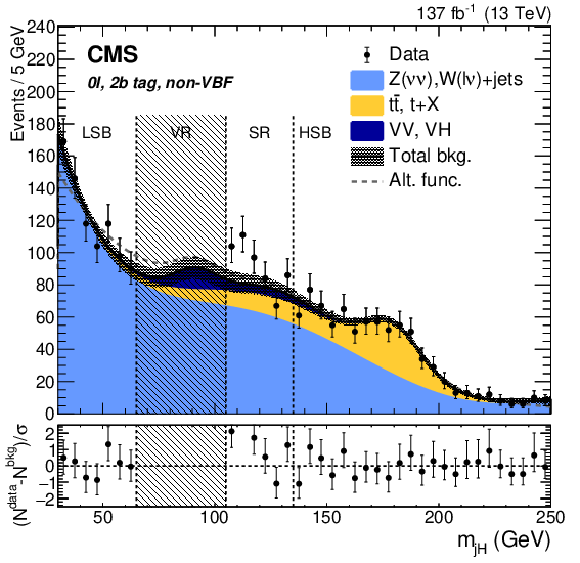
png pdf |
Figure 16-c:
Search for $ \mathrm{X}\to\mathrm{V}\mathrm{H}(\mathrm{b}\mathrm{b}) $: Distributions of (left) the jet soft drop mass of a boosted Higgs boson candidate, labeled $ m_{\text{j}\mathrm{H}} $, and (right) the mass or transverse mass of the X resonance candidate, labeled $ m_{\mathrm{X}} $ and $ m_{\mathrm{X}}^{\mathrm{T}} $, respectively, in the $ \mathrm{Z}(\ell\ell)\mathrm{H}(\mathrm{b}\mathrm{b}) $ (upper) and $ \mathrm{Z}(\nu\nu)\mathrm{H}(\mathrm{b}\mathrm{b}) $ channels (lower). The shaded area depicts a veto region excluded from the analysis to minimize the event overlap with dedicated searches in the VV decay channel. Figures from Ref. [110]. |
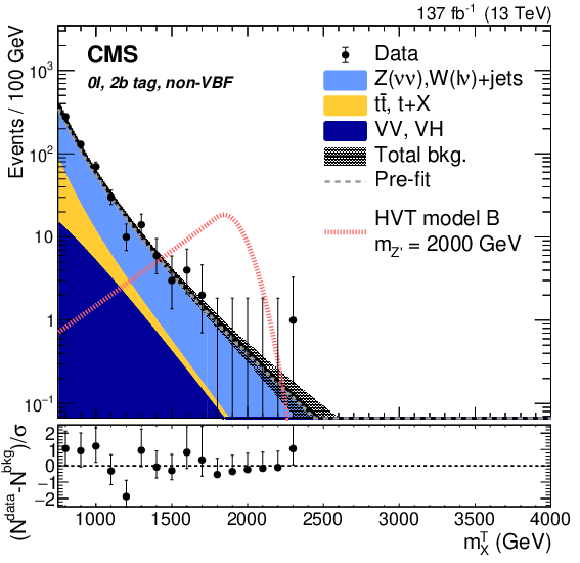
png pdf |
Figure 16-d:
Search for $ \mathrm{X}\to\mathrm{V}\mathrm{H}(\mathrm{b}\mathrm{b}) $: Distributions of (left) the jet soft drop mass of a boosted Higgs boson candidate, labeled $ m_{\text{j}\mathrm{H}} $, and (right) the mass or transverse mass of the X resonance candidate, labeled $ m_{\mathrm{X}} $ and $ m_{\mathrm{X}}^{\mathrm{T}} $, respectively, in the $ \mathrm{Z}(\ell\ell)\mathrm{H}(\mathrm{b}\mathrm{b}) $ (upper) and $ \mathrm{Z}(\nu\nu)\mathrm{H}(\mathrm{b}\mathrm{b}) $ channels (lower). The shaded area depicts a veto region excluded from the analysis to minimize the event overlap with dedicated searches in the VV decay channel. Figures from Ref. [110]. |
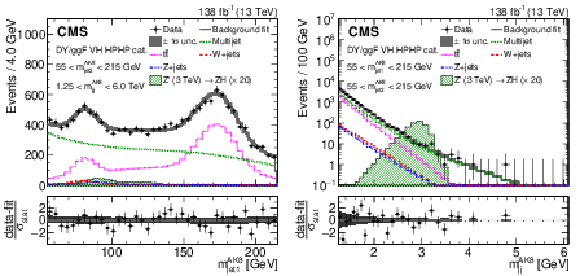
png pdf |
Figure 17:
Search for $ \mathrm{X}\to\mathrm{V} $ (qq) $ \mathrm{H}(\mathrm{b}\mathrm{b}) $: Distributions of (left) the soft drop mass $ m_{\mathrm{SD}} $ variable, labelled as $ m_{\text{jet1}}^{\text{AK8}} $, and (right) the dijet mass $ m_{\mathrm{jj}}^{\mathrm{AK8}} $ in the $ \mathrm{V}(\mathrm{q}\mathrm{q})\mathrm{H}(\mathrm{b}\mathrm{b}) $ channel [111]. The individual contributions of the background model are shown by open histograms with different colours and line styles. The signal of a Z' boson with a mass of 3 TeV decaying via $ \mathrm{Z}\to\text{qq} $ and $ \mathrm{H}\to\mathrm{b}\mathrm{b} $ is also shown, by a green filled histogram. Figure from Ref. [111]. |
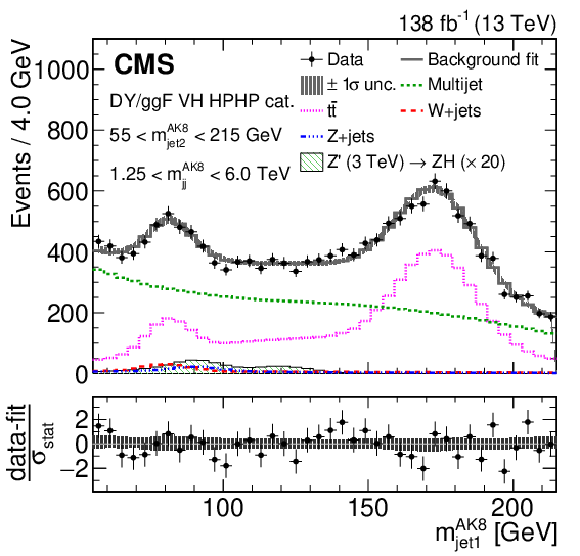
png pdf |
Figure 17-a:
Search for $ \mathrm{X}\to\mathrm{V} $ (qq) $ \mathrm{H}(\mathrm{b}\mathrm{b}) $: Distributions of (left) the soft drop mass $ m_{\mathrm{SD}} $ variable, labelled as $ m_{\text{jet1}}^{\text{AK8}} $, and (right) the dijet mass $ m_{\mathrm{jj}}^{\mathrm{AK8}} $ in the $ \mathrm{V}(\mathrm{q}\mathrm{q})\mathrm{H}(\mathrm{b}\mathrm{b}) $ channel [111]. The individual contributions of the background model are shown by open histograms with different colours and line styles. The signal of a Z' boson with a mass of 3 TeV decaying via $ \mathrm{Z}\to\text{qq} $ and $ \mathrm{H}\to\mathrm{b}\mathrm{b} $ is also shown, by a green filled histogram. Figure from Ref. [111]. |
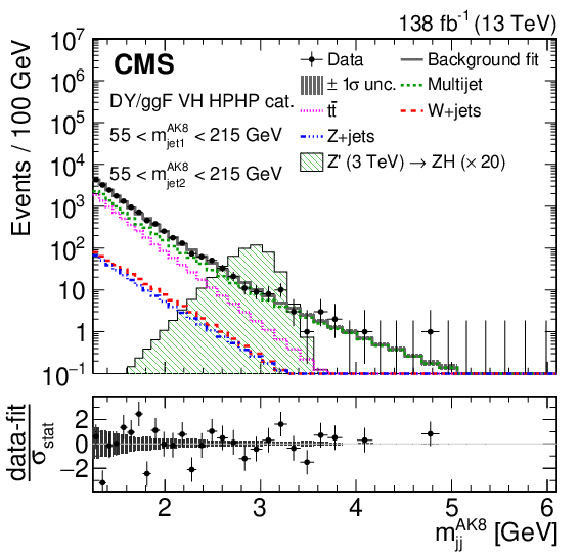
png pdf |
Figure 17-b:
Search for $ \mathrm{X}\to\mathrm{V} $ (qq) $ \mathrm{H}(\mathrm{b}\mathrm{b}) $: Distributions of (left) the soft drop mass $ m_{\mathrm{SD}} $ variable, labelled as $ m_{\text{jet1}}^{\text{AK8}} $, and (right) the dijet mass $ m_{\mathrm{jj}}^{\mathrm{AK8}} $ in the $ \mathrm{V}(\mathrm{q}\mathrm{q})\mathrm{H}(\mathrm{b}\mathrm{b}) $ channel [111]. The individual contributions of the background model are shown by open histograms with different colours and line styles. The signal of a Z' boson with a mass of 3 TeV decaying via $ \mathrm{Z}\to\text{qq} $ and $ \mathrm{H}\to\mathrm{b}\mathrm{b} $ is also shown, by a green filled histogram. Figure from Ref. [111]. |

png pdf |
Figure 18:
Search for $ \mathrm{X}\to\mathrm{H}(\mathrm{b}\mathrm{b})\mathrm{H}(\mathrm{W}\mathrm{W}) $: Distributions of the DNN output for events in the signal nodes of the (upper) SL and (lower) DL categories of the $ \mathrm{H}(\mathrm{b}\mathrm{b})\mathrm{H}(\mathrm{W} \mathrm{W}) $ analysis based on merged and resolved jets [112]. The distributions for a signal of a resonant radion with a mass of 400 GeV is also shown, by an open red histogram. Figure from Ref. [112]. |

png pdf |
Figure 18-a:
Search for $ \mathrm{X}\to\mathrm{H}(\mathrm{b}\mathrm{b})\mathrm{H}(\mathrm{W}\mathrm{W}) $: Distributions of the DNN output for events in the signal nodes of the (upper) SL and (lower) DL categories of the $ \mathrm{H}(\mathrm{b}\mathrm{b})\mathrm{H}(\mathrm{W} \mathrm{W}) $ analysis based on merged and resolved jets [112]. The distributions for a signal of a resonant radion with a mass of 400 GeV is also shown, by an open red histogram. Figure from Ref. [112]. |
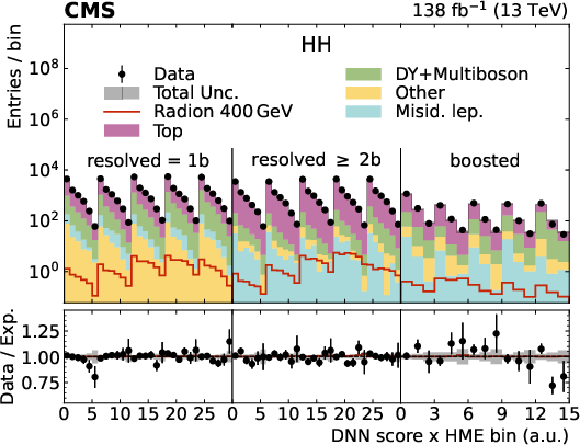
png pdf |
Figure 18-b:
Search for $ \mathrm{X}\to\mathrm{H}(\mathrm{b}\mathrm{b})\mathrm{H}(\mathrm{W}\mathrm{W}) $: Distributions of the DNN output for events in the signal nodes of the (upper) SL and (lower) DL categories of the $ \mathrm{H}(\mathrm{b}\mathrm{b})\mathrm{H}(\mathrm{W} \mathrm{W}) $ analysis based on merged and resolved jets [112]. The distributions for a signal of a resonant radion with a mass of 400 GeV is also shown, by an open red histogram. Figure from Ref. [112]. |
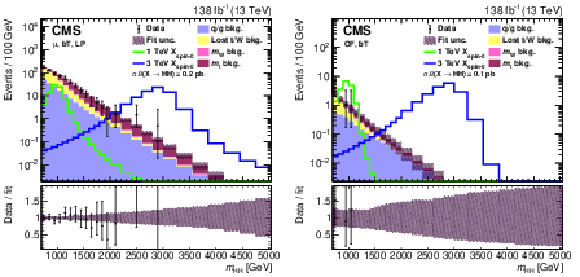
png pdf |
Figure 19:
Search for $ \mathrm{X}\to\mathrm{H}(\mathrm{b}\mathrm{b})\mathrm{H}(\mathrm{W}\mathrm{W}) $: Distributions of the $ m_{{\mathrm{H}\mathrm{H}}} $ variable, in the (left) SL and (right) DL categories of the $ \mathrm{H}(\mathrm{b}\mathrm{b})\mathrm{H}(\mathrm{W}\mathrm{W}) $ analysis with merged jets [113]. Expected signal distributions from a spin-0 resonance with a mass of 1 or 3 TeV are also shown, by the open green and blue histograms. Figure from Ref. [113]. |
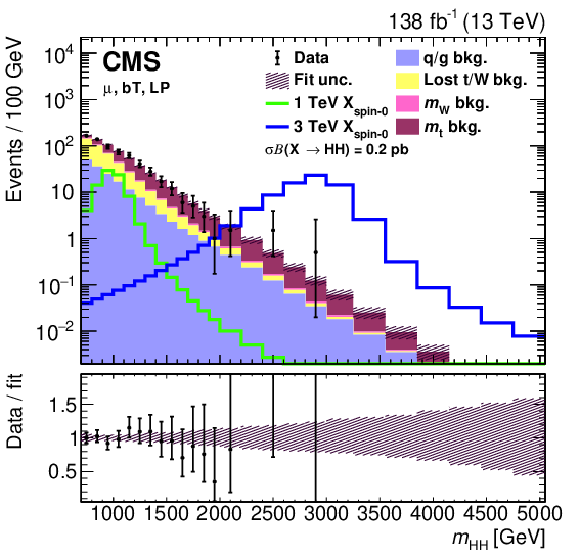
png pdf |
Figure 19-a:
Search for $ \mathrm{X}\to\mathrm{H}(\mathrm{b}\mathrm{b})\mathrm{H}(\mathrm{W}\mathrm{W}) $: Distributions of the $ m_{{\mathrm{H}\mathrm{H}}} $ variable, in the (left) SL and (right) DL categories of the $ \mathrm{H}(\mathrm{b}\mathrm{b})\mathrm{H}(\mathrm{W}\mathrm{W}) $ analysis with merged jets [113]. Expected signal distributions from a spin-0 resonance with a mass of 1 or 3 TeV are also shown, by the open green and blue histograms. Figure from Ref. [113]. |

png pdf |
Figure 19-b:
Search for $ \mathrm{X}\to\mathrm{H}(\mathrm{b}\mathrm{b})\mathrm{H}(\mathrm{W}\mathrm{W}) $: Distributions of the $ m_{{\mathrm{H}\mathrm{H}}} $ variable, in the (left) SL and (right) DL categories of the $ \mathrm{H}(\mathrm{b}\mathrm{b})\mathrm{H}(\mathrm{W}\mathrm{W}) $ analysis with merged jets [113]. Expected signal distributions from a spin-0 resonance with a mass of 1 or 3 TeV are also shown, by the open green and blue histograms. Figure from Ref. [113]. |
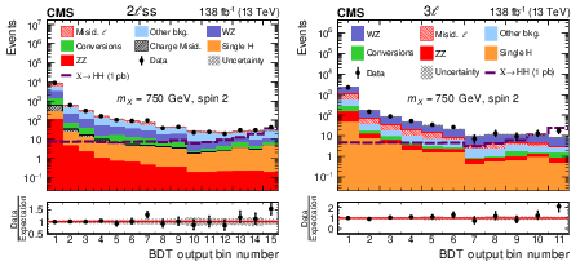
png pdf |
Figure 20:
Search for $ \mathrm{X}\to\mathrm{H}\mathrm{H} $ in multi-lepton final states: Distributions of the BDT classifier output for events in the (left) 2 $ \ell\text{ss} $ and (right) 3 $ \ell $ categories of the $ \mathrm{H}(\mathrm{W}\mathrm{W}+\tau\tau)\mathrm{H}(\mathrm{W}\mathrm{W}+\tau\tau) $ analysis in multilepton final states [114]. The expected signal for a spin-2 resonance with a mass of 750 GeV resonant HH signal is shown, by the open dashed histogram. The signal is normalized to a a cross section of 1\unitpb. The distributions of the estimated background processes and corresponding uncertainties are shown after a fit of the signal plus background hypothesis to the data. Figure from Ref. [114]. |
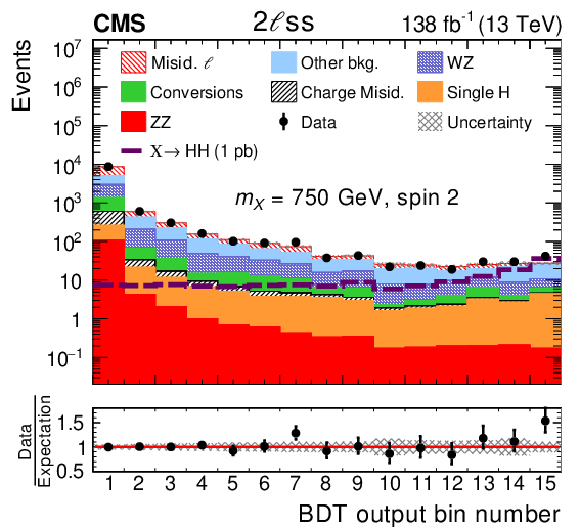
png pdf |
Figure 20-a:
Search for $ \mathrm{X}\to\mathrm{H}\mathrm{H} $ in multi-lepton final states: Distributions of the BDT classifier output for events in the (left) 2 $ \ell\text{ss} $ and (right) 3 $ \ell $ categories of the $ \mathrm{H}(\mathrm{W}\mathrm{W}+\tau\tau)\mathrm{H}(\mathrm{W}\mathrm{W}+\tau\tau) $ analysis in multilepton final states [114]. The expected signal for a spin-2 resonance with a mass of 750 GeV resonant HH signal is shown, by the open dashed histogram. The signal is normalized to a a cross section of 1\unitpb. The distributions of the estimated background processes and corresponding uncertainties are shown after a fit of the signal plus background hypothesis to the data. Figure from Ref. [114]. |

png pdf |
Figure 20-b:
Search for $ \mathrm{X}\to\mathrm{H}\mathrm{H} $ in multi-lepton final states: Distributions of the BDT classifier output for events in the (left) 2 $ \ell\text{ss} $ and (right) 3 $ \ell $ categories of the $ \mathrm{H}(\mathrm{W}\mathrm{W}+\tau\tau)\mathrm{H}(\mathrm{W}\mathrm{W}+\tau\tau) $ analysis in multilepton final states [114]. The expected signal for a spin-2 resonance with a mass of 750 GeV resonant HH signal is shown, by the open dashed histogram. The signal is normalized to a a cross section of 1\unitpb. The distributions of the estimated background processes and corresponding uncertainties are shown after a fit of the signal plus background hypothesis to the data. Figure from Ref. [114]. |

png pdf |
Figure 21:
Search for $ \mathrm{X}\to{\mathrm{Y}}(\mathrm{b}\mathrm{b})\mathrm{H}(\tau\tau) $: Distributions of the NN output scores $ y_{i} $, in different event categories after NN classification, based on a training for a resonance X with $ m_{\mathrm{X}}= $ 500 GeV and a resonance Y with 100 $ \leq m_{{\mathrm{Y}}} < $ 150 GeV in the $ \mathrm{e}\tau_\mathrm{h} $ final state of the $ \mathrm{H}(\tau\tau){\mathrm{Y}}(\mathrm{b}\mathrm{b}) $ analysis [115]. Shown are the (left) $ \tau\tau $ and (right) signal categories. For these figures, the data of all years have been combined. The uncertainty bands correspond to the combination of statistical and systematic uncertainties after the fit of the signal plus background hypothesis for $ m_{\mathrm{X}}= $ 500 GeV and $ m_{{\mathrm{Y}}}= $ 110 GeV to the data. In the lower panels of the figures the (left) purity and (right) fraction of the expected signal over background yields for a signal with a cross section of 200 fb, as well as the ratio of the obtained yields in data over the expectation based on only the background model, are shown. Figure from Ref. [115]. |
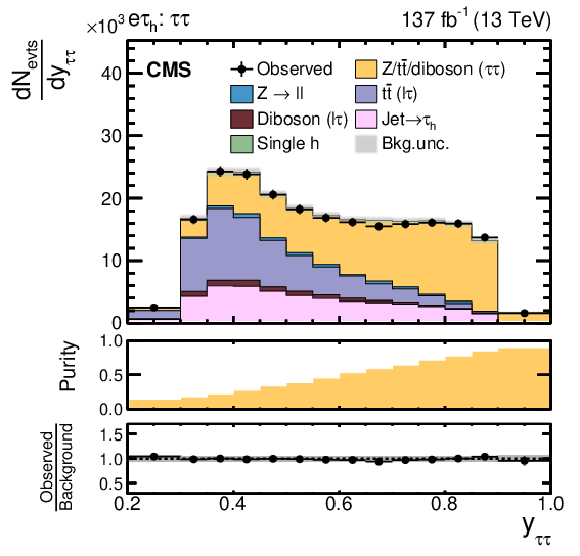
png pdf |
Figure 21-a:
Search for $ \mathrm{X}\to{\mathrm{Y}}(\mathrm{b}\mathrm{b})\mathrm{H}(\tau\tau) $: Distributions of the NN output scores $ y_{i} $, in different event categories after NN classification, based on a training for a resonance X with $ m_{\mathrm{X}}= $ 500 GeV and a resonance Y with 100 $ \leq m_{{\mathrm{Y}}} < $ 150 GeV in the $ \mathrm{e}\tau_\mathrm{h} $ final state of the $ \mathrm{H}(\tau\tau){\mathrm{Y}}(\mathrm{b}\mathrm{b}) $ analysis [115]. Shown are the (left) $ \tau\tau $ and (right) signal categories. For these figures, the data of all years have been combined. The uncertainty bands correspond to the combination of statistical and systematic uncertainties after the fit of the signal plus background hypothesis for $ m_{\mathrm{X}}= $ 500 GeV and $ m_{{\mathrm{Y}}}= $ 110 GeV to the data. In the lower panels of the figures the (left) purity and (right) fraction of the expected signal over background yields for a signal with a cross section of 200 fb, as well as the ratio of the obtained yields in data over the expectation based on only the background model, are shown. Figure from Ref. [115]. |
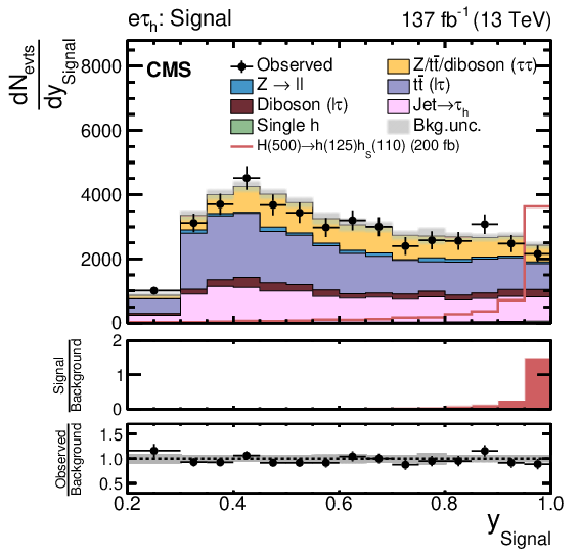
png pdf |
Figure 21-b:
Search for $ \mathrm{X}\to{\mathrm{Y}}(\mathrm{b}\mathrm{b})\mathrm{H}(\tau\tau) $: Distributions of the NN output scores $ y_{i} $, in different event categories after NN classification, based on a training for a resonance X with $ m_{\mathrm{X}}= $ 500 GeV and a resonance Y with 100 $ \leq m_{{\mathrm{Y}}} < $ 150 GeV in the $ \mathrm{e}\tau_\mathrm{h} $ final state of the $ \mathrm{H}(\tau\tau){\mathrm{Y}}(\mathrm{b}\mathrm{b}) $ analysis [115]. Shown are the (left) $ \tau\tau $ and (right) signal categories. For these figures, the data of all years have been combined. The uncertainty bands correspond to the combination of statistical and systematic uncertainties after the fit of the signal plus background hypothesis for $ m_{\mathrm{X}}= $ 500 GeV and $ m_{{\mathrm{Y}}}= $ 110 GeV to the data. In the lower panels of the figures the (left) purity and (right) fraction of the expected signal over background yields for a signal with a cross section of 200 fb, as well as the ratio of the obtained yields in data over the expectation based on only the background model, are shown. Figure from Ref. [115]. |
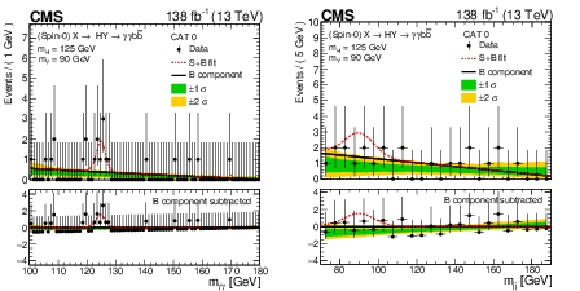
png pdf |
Figure 22:
Search for $ \mathrm{X}\to{\mathrm{Y}} $ (bb) $ \mathrm{H}(\gamma\gamma) $: Marginal distributions of the (left) $ m_{\gamma\gamma} $ and (right) $ m_{\mathrm{jj}} $ variables, in the high-purity SR (labeled ``CAT 0'') of the $ {\mathrm{Y}}(\mathrm{b}\mathrm{b})\mathrm{H}(\gamma\gamma) $ analysis [116]. The figure is shown, for a hypothesis of $ m_{\mathrm{X}}= $ 650 GeV and $ m_{{\mathrm{Y}}}= $ 90 GeV, for which the largest excess of events over the background model is observed. In the lower panels, the numbers of background-subtracted events are shown after the fit of the background model to the data. Figure from Ref. [116]. |

png pdf |
Figure 22-a:
Search for $ \mathrm{X}\to{\mathrm{Y}} $ (bb) $ \mathrm{H}(\gamma\gamma) $: Marginal distributions of the (left) $ m_{\gamma\gamma} $ and (right) $ m_{\mathrm{jj}} $ variables, in the high-purity SR (labeled ``CAT 0'') of the $ {\mathrm{Y}}(\mathrm{b}\mathrm{b})\mathrm{H}(\gamma\gamma) $ analysis [116]. The figure is shown, for a hypothesis of $ m_{\mathrm{X}}= $ 650 GeV and $ m_{{\mathrm{Y}}}= $ 90 GeV, for which the largest excess of events over the background model is observed. In the lower panels, the numbers of background-subtracted events are shown after the fit of the background model to the data. Figure from Ref. [116]. |
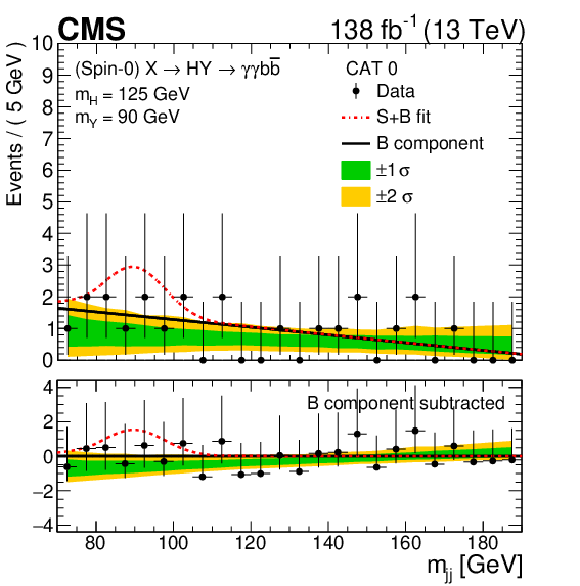
png pdf |
Figure 22-b:
Search for $ \mathrm{X}\to{\mathrm{Y}} $ (bb) $ \mathrm{H}(\gamma\gamma) $: Marginal distributions of the (left) $ m_{\gamma\gamma} $ and (right) $ m_{\mathrm{jj}} $ variables, in the high-purity SR (labeled ``CAT 0'') of the $ {\mathrm{Y}}(\mathrm{b}\mathrm{b})\mathrm{H}(\gamma\gamma) $ analysis [116]. The figure is shown, for a hypothesis of $ m_{\mathrm{X}}= $ 650 GeV and $ m_{{\mathrm{Y}}}= $ 90 GeV, for which the largest excess of events over the background model is observed. In the lower panels, the numbers of background-subtracted events are shown after the fit of the background model to the data. Figure from Ref. [116]. |
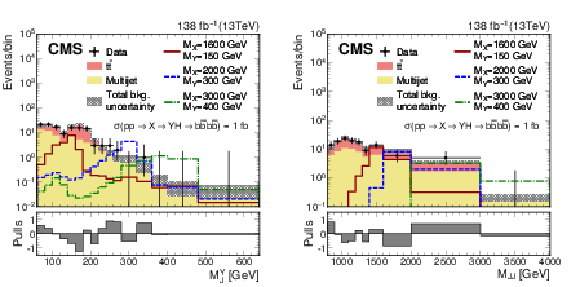
png pdf |
Figure 23:
Search for $ \mathrm{X}\to{\mathrm{Y}}(\mathrm{b}\mathrm{b})\mathrm{H}(\mathrm{b}\mathrm{b}) $: Distributions of the (left) soft-drop mass of the boosted Y candidate, labeled $ M^{\mathrm{Y}}_\text{J} $, and (right) the dijet mass of the Y and H candidates, $ M_\text{JJ} $, in the high-purity SR of the $ {\mathrm{Y}}(\mathrm{b}\mathrm{b})\mathrm{H}(\mathrm{b}\mathrm{b}) $ analysis with two merged $ \mathrm{b}\mathrm{b} $ jets [117]. The distributions as expected for signals with three different values of $ m_{\mathrm{X}} $ and $ m_{{\mathrm{Y}}} $ (labeled $ M^\mathrm{X} $ and $ M^{\mathrm{Y}} $) are also shown. In the lower panels the statistical pull in each bin is displayed. Figure from Ref. [117]. |
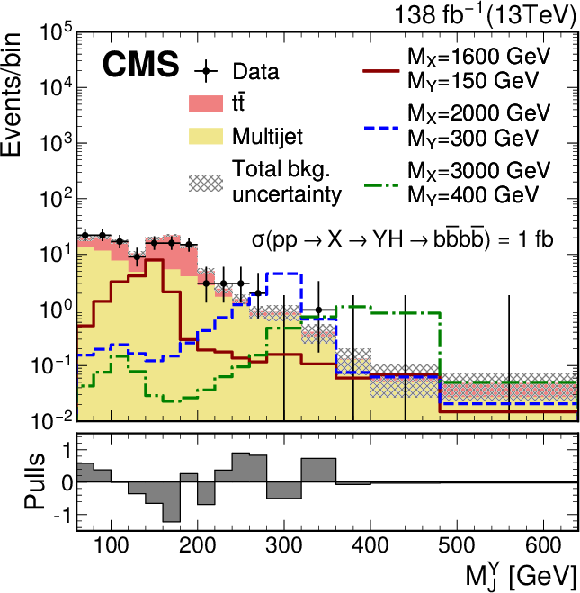
png pdf |
Figure 23-a:
Search for $ \mathrm{X}\to{\mathrm{Y}}(\mathrm{b}\mathrm{b})\mathrm{H}(\mathrm{b}\mathrm{b}) $: Distributions of the (left) soft-drop mass of the boosted Y candidate, labeled $ M^{\mathrm{Y}}_\text{J} $, and (right) the dijet mass of the Y and H candidates, $ M_\text{JJ} $, in the high-purity SR of the $ {\mathrm{Y}}(\mathrm{b}\mathrm{b})\mathrm{H}(\mathrm{b}\mathrm{b}) $ analysis with two merged $ \mathrm{b}\mathrm{b} $ jets [117]. The distributions as expected for signals with three different values of $ m_{\mathrm{X}} $ and $ m_{{\mathrm{Y}}} $ (labeled $ M^\mathrm{X} $ and $ M^{\mathrm{Y}} $) are also shown. In the lower panels the statistical pull in each bin is displayed. Figure from Ref. [117]. |
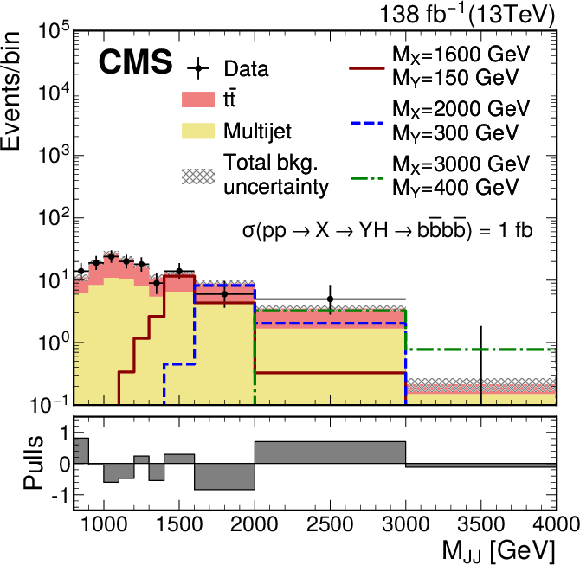
png pdf |
Figure 23-b:
Search for $ \mathrm{X}\to{\mathrm{Y}}(\mathrm{b}\mathrm{b})\mathrm{H}(\mathrm{b}\mathrm{b}) $: Distributions of the (left) soft-drop mass of the boosted Y candidate, labeled $ M^{\mathrm{Y}}_\text{J} $, and (right) the dijet mass of the Y and H candidates, $ M_\text{JJ} $, in the high-purity SR of the $ {\mathrm{Y}}(\mathrm{b}\mathrm{b})\mathrm{H}(\mathrm{b}\mathrm{b}) $ analysis with two merged $ \mathrm{b}\mathrm{b} $ jets [117]. The distributions as expected for signals with three different values of $ m_{\mathrm{X}} $ and $ m_{{\mathrm{Y}}} $ (labeled $ M^\mathrm{X} $ and $ M^{\mathrm{Y}} $) are also shown. In the lower panels the statistical pull in each bin is displayed. Figure from Ref. [117]. |
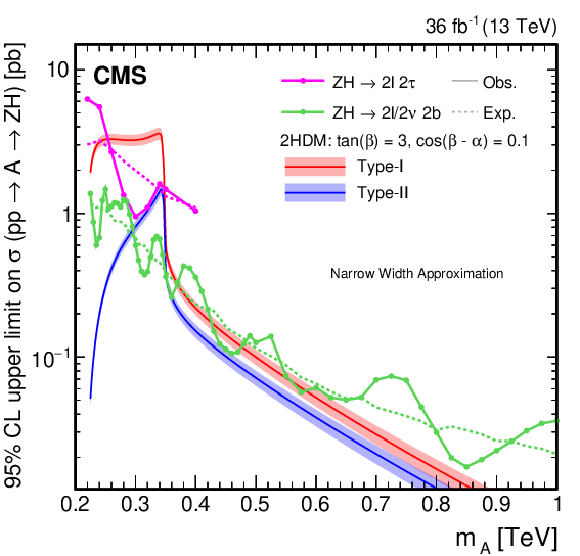
png pdf |
Figure 24:
Search for $ \mathrm{X}\to\mathrm{Z}\mathrm{H} $: Observed and expected 95% CL upper limits on the product of the cross section $ \sigma $ for the production of an $ {\mathrm{A}} $ boson, via gluon-gluon fusion and the branching fraction $ \mathcal{B} $ for the $ {\mathrm{A}}\to\mathrm{Z}\mathrm{H} $ decay. The limits are given in \unitpb as functions of $ m_{{\mathrm{A}}} $. The markers connected with solid lines (dashed lines) indicate the observed (expected) limits. The green (magenta) lines refer to the $ \mathrm{Z}(\ell\ell+\nu\nu)\mathrm{H}(\mathrm{b}\mathrm{b}) $ [108] ($ \mathrm{Z}(\ell\ell)\mathrm{H}(\tau\tau ) $ [107]) analysis. The red and blue solid lines indicate the product $ \sigma\mathcal{B} $ as expected by the 2HDM Type I and Type II models, respectively, for the parameters $ \tan\beta= $ 3 and $ \cos(\beta-\alpha)= $ 0.1. The shaded areas associated with these predictions indicate the corresponding model uncertainties. The results and model predictions have been adapted from Refs. [108,107]. |
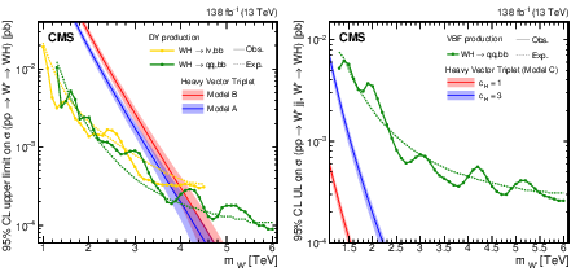
png pdf |
Figure 25:
Search for $ \mathrm{X}\to\mathrm{W}\mathrm{H} $: Observed and expected 95% CL upper limits on the product of the cross section $ \sigma $ for the production of a W' spin-1 resonance, via (left) DY production or (right) vector boson fusion and the branching fraction $ \mathcal{B} $ for the $ \mathrm{W^{'}}\to\mathrm{W}\mathrm{H} $ decay. The solid lines represent the observed and the dotted lines the expected limits. The theory predictions from the heavy vector triplet models A, B, and C are also shown. |

png pdf |
Figure 25-a:
Search for $ \mathrm{X}\to\mathrm{W}\mathrm{H} $: Observed and expected 95% CL upper limits on the product of the cross section $ \sigma $ for the production of a W' spin-1 resonance, via (left) DY production or (right) vector boson fusion and the branching fraction $ \mathcal{B} $ for the $ \mathrm{W^{'}}\to\mathrm{W}\mathrm{H} $ decay. The solid lines represent the observed and the dotted lines the expected limits. The theory predictions from the heavy vector triplet models A, B, and C are also shown. |
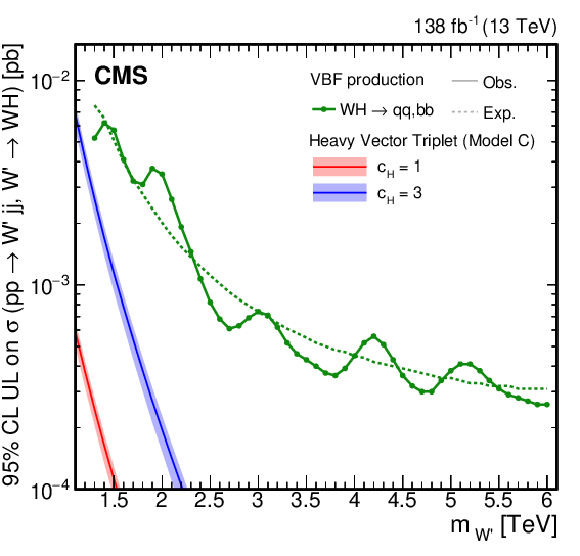
png pdf |
Figure 25-b:
Search for $ \mathrm{X}\to\mathrm{W}\mathrm{H} $: Observed and expected 95% CL upper limits on the product of the cross section $ \sigma $ for the production of a W' spin-1 resonance, via (left) DY production or (right) vector boson fusion and the branching fraction $ \mathcal{B} $ for the $ \mathrm{W^{'}}\to\mathrm{W}\mathrm{H} $ decay. The solid lines represent the observed and the dotted lines the expected limits. The theory predictions from the heavy vector triplet models A, B, and C are also shown. |

png pdf |
Figure 26:
Search for $ \mathrm{X}\to\mathrm{Z}\mathrm{H} $: Observed and expected 95% CL upper limits on the product of the cross section $ \sigma $ for the production of a Z' spin-1 resonance, via (left) DY production or (right) vector boson fusion and the branching fraction $ \mathcal{B} $ for the $ \mathrm{Z}^{'}\to\mathrm{Z}\mathrm{H} $ decay. The solid lines represent the observed and the dotted lines the expected limits. The theory predictions from the heavy vector triplet models A, B and C are also shown. |

png pdf |
Figure 26-a:
Search for $ \mathrm{X}\to\mathrm{Z}\mathrm{H} $: Observed and expected 95% CL upper limits on the product of the cross section $ \sigma $ for the production of a Z' spin-1 resonance, via (left) DY production or (right) vector boson fusion and the branching fraction $ \mathcal{B} $ for the $ \mathrm{Z}^{'}\to\mathrm{Z}\mathrm{H} $ decay. The solid lines represent the observed and the dotted lines the expected limits. The theory predictions from the heavy vector triplet models A, B and C are also shown. |

png pdf |
Figure 26-b:
Search for $ \mathrm{X}\to\mathrm{Z}\mathrm{H} $: Observed and expected 95% CL upper limits on the product of the cross section $ \sigma $ for the production of a Z' spin-1 resonance, via (left) DY production or (right) vector boson fusion and the branching fraction $ \mathcal{B} $ for the $ \mathrm{Z}^{'}\to\mathrm{Z}\mathrm{H} $ decay. The solid lines represent the observed and the dotted lines the expected limits. The theory predictions from the heavy vector triplet models A, B and C are also shown. |

png pdf |
Figure 27:
Search for $ \mathrm{X}\to\mathrm{H}\mathrm{H} $/$ {\mathrm{G}} \to\mathrm{H}\mathrm{H} $: Observed and expected 95% CL upper limits on the product of the cross section $ \sigma $ for the production of a (left) spin-0 resonance X and (right) a spin-2 resonance G, via gluon-gluon fusion and the branching fraction $ \mathcal{B} $ for the corresponding HH decay. The results of the individual analyses presented in this report and the result of their combined likelihood analysis are shown. The observed limits are indicated by markers connected with solid lines and the expected limits by dashed lines. |
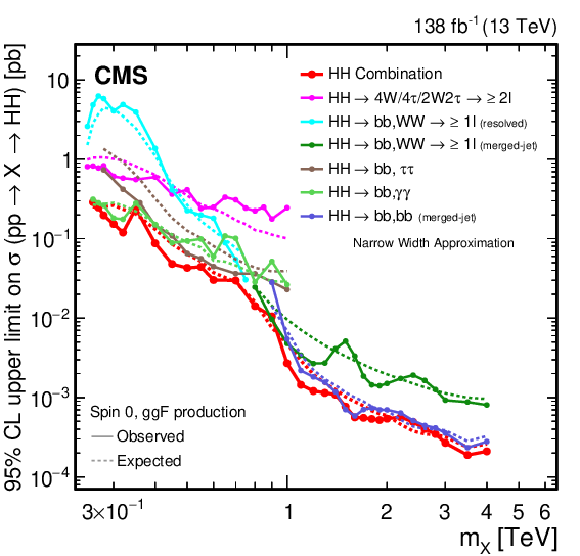
png pdf |
Figure 27-a:
Search for $ \mathrm{X}\to\mathrm{H}\mathrm{H} $/$ {\mathrm{G}} \to\mathrm{H}\mathrm{H} $: Observed and expected 95% CL upper limits on the product of the cross section $ \sigma $ for the production of a (left) spin-0 resonance X and (right) a spin-2 resonance G, via gluon-gluon fusion and the branching fraction $ \mathcal{B} $ for the corresponding HH decay. The results of the individual analyses presented in this report and the result of their combined likelihood analysis are shown. The observed limits are indicated by markers connected with solid lines and the expected limits by dashed lines. |

png pdf |
Figure 27-b:
Search for $ \mathrm{X}\to\mathrm{H}\mathrm{H} $/$ {\mathrm{G}} \to\mathrm{H}\mathrm{H} $: Observed and expected 95% CL upper limits on the product of the cross section $ \sigma $ for the production of a (left) spin-0 resonance X and (right) a spin-2 resonance G, via gluon-gluon fusion and the branching fraction $ \mathcal{B} $ for the corresponding HH decay. The results of the individual analyses presented in this report and the result of their combined likelihood analysis are shown. The observed limits are indicated by markers connected with solid lines and the expected limits by dashed lines. |
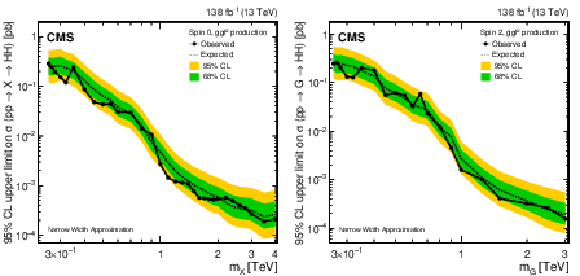
png pdf |
Figure 28:
Search for $ \mathrm{X}\to\mathrm{H}\mathrm{H} $/$ {\mathrm{G}} \to\mathrm{H}\mathrm{H} $: Observed and expected 95% CL upper limits on the product of the cross section $ \sigma $ for the production of a (left) spin-0 resonance X and (right) a spin-2 resonance G, via gluon-gluon fusion, and the branching fraction $ \mathcal{B} $ for the corresponding HH decay, as obtained from the combined likelihood analysis of all contributing individual analyses presented in this report and shown in Fig. 27. In addition to the limit from the combined likelihood analysis the 68 and 95% central intervals for the expected upper limits in the absence of a signal are shown as coloured bands. |
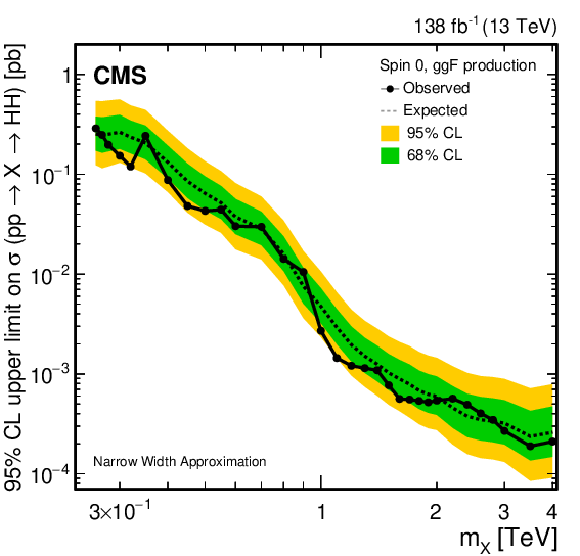
png pdf |
Figure 28-a:
Search for $ \mathrm{X}\to\mathrm{H}\mathrm{H} $/$ {\mathrm{G}} \to\mathrm{H}\mathrm{H} $: Observed and expected 95% CL upper limits on the product of the cross section $ \sigma $ for the production of a (left) spin-0 resonance X and (right) a spin-2 resonance G, via gluon-gluon fusion, and the branching fraction $ \mathcal{B} $ for the corresponding HH decay, as obtained from the combined likelihood analysis of all contributing individual analyses presented in this report and shown in Fig. 27. In addition to the limit from the combined likelihood analysis the 68 and 95% central intervals for the expected upper limits in the absence of a signal are shown as coloured bands. |
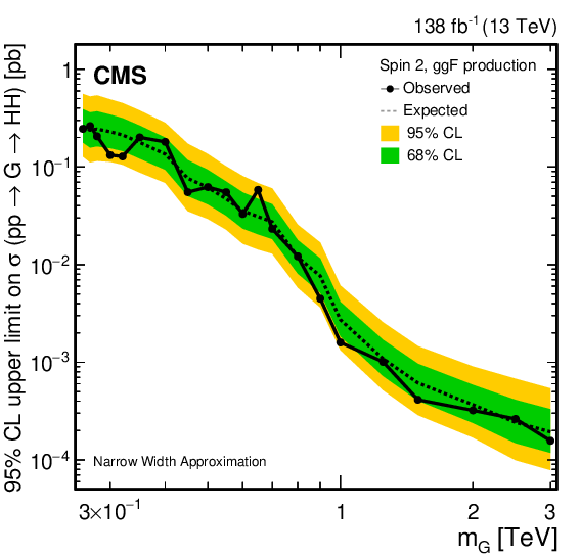
png pdf |
Figure 28-b:
Search for $ \mathrm{X}\to\mathrm{H}\mathrm{H} $/$ {\mathrm{G}} \to\mathrm{H}\mathrm{H} $: Observed and expected 95% CL upper limits on the product of the cross section $ \sigma $ for the production of a (left) spin-0 resonance X and (right) a spin-2 resonance G, via gluon-gluon fusion, and the branching fraction $ \mathcal{B} $ for the corresponding HH decay, as obtained from the combined likelihood analysis of all contributing individual analyses presented in this report and shown in Fig. 27. In addition to the limit from the combined likelihood analysis the 68 and 95% central intervals for the expected upper limits in the absence of a signal are shown as coloured bands. |
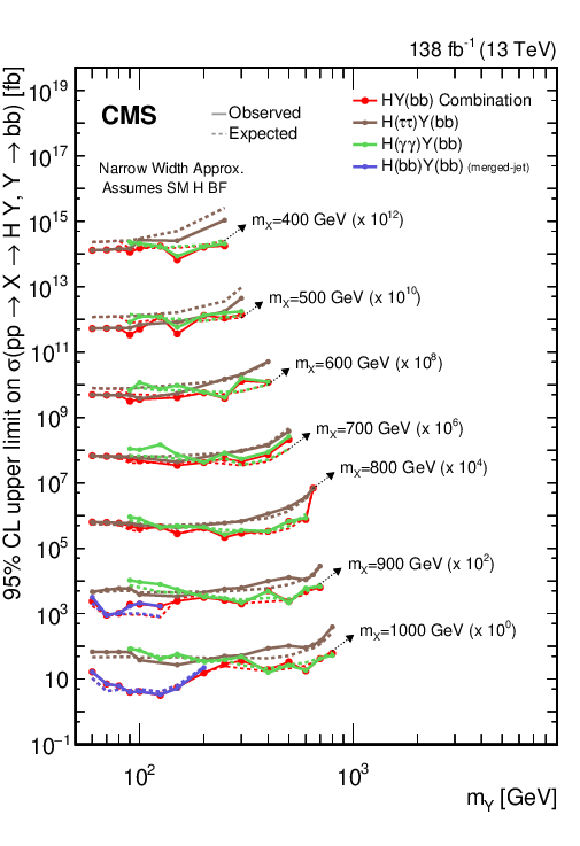
png pdf |
Figure 29:
Search for $ \mathrm{X}\to{\mathrm{Y}}\mathrm{H} $: Observed and expected upper limits, at 95% CL, on the product of the cross section $ \sigma $ for the production of a resonance X via gluon-gluon fusion and the branching fraction $ \mathcal{B} $ for the $ \mathrm{X}\to{\mathrm{Y}}(\mathrm{b}\mathrm{b}) \mathrm{H} $ decay. For the branching fractions of the $ \mathrm{H}\to\tau\tau $, $ \mathrm{H}\to\gamma\gamma $ and $ \mathrm{H}\to\mathrm{b}\mathrm{b} $ decays, the SM values are assumed. The results derived from the individual analyses presented in this report and the result of their combined likelihood analysis are shown as functions of $ m_{{\mathrm{Y}}} $ and $ m_{\mathrm{X}} $ for $ m_{\mathrm{X}}\le $ 1 TeV. Observed limits are indicated by markers connected with solid lines, expected limits by dashed lines. For presentation purposes, the limits have been scaled in successive steps by two orders of magnitude, each. For each set of graphs, a black arrow points to the $ m_{\mathrm{X}} $ related legend. |

png pdf |
Figure 30:
Search for $ \mathrm{X}\to{\mathrm{Y}}\mathrm{H} $: Observed and expected upper limits, at 95% CL, on the product of the cross section $ \sigma $ for the production of a resonance X via gluon-gluon fusion and the branching fraction $ \mathcal{B} $ for the $ \mathrm{X}\to{\mathrm{Y}}(\mathrm{b}\mathrm{b}) \mathrm{H} $ decay. For the branching fractions of the $ \mathrm{H}\to\tau\tau $ and $ \mathrm{H}\to\mathrm{b}\mathrm{b} $ decays, the SM values are assumed. The results derived from the individual analyses presented in this report and the result of their combined likelihood analysis are shown as functions of $ m_{{\mathrm{Y}}} $ and $ m_{\mathrm{X}} $ for $ m_{\mathrm{X}}\ge $ 1.2 TeV. Observed limits are indicated by markers connected with solid lines, expected limits by dashed lines. For presentation purposes, the limits have been scaled in successive steps by four orders of magnitude, each. For each set of graphs, a black arrow points to the $ m_{\mathrm{X}} $ related legend. |
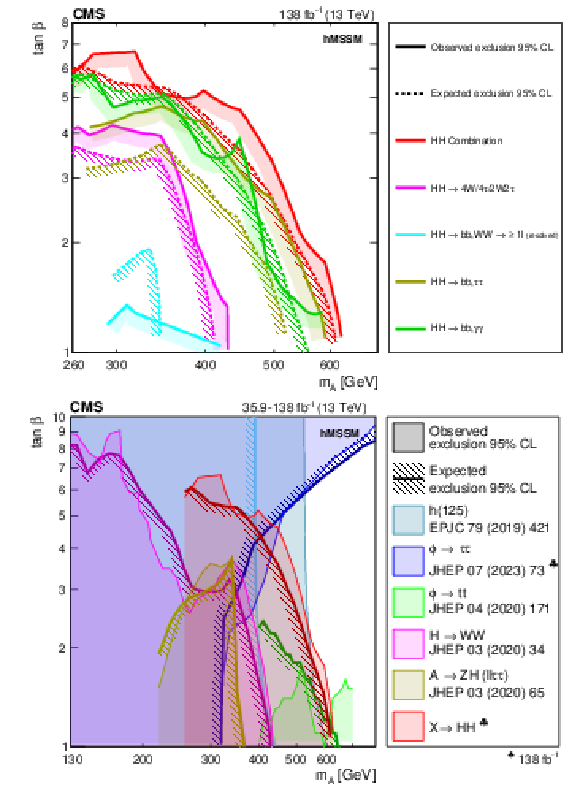
png pdf |
Figure 31:
Interpretation of the results from the searches for the $ \mathrm{X}\to{\mathrm{H}\mathrm{H}} $ decay, in the hMSSM model. In the upper part of the figure, the observed and expected exclusion contours at 95% CL, in the ($ m_{{\mathrm{A}}} $, $ \tan\beta $) plane, from the individual HH analyses presented in this report and their combined likelihood analysis are shown. In the lower part of the figure, a comparison of the region excluded by the combined likelihood analysis shown in the upper part of the figure with selected results from other searches for the production of heavy scalar bosons in the hMSSM, in $ \tau\tau $ [64], $ \mathrm{t} \overline{\mathrm{t}} $ [169] and WW [170] decays is shown. Also shown, are the results from one representative search for $ {\mathrm{A}}\to\mathrm{Z}\mathrm{H} $ [107] and indirect constraints obtained from measurements of the coupling strength of the observed H boson [47]. Results not marked by a club symbol are based on an integrated luminosity of 35.9 fb$^{-1}$. |
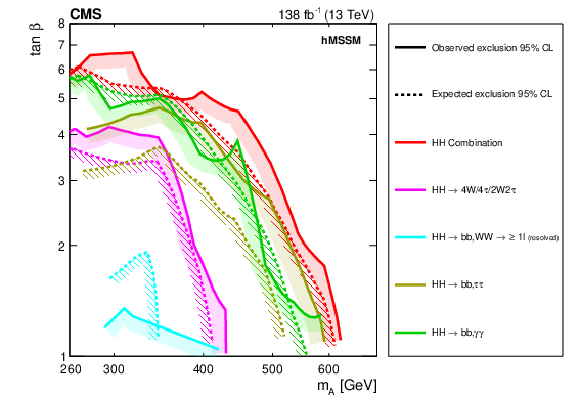
png pdf |
Figure 31-a:
Interpretation of the results from the searches for the $ \mathrm{X}\to{\mathrm{H}\mathrm{H}} $ decay, in the hMSSM model. In the upper part of the figure, the observed and expected exclusion contours at 95% CL, in the ($ m_{{\mathrm{A}}} $, $ \tan\beta $) plane, from the individual HH analyses presented in this report and their combined likelihood analysis are shown. In the lower part of the figure, a comparison of the region excluded by the combined likelihood analysis shown in the upper part of the figure with selected results from other searches for the production of heavy scalar bosons in the hMSSM, in $ \tau\tau $ [64], $ \mathrm{t} \overline{\mathrm{t}} $ [169] and WW [170] decays is shown. Also shown, are the results from one representative search for $ {\mathrm{A}}\to\mathrm{Z}\mathrm{H} $ [107] and indirect constraints obtained from measurements of the coupling strength of the observed H boson [47]. Results not marked by a club symbol are based on an integrated luminosity of 35.9 fb$^{-1}$. |

png pdf |
Figure 31-b:
Interpretation of the results from the searches for the $ \mathrm{X}\to{\mathrm{H}\mathrm{H}} $ decay, in the hMSSM model. In the upper part of the figure, the observed and expected exclusion contours at 95% CL, in the ($ m_{{\mathrm{A}}} $, $ \tan\beta $) plane, from the individual HH analyses presented in this report and their combined likelihood analysis are shown. In the lower part of the figure, a comparison of the region excluded by the combined likelihood analysis shown in the upper part of the figure with selected results from other searches for the production of heavy scalar bosons in the hMSSM, in $ \tau\tau $ [64], $ \mathrm{t} \overline{\mathrm{t}} $ [169] and WW [170] decays is shown. Also shown, are the results from one representative search for $ {\mathrm{A}}\to\mathrm{Z}\mathrm{H} $ [107] and indirect constraints obtained from measurements of the coupling strength of the observed H boson [47]. Results not marked by a club symbol are based on an integrated luminosity of 35.9 fb$^{-1}$. |
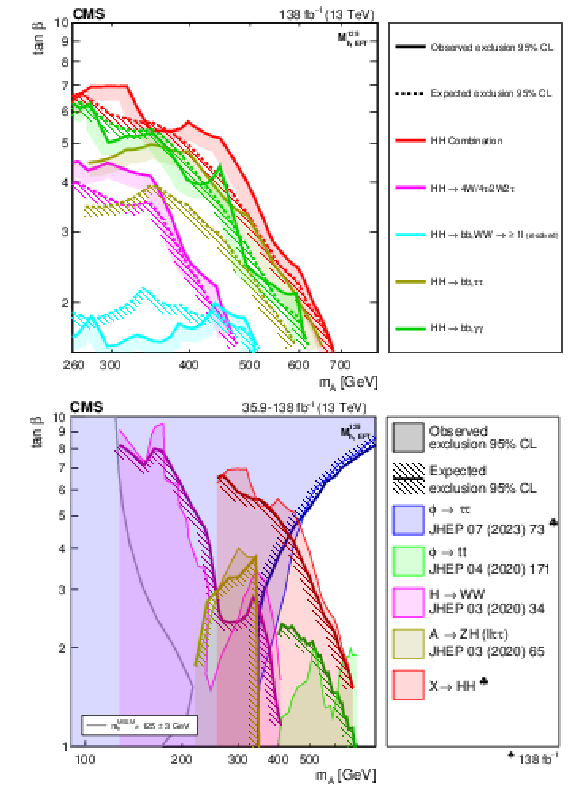
png pdf |
Figure 32:
Interpretation of the results from the searches for the $ \mathrm{X}\to{\mathrm{H}\mathrm{H}} $ decay, in the $ M^{125}_{\text{h,EFT}} $ benchmark scenario. In the upper part of the figure, the observed and expected exclusion contours at 95% CL are shown, in the ($ m_{{\mathrm{A}}} $, $ \tan\beta $) plane from the individual HH analyses presented in this report and their combined likelihood analysis. In the lower part of the figure, a comparison of the region excluded by the combined likelihood analysis shown in the upper part of the figure with selected results from other searches for the production of heavy scalar bosons in the $ M^{125}_{\text{h,EFT}} $ scenario, in $ \tau\tau $ [64], $ \mathrm{t} \overline{\mathrm{t}} $ [169] and WW [170] decays is shown. Also shown, are the results from one representative search for $ {\mathrm{A}}\to\mathrm{Z}\mathrm{H} $ [107]. The parameter region in which the mass of the lightest MSSM Higgs boson does not coincide with 125 GeV within a 3 GeV margin is indicated by the dark hatched area. Results not marked by a club symbol are based on an integrated luminosity of 35.9 fb$^{-1}$. |
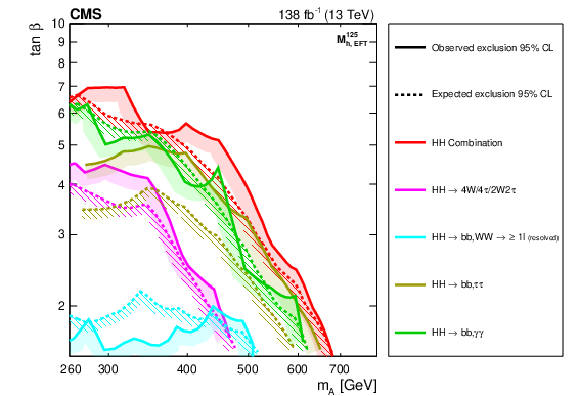
png pdf |
Figure 32-a:
Interpretation of the results from the searches for the $ \mathrm{X}\to{\mathrm{H}\mathrm{H}} $ decay, in the $ M^{125}_{\text{h,EFT}} $ benchmark scenario. In the upper part of the figure, the observed and expected exclusion contours at 95% CL are shown, in the ($ m_{{\mathrm{A}}} $, $ \tan\beta $) plane from the individual HH analyses presented in this report and their combined likelihood analysis. In the lower part of the figure, a comparison of the region excluded by the combined likelihood analysis shown in the upper part of the figure with selected results from other searches for the production of heavy scalar bosons in the $ M^{125}_{\text{h,EFT}} $ scenario, in $ \tau\tau $ [64], $ \mathrm{t} \overline{\mathrm{t}} $ [169] and WW [170] decays is shown. Also shown, are the results from one representative search for $ {\mathrm{A}}\to\mathrm{Z}\mathrm{H} $ [107]. The parameter region in which the mass of the lightest MSSM Higgs boson does not coincide with 125 GeV within a 3 GeV margin is indicated by the dark hatched area. Results not marked by a club symbol are based on an integrated luminosity of 35.9 fb$^{-1}$. |
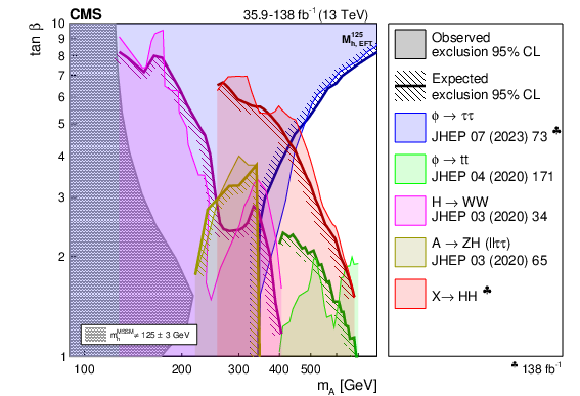
png pdf |
Figure 32-b:
Interpretation of the results from the searches for the $ \mathrm{X}\to{\mathrm{H}\mathrm{H}} $ decay, in the $ M^{125}_{\text{h,EFT}} $ benchmark scenario. In the upper part of the figure, the observed and expected exclusion contours at 95% CL are shown, in the ($ m_{{\mathrm{A}}} $, $ \tan\beta $) plane from the individual HH analyses presented in this report and their combined likelihood analysis. In the lower part of the figure, a comparison of the region excluded by the combined likelihood analysis shown in the upper part of the figure with selected results from other searches for the production of heavy scalar bosons in the $ M^{125}_{\text{h,EFT}} $ scenario, in $ \tau\tau $ [64], $ \mathrm{t} \overline{\mathrm{t}} $ [169] and WW [170] decays is shown. Also shown, are the results from one representative search for $ {\mathrm{A}}\to\mathrm{Z}\mathrm{H} $ [107]. The parameter region in which the mass of the lightest MSSM Higgs boson does not coincide with 125 GeV within a 3 GeV margin is indicated by the dark hatched area. Results not marked by a club symbol are based on an integrated luminosity of 35.9 fb$^{-1}$. |
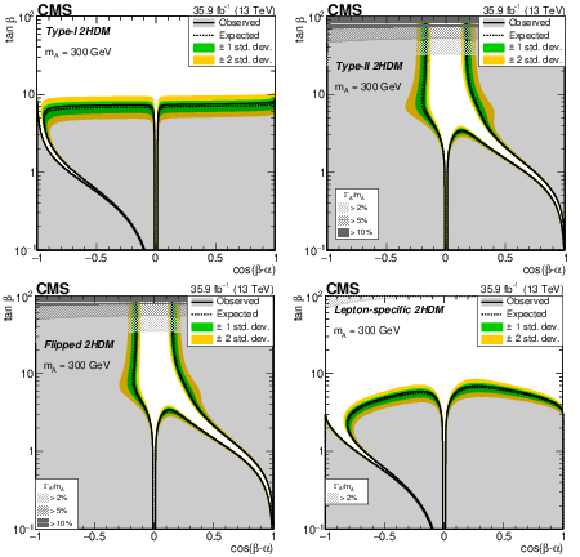
png pdf |
Figure 33:
Interpretation of the results of the $ {\mathrm{A}}\to\mathrm{Z}\mathrm{H}(\mathrm{b}\mathrm{b}) $ analysis [108], in the (upper left) Type I, (upper right) Type II, (lower left) flipped, and (lower right) lepton-specific 2HDM models. In each case observed and expected exclusion contours at 95% CL, in the plane defined by $ \cos(\beta-\alpha) $ and $ \tan\beta $, are shown. The excluded regions are represented by the shaded gray areas. The 68 and 95% central intervals of the expected exclusion contours in the absence of a signal are indicated by the green and yellow bands. Contours are derived from the projection on the corresponding 2HDM parameter space for $ m_{{\mathrm{A}}} = $ 300 GeV. The regions of parameter space where the natural width of the $ {\mathrm{A}} $ boson $ \Gamma_{\mathrm{A}} $ is comparable to or larger than the experimental resolution and thus the narrow-width approximation is not valid are represented by hatched gray areas. Figure from Ref. [108]. |

png pdf |
Figure 33-a:
Interpretation of the results of the $ {\mathrm{A}}\to\mathrm{Z}\mathrm{H}(\mathrm{b}\mathrm{b}) $ analysis [108], in the (upper left) Type I, (upper right) Type II, (lower left) flipped, and (lower right) lepton-specific 2HDM models. In each case observed and expected exclusion contours at 95% CL, in the plane defined by $ \cos(\beta-\alpha) $ and $ \tan\beta $, are shown. The excluded regions are represented by the shaded gray areas. The 68 and 95% central intervals of the expected exclusion contours in the absence of a signal are indicated by the green and yellow bands. Contours are derived from the projection on the corresponding 2HDM parameter space for $ m_{{\mathrm{A}}} = $ 300 GeV. The regions of parameter space where the natural width of the $ {\mathrm{A}} $ boson $ \Gamma_{\mathrm{A}} $ is comparable to or larger than the experimental resolution and thus the narrow-width approximation is not valid are represented by hatched gray areas. Figure from Ref. [108]. |
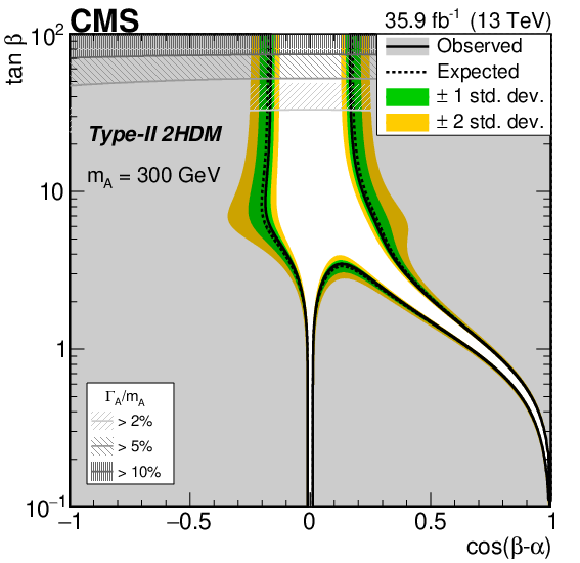
png pdf |
Figure 33-b:
Interpretation of the results of the $ {\mathrm{A}}\to\mathrm{Z}\mathrm{H}(\mathrm{b}\mathrm{b}) $ analysis [108], in the (upper left) Type I, (upper right) Type II, (lower left) flipped, and (lower right) lepton-specific 2HDM models. In each case observed and expected exclusion contours at 95% CL, in the plane defined by $ \cos(\beta-\alpha) $ and $ \tan\beta $, are shown. The excluded regions are represented by the shaded gray areas. The 68 and 95% central intervals of the expected exclusion contours in the absence of a signal are indicated by the green and yellow bands. Contours are derived from the projection on the corresponding 2HDM parameter space for $ m_{{\mathrm{A}}} = $ 300 GeV. The regions of parameter space where the natural width of the $ {\mathrm{A}} $ boson $ \Gamma_{\mathrm{A}} $ is comparable to or larger than the experimental resolution and thus the narrow-width approximation is not valid are represented by hatched gray areas. Figure from Ref. [108]. |
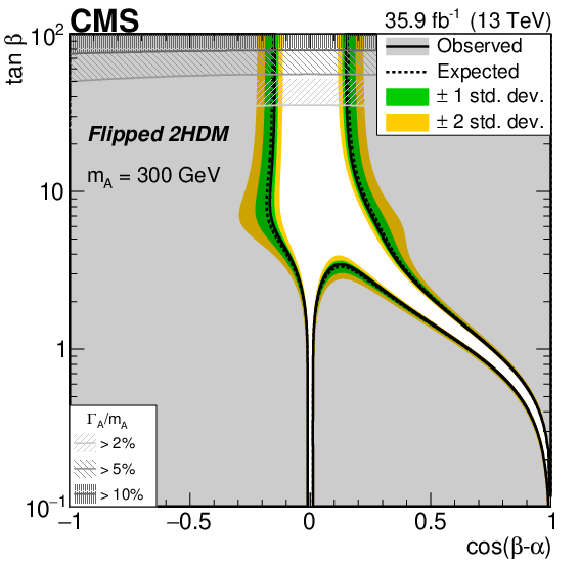
png pdf |
Figure 33-c:
Interpretation of the results of the $ {\mathrm{A}}\to\mathrm{Z}\mathrm{H}(\mathrm{b}\mathrm{b}) $ analysis [108], in the (upper left) Type I, (upper right) Type II, (lower left) flipped, and (lower right) lepton-specific 2HDM models. In each case observed and expected exclusion contours at 95% CL, in the plane defined by $ \cos(\beta-\alpha) $ and $ \tan\beta $, are shown. The excluded regions are represented by the shaded gray areas. The 68 and 95% central intervals of the expected exclusion contours in the absence of a signal are indicated by the green and yellow bands. Contours are derived from the projection on the corresponding 2HDM parameter space for $ m_{{\mathrm{A}}} = $ 300 GeV. The regions of parameter space where the natural width of the $ {\mathrm{A}} $ boson $ \Gamma_{\mathrm{A}} $ is comparable to or larger than the experimental resolution and thus the narrow-width approximation is not valid are represented by hatched gray areas. Figure from Ref. [108]. |
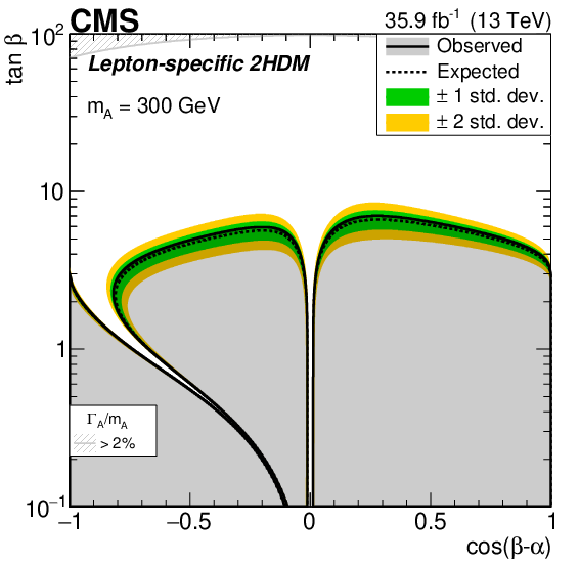
png pdf |
Figure 33-d:
Interpretation of the results of the $ {\mathrm{A}}\to\mathrm{Z}\mathrm{H}(\mathrm{b}\mathrm{b}) $ analysis [108], in the (upper left) Type I, (upper right) Type II, (lower left) flipped, and (lower right) lepton-specific 2HDM models. In each case observed and expected exclusion contours at 95% CL, in the plane defined by $ \cos(\beta-\alpha) $ and $ \tan\beta $, are shown. The excluded regions are represented by the shaded gray areas. The 68 and 95% central intervals of the expected exclusion contours in the absence of a signal are indicated by the green and yellow bands. Contours are derived from the projection on the corresponding 2HDM parameter space for $ m_{{\mathrm{A}}} = $ 300 GeV. The regions of parameter space where the natural width of the $ {\mathrm{A}} $ boson $ \Gamma_{\mathrm{A}} $ is comparable to or larger than the experimental resolution and thus the narrow-width approximation is not valid are represented by hatched gray areas. Figure from Ref. [108]. |
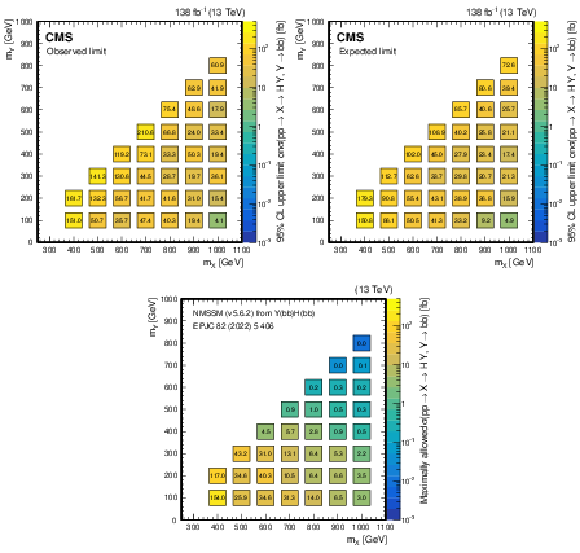
png pdf |
Figure 34:
(Upper left) Observed and (upper right) expected upper limits at 95% CL, on the product of the cross section $ \sigma $ for the production of a resonance X via gluon-gluon fusion and the branching fraction $ \mathcal{B} $ for the $ \mathrm{X}\to{\mathrm{Y}}(\mathrm{b}\mathrm{b})\mathrm{H} $ decay, as obtained from a combined likelihood analysis of the individual analyses presented in this report and shown in Fig. 29. The results are presented in a plane defined by $ m_{\mathrm{X}} $ and $ m_{{\mathrm{Y}}} $. The limits have been evaluated in discrete steps corresponding to the centers of the boxes. The numbers in the boxes are given in fb. The corresponding maximally allowed values of $ \sigma\mathcal{B} $ in the NMSSM are also shown for comparison (lower plot), as adapted from Ref. [193]. |
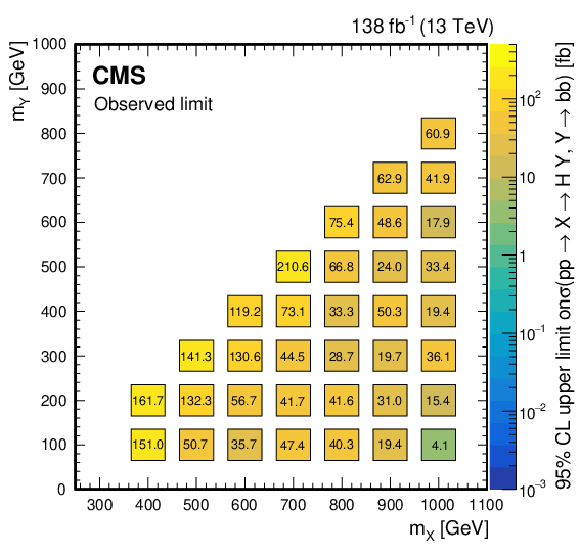
png pdf |
Figure 34-a:
(Upper left) Observed and (upper right) expected upper limits at 95% CL, on the product of the cross section $ \sigma $ for the production of a resonance X via gluon-gluon fusion and the branching fraction $ \mathcal{B} $ for the $ \mathrm{X}\to{\mathrm{Y}}(\mathrm{b}\mathrm{b})\mathrm{H} $ decay, as obtained from a combined likelihood analysis of the individual analyses presented in this report and shown in Fig. 29. The results are presented in a plane defined by $ m_{\mathrm{X}} $ and $ m_{{\mathrm{Y}}} $. The limits have been evaluated in discrete steps corresponding to the centers of the boxes. The numbers in the boxes are given in fb. The corresponding maximally allowed values of $ \sigma\mathcal{B} $ in the NMSSM are also shown for comparison (lower plot), as adapted from Ref. [193]. |

png pdf |
Figure 34-b:
(Upper left) Observed and (upper right) expected upper limits at 95% CL, on the product of the cross section $ \sigma $ for the production of a resonance X via gluon-gluon fusion and the branching fraction $ \mathcal{B} $ for the $ \mathrm{X}\to{\mathrm{Y}}(\mathrm{b}\mathrm{b})\mathrm{H} $ decay, as obtained from a combined likelihood analysis of the individual analyses presented in this report and shown in Fig. 29. The results are presented in a plane defined by $ m_{\mathrm{X}} $ and $ m_{{\mathrm{Y}}} $. The limits have been evaluated in discrete steps corresponding to the centers of the boxes. The numbers in the boxes are given in fb. The corresponding maximally allowed values of $ \sigma\mathcal{B} $ in the NMSSM are also shown for comparison (lower plot), as adapted from Ref. [193]. |
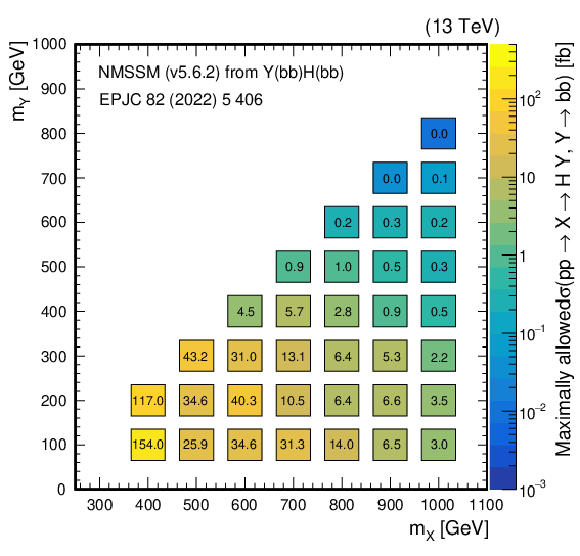
png pdf |
Figure 34-c:
(Upper left) Observed and (upper right) expected upper limits at 95% CL, on the product of the cross section $ \sigma $ for the production of a resonance X via gluon-gluon fusion and the branching fraction $ \mathcal{B} $ for the $ \mathrm{X}\to{\mathrm{Y}}(\mathrm{b}\mathrm{b})\mathrm{H} $ decay, as obtained from a combined likelihood analysis of the individual analyses presented in this report and shown in Fig. 29. The results are presented in a plane defined by $ m_{\mathrm{X}} $ and $ m_{{\mathrm{Y}}} $. The limits have been evaluated in discrete steps corresponding to the centers of the boxes. The numbers in the boxes are given in fb. The corresponding maximally allowed values of $ \sigma\mathcal{B} $ in the NMSSM are also shown for comparison (lower plot), as adapted from Ref. [193]. |
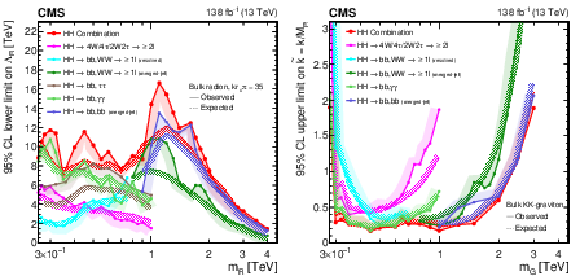
png pdf |
Figure 35:
Observed and expected limits, at 95% CL, on the parameters of models with warped extra dimensions, as obtained from the $ \mathrm{X}\to\mathrm{H}\mathrm{H} $ analyses presented in this report and their combined likelihood analysis. Shown are lower limits (left) on the bulk radion ultraviolet cutoff parameter $ \Lambda_{\mathrm{R}} $, as a function of the radion mass $ m_{{\mathrm{R}} } $, and upper limits (right) on the parameter $ \tilde{k} $ of the spin-2 bulk graviton G, as a function of $ m_{{\mathrm{G}} } $. Excluded areas are indicated by the direction of the hatching along the exclusion contours. |
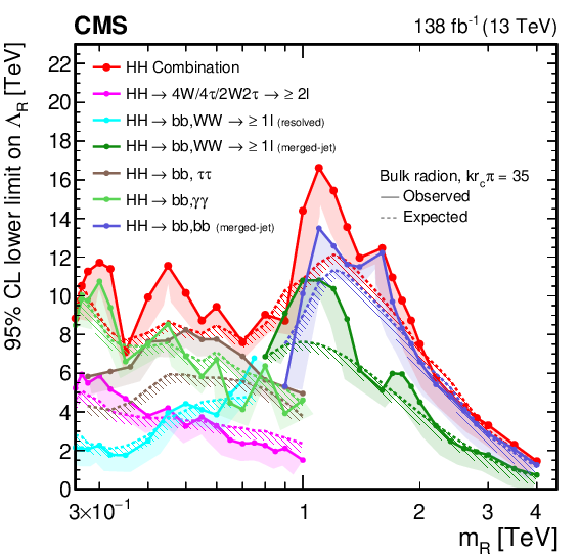
png pdf |
Figure 35-a:
Observed and expected limits, at 95% CL, on the parameters of models with warped extra dimensions, as obtained from the $ \mathrm{X}\to\mathrm{H}\mathrm{H} $ analyses presented in this report and their combined likelihood analysis. Shown are lower limits (left) on the bulk radion ultraviolet cutoff parameter $ \Lambda_{\mathrm{R}} $, as a function of the radion mass $ m_{{\mathrm{R}} } $, and upper limits (right) on the parameter $ \tilde{k} $ of the spin-2 bulk graviton G, as a function of $ m_{{\mathrm{G}} } $. Excluded areas are indicated by the direction of the hatching along the exclusion contours. |
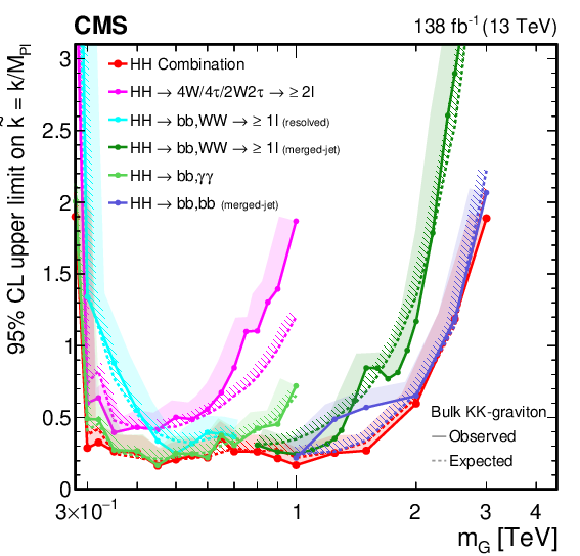
png pdf |
Figure 35-b:
Observed and expected limits, at 95% CL, on the parameters of models with warped extra dimensions, as obtained from the $ \mathrm{X}\to\mathrm{H}\mathrm{H} $ analyses presented in this report and their combined likelihood analysis. Shown are lower limits (left) on the bulk radion ultraviolet cutoff parameter $ \Lambda_{\mathrm{R}} $, as a function of the radion mass $ m_{{\mathrm{R}} } $, and upper limits (right) on the parameter $ \tilde{k} $ of the spin-2 bulk graviton G, as a function of $ m_{{\mathrm{G}} } $. Excluded areas are indicated by the direction of the hatching along the exclusion contours. |

png pdf |
Figure 36:
Observed and expected limits, at 95% CL, on the parameters of models with warped extra dimensions, as obtained from the combined likelihood analysis of the individual $ \mathrm{X}\to\mathrm{H}\mathrm{H} $ analyses presented in this report and shown in Fig. 35. The exclusion contours obtained from the combined likelihood analysis are compared to similar exclusions obtained from individual searches in the decays $ \mathrm{Z}(\ell\ell)\mathrm{Z}(\mathrm{q}\mathrm{q}/\nu\nu/\ell\ell) $ [195], $ \mathrm{W}(\ell\nu)\mathrm{W}(\ell\nu/\mathrm{q}\mathrm{q}) $ [170], $ \mathrm{W}(\ell\nu)\mathrm{W}(\mathrm{q}\mathrm{q}) $ [109], $ \mathrm{V}(\mathrm{q}\mathrm{q})\mathrm{V}(\mathrm{q}\mathrm{q}) $ [111], and $ \mathrm{Z}(\nu\nu)\mathrm{Z}(\mathrm{q}\mathrm{q}) $ [196], in case of the radion interpretation, and from individual searches in the decays $ \mathrm{Z}(\mathrm{q}\mathrm{q})\mathrm{Z}(\ell\ell) $ [197], $ \mathrm{V}(\mathrm{q}\mathrm{q})\mathrm{V}(\mathrm{q}\mathrm{q}) $ [111], $ \mathrm{Z}(\nu\nu)\mathrm{Z}(\mathrm{q}\mathrm{q}) $ [196], and $ \mathrm{W}(\ell\nu)\mathrm{W}(\mathrm{q}\mathrm{q}) $ [109], in the case of the graviton interpretation. Excluded areas are indicated by the direction of the hatching along the exclusion contours. |

png pdf |
Figure 36-a:
Observed and expected limits, at 95% CL, on the parameters of models with warped extra dimensions, as obtained from the combined likelihood analysis of the individual $ \mathrm{X}\to\mathrm{H}\mathrm{H} $ analyses presented in this report and shown in Fig. 35. The exclusion contours obtained from the combined likelihood analysis are compared to similar exclusions obtained from individual searches in the decays $ \mathrm{Z}(\ell\ell)\mathrm{Z}(\mathrm{q}\mathrm{q}/\nu\nu/\ell\ell) $ [195], $ \mathrm{W}(\ell\nu)\mathrm{W}(\ell\nu/\mathrm{q}\mathrm{q}) $ [170], $ \mathrm{W}(\ell\nu)\mathrm{W}(\mathrm{q}\mathrm{q}) $ [109], $ \mathrm{V}(\mathrm{q}\mathrm{q})\mathrm{V}(\mathrm{q}\mathrm{q}) $ [111], and $ \mathrm{Z}(\nu\nu)\mathrm{Z}(\mathrm{q}\mathrm{q}) $ [196], in case of the radion interpretation, and from individual searches in the decays $ \mathrm{Z}(\mathrm{q}\mathrm{q})\mathrm{Z}(\ell\ell) $ [197], $ \mathrm{V}(\mathrm{q}\mathrm{q})\mathrm{V}(\mathrm{q}\mathrm{q}) $ [111], $ \mathrm{Z}(\nu\nu)\mathrm{Z}(\mathrm{q}\mathrm{q}) $ [196], and $ \mathrm{W}(\ell\nu)\mathrm{W}(\mathrm{q}\mathrm{q}) $ [109], in the case of the graviton interpretation. Excluded areas are indicated by the direction of the hatching along the exclusion contours. |

png pdf |
Figure 36-b:
Observed and expected limits, at 95% CL, on the parameters of models with warped extra dimensions, as obtained from the combined likelihood analysis of the individual $ \mathrm{X}\to\mathrm{H}\mathrm{H} $ analyses presented in this report and shown in Fig. 35. The exclusion contours obtained from the combined likelihood analysis are compared to similar exclusions obtained from individual searches in the decays $ \mathrm{Z}(\ell\ell)\mathrm{Z}(\mathrm{q}\mathrm{q}/\nu\nu/\ell\ell) $ [195], $ \mathrm{W}(\ell\nu)\mathrm{W}(\ell\nu/\mathrm{q}\mathrm{q}) $ [170], $ \mathrm{W}(\ell\nu)\mathrm{W}(\mathrm{q}\mathrm{q}) $ [109], $ \mathrm{V}(\mathrm{q}\mathrm{q})\mathrm{V}(\mathrm{q}\mathrm{q}) $ [111], and $ \mathrm{Z}(\nu\nu)\mathrm{Z}(\mathrm{q}\mathrm{q}) $ [196], in case of the radion interpretation, and from individual searches in the decays $ \mathrm{Z}(\mathrm{q}\mathrm{q})\mathrm{Z}(\ell\ell) $ [197], $ \mathrm{V}(\mathrm{q}\mathrm{q})\mathrm{V}(\mathrm{q}\mathrm{q}) $ [111], $ \mathrm{Z}(\nu\nu)\mathrm{Z}(\mathrm{q}\mathrm{q}) $ [196], and $ \mathrm{W}(\ell\nu)\mathrm{W}(\mathrm{q}\mathrm{q}) $ [109], in the case of the graviton interpretation. Excluded areas are indicated by the direction of the hatching along the exclusion contours. |

png pdf |
Figure 37:
Observed upper limits, at 95% CL, on the Drell-Yan production cross section of (upper) W', (middle) Z', and (lower) combined $ \mathrm{V}^{\prime} $ spin-1 resonances assuming branching fractions of the heavy vector triplet models (left) A and (right) B. The theory predictions from these models are also shown. Results from the VH [109,110,111] and VV channels [109,111,197,196], as well as results from dijet [201], $ \mathrm{t}\mathrm{b} $ [199], $ \ell\ell $ [198], and $ \ell\nu $ [200] final states are also shown, for comparison. |

png pdf |
Figure 37-a:
Observed upper limits, at 95% CL, on the Drell-Yan production cross section of (upper) W', (middle) Z', and (lower) combined $ \mathrm{V}^{\prime} $ spin-1 resonances assuming branching fractions of the heavy vector triplet models (left) A and (right) B. The theory predictions from these models are also shown. Results from the VH [109,110,111] and VV channels [109,111,197,196], as well as results from dijet [201], $ \mathrm{t}\mathrm{b} $ [199], $ \ell\ell $ [198], and $ \ell\nu $ [200] final states are also shown, for comparison. |

png pdf |
Figure 37-b:
Observed upper limits, at 95% CL, on the Drell-Yan production cross section of (upper) W', (middle) Z', and (lower) combined $ \mathrm{V}^{\prime} $ spin-1 resonances assuming branching fractions of the heavy vector triplet models (left) A and (right) B. The theory predictions from these models are also shown. Results from the VH [109,110,111] and VV channels [109,111,197,196], as well as results from dijet [201], $ \mathrm{t}\mathrm{b} $ [199], $ \ell\ell $ [198], and $ \ell\nu $ [200] final states are also shown, for comparison. |
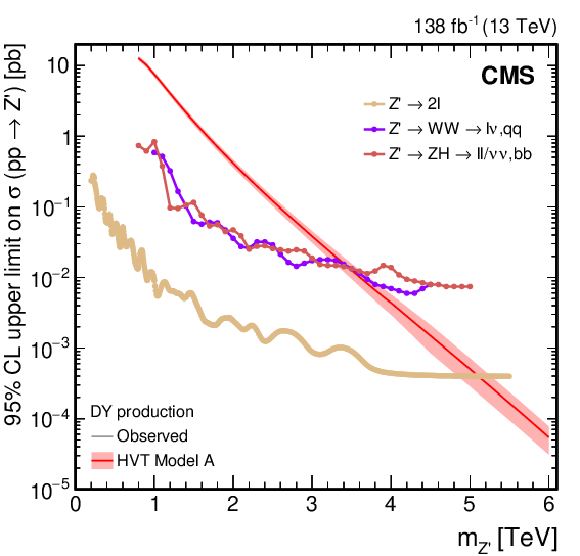
png pdf |
Figure 37-c:
Observed upper limits, at 95% CL, on the Drell-Yan production cross section of (upper) W', (middle) Z', and (lower) combined $ \mathrm{V}^{\prime} $ spin-1 resonances assuming branching fractions of the heavy vector triplet models (left) A and (right) B. The theory predictions from these models are also shown. Results from the VH [109,110,111] and VV channels [109,111,197,196], as well as results from dijet [201], $ \mathrm{t}\mathrm{b} $ [199], $ \ell\ell $ [198], and $ \ell\nu $ [200] final states are also shown, for comparison. |

png pdf |
Figure 37-d:
Observed upper limits, at 95% CL, on the Drell-Yan production cross section of (upper) W', (middle) Z', and (lower) combined $ \mathrm{V}^{\prime} $ spin-1 resonances assuming branching fractions of the heavy vector triplet models (left) A and (right) B. The theory predictions from these models are also shown. Results from the VH [109,110,111] and VV channels [109,111,197,196], as well as results from dijet [201], $ \mathrm{t}\mathrm{b} $ [199], $ \ell\ell $ [198], and $ \ell\nu $ [200] final states are also shown, for comparison. |

png pdf |
Figure 37-e:
Observed upper limits, at 95% CL, on the Drell-Yan production cross section of (upper) W', (middle) Z', and (lower) combined $ \mathrm{V}^{\prime} $ spin-1 resonances assuming branching fractions of the heavy vector triplet models (left) A and (right) B. The theory predictions from these models are also shown. Results from the VH [109,110,111] and VV channels [109,111,197,196], as well as results from dijet [201], $ \mathrm{t}\mathrm{b} $ [199], $ \ell\ell $ [198], and $ \ell\nu $ [200] final states are also shown, for comparison. |
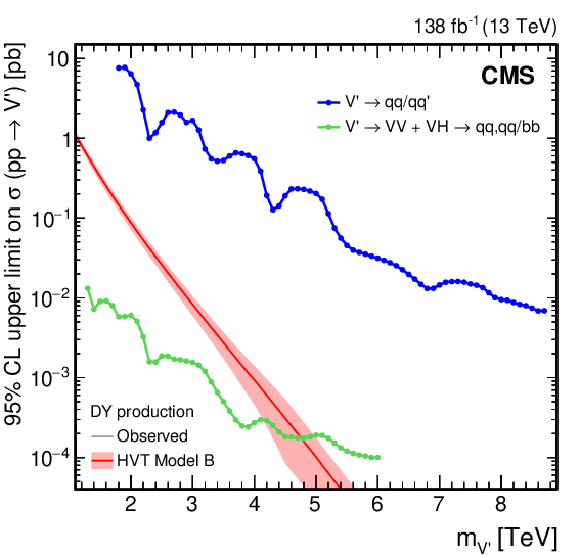
png pdf |
Figure 37-f:
Observed upper limits, at 95% CL, on the Drell-Yan production cross section of (upper) W', (middle) Z', and (lower) combined $ \mathrm{V}^{\prime} $ spin-1 resonances assuming branching fractions of the heavy vector triplet models (left) A and (right) B. The theory predictions from these models are also shown. Results from the VH [109,110,111] and VV channels [109,111,197,196], as well as results from dijet [201], $ \mathrm{t}\mathrm{b} $ [199], $ \ell\ell $ [198], and $ \ell\nu $ [200] final states are also shown, for comparison. |
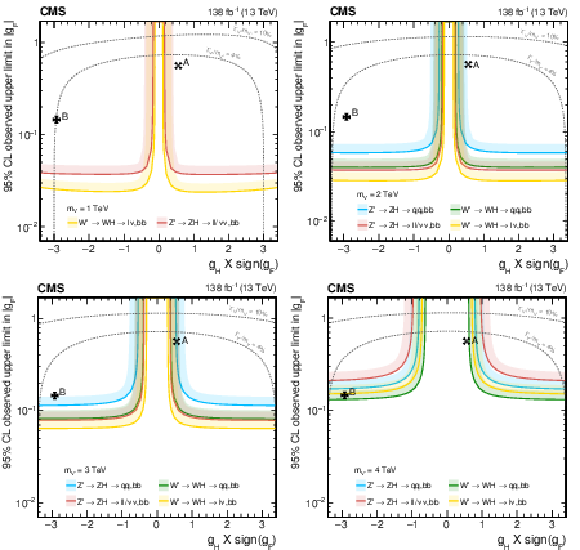
png pdf |
Figure 38:
Observed upper limits, at 95% CL, on the $ \mathrm{V}^{\prime} $ couplings $ g_\mathrm{F} $ and $ g_{\mathrm{H}} $ within the HVT model for $ \mathrm{V}^{\prime} $ masses of (upper left) 1, (upper right) 2, (lower left) 3, and (lower right) 4 TeV, from DY production, derived from VH channels of Refs. [109,110,111] discussed in this report. Excluded areas are indicated by the direction of the shading along the exclusion contours. The dotted lines denote coupling values above which the relative width of the resonance, $ \Gamma_{\mathrm{V}^{\prime}} /m_{V^{\prime}} $, exceeds 4 and 10%, respectively, implying that the narrow width approximation no longer applies. The couplings corresponding to the heavy vector triplet models A and B are indicated by cross markers. |
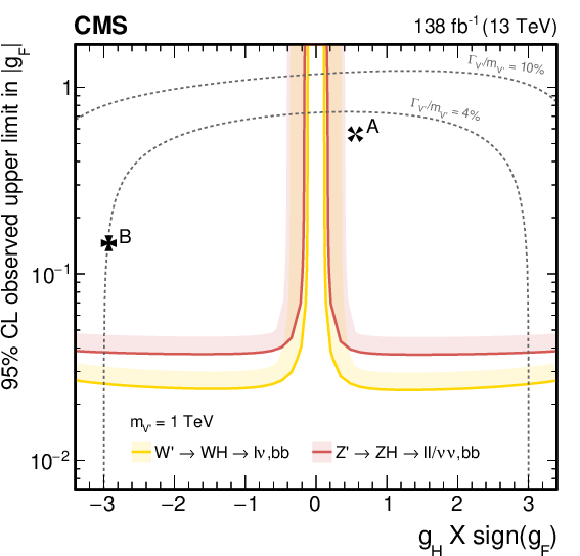
png pdf |
Figure 38-a:
Observed upper limits, at 95% CL, on the $ \mathrm{V}^{\prime} $ couplings $ g_\mathrm{F} $ and $ g_{\mathrm{H}} $ within the HVT model for $ \mathrm{V}^{\prime} $ masses of (upper left) 1, (upper right) 2, (lower left) 3, and (lower right) 4 TeV, from DY production, derived from VH channels of Refs. [109,110,111] discussed in this report. Excluded areas are indicated by the direction of the shading along the exclusion contours. The dotted lines denote coupling values above which the relative width of the resonance, $ \Gamma_{\mathrm{V}^{\prime}} /m_{V^{\prime}} $, exceeds 4 and 10%, respectively, implying that the narrow width approximation no longer applies. The couplings corresponding to the heavy vector triplet models A and B are indicated by cross markers. |
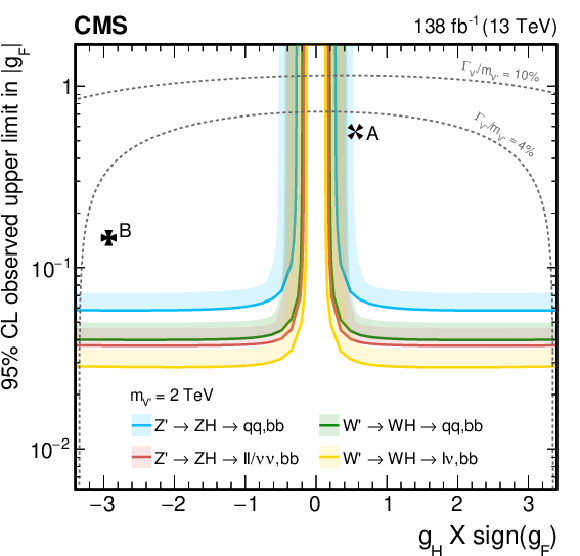
png pdf |
Figure 38-b:
Observed upper limits, at 95% CL, on the $ \mathrm{V}^{\prime} $ couplings $ g_\mathrm{F} $ and $ g_{\mathrm{H}} $ within the HVT model for $ \mathrm{V}^{\prime} $ masses of (upper left) 1, (upper right) 2, (lower left) 3, and (lower right) 4 TeV, from DY production, derived from VH channels of Refs. [109,110,111] discussed in this report. Excluded areas are indicated by the direction of the shading along the exclusion contours. The dotted lines denote coupling values above which the relative width of the resonance, $ \Gamma_{\mathrm{V}^{\prime}} /m_{V^{\prime}} $, exceeds 4 and 10%, respectively, implying that the narrow width approximation no longer applies. The couplings corresponding to the heavy vector triplet models A and B are indicated by cross markers. |
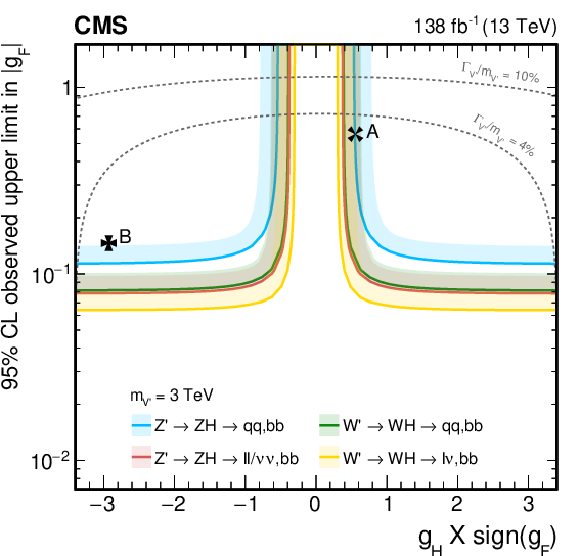
png pdf |
Figure 38-c:
Observed upper limits, at 95% CL, on the $ \mathrm{V}^{\prime} $ couplings $ g_\mathrm{F} $ and $ g_{\mathrm{H}} $ within the HVT model for $ \mathrm{V}^{\prime} $ masses of (upper left) 1, (upper right) 2, (lower left) 3, and (lower right) 4 TeV, from DY production, derived from VH channels of Refs. [109,110,111] discussed in this report. Excluded areas are indicated by the direction of the shading along the exclusion contours. The dotted lines denote coupling values above which the relative width of the resonance, $ \Gamma_{\mathrm{V}^{\prime}} /m_{V^{\prime}} $, exceeds 4 and 10%, respectively, implying that the narrow width approximation no longer applies. The couplings corresponding to the heavy vector triplet models A and B are indicated by cross markers. |

png pdf |
Figure 38-d:
Observed upper limits, at 95% CL, on the $ \mathrm{V}^{\prime} $ couplings $ g_\mathrm{F} $ and $ g_{\mathrm{H}} $ within the HVT model for $ \mathrm{V}^{\prime} $ masses of (upper left) 1, (upper right) 2, (lower left) 3, and (lower right) 4 TeV, from DY production, derived from VH channels of Refs. [109,110,111] discussed in this report. Excluded areas are indicated by the direction of the shading along the exclusion contours. The dotted lines denote coupling values above which the relative width of the resonance, $ \Gamma_{\mathrm{V}^{\prime}} /m_{V^{\prime}} $, exceeds 4 and 10%, respectively, implying that the narrow width approximation no longer applies. The couplings corresponding to the heavy vector triplet models A and B are indicated by cross markers. |
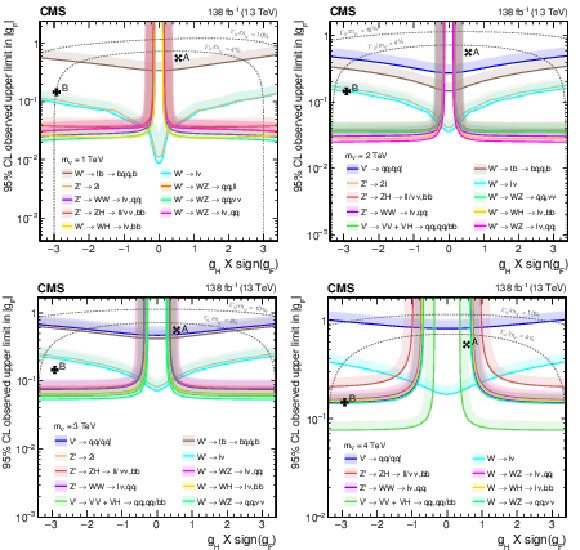
png pdf |
Figure 39:
Observed upper limits, at 95% CL, on the $ \mathrm{V}^{\prime} $ couplings $ g_\mathrm{F} $ and $ g_{\mathrm{H}} $ within the HVT model for $ \mathrm{V}^{\prime} $ masses of (upper left) 1, (upper right) 2, (lower left) 3, and (lower right) 4 TeV, from DY production, derived from VH channels of Refs. [109,110,111] discussed in this report and the VV channels of Refs.[109,111,197,196], as well as results from dijet [201], $ \mathrm{t}\mathrm{b} $ [199], as well as results from dijet [201], $ \mathrm{t}\mathrm{b} $ [199], $ \ell\ell $ [198] and $ \ell\nu $ [200] final states. Excluded areas are indicated by the direction of the shading along the exclusion contours. The dotted lines denote coupling values above which the relative width of the resonance, $ \Gamma_{\mathrm{V}^{\prime}}/m_{V^{\prime}} $, exceeds 4 and 10%, respectively, implying that the narrow width approximation no longer applies. The couplings corresponding to the heavy vector triplet models A and B are indicated by cross markers. |
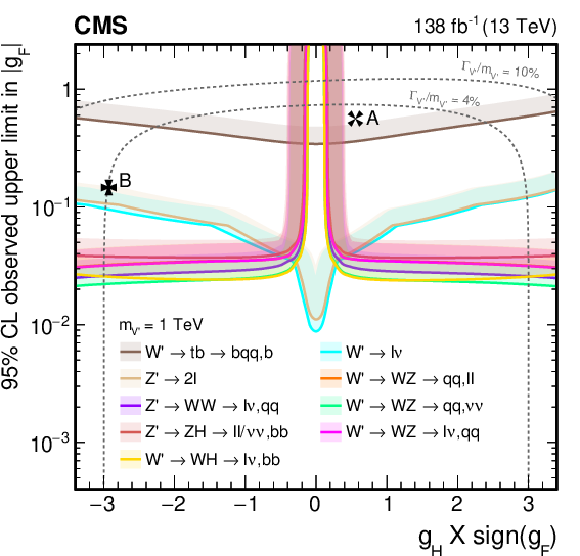
png pdf |
Figure 39-a:
Observed upper limits, at 95% CL, on the $ \mathrm{V}^{\prime} $ couplings $ g_\mathrm{F} $ and $ g_{\mathrm{H}} $ within the HVT model for $ \mathrm{V}^{\prime} $ masses of (upper left) 1, (upper right) 2, (lower left) 3, and (lower right) 4 TeV, from DY production, derived from VH channels of Refs. [109,110,111] discussed in this report and the VV channels of Refs.[109,111,197,196], as well as results from dijet [201], $ \mathrm{t}\mathrm{b} $ [199], as well as results from dijet [201], $ \mathrm{t}\mathrm{b} $ [199], $ \ell\ell $ [198] and $ \ell\nu $ [200] final states. Excluded areas are indicated by the direction of the shading along the exclusion contours. The dotted lines denote coupling values above which the relative width of the resonance, $ \Gamma_{\mathrm{V}^{\prime}}/m_{V^{\prime}} $, exceeds 4 and 10%, respectively, implying that the narrow width approximation no longer applies. The couplings corresponding to the heavy vector triplet models A and B are indicated by cross markers. |
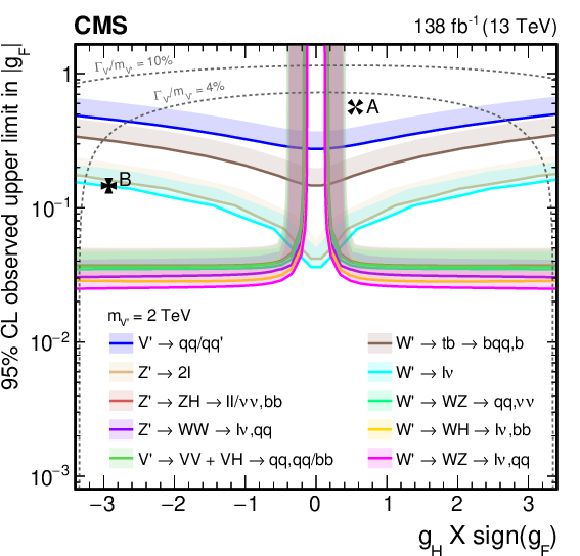
png pdf |
Figure 39-b:
Observed upper limits, at 95% CL, on the $ \mathrm{V}^{\prime} $ couplings $ g_\mathrm{F} $ and $ g_{\mathrm{H}} $ within the HVT model for $ \mathrm{V}^{\prime} $ masses of (upper left) 1, (upper right) 2, (lower left) 3, and (lower right) 4 TeV, from DY production, derived from VH channels of Refs. [109,110,111] discussed in this report and the VV channels of Refs.[109,111,197,196], as well as results from dijet [201], $ \mathrm{t}\mathrm{b} $ [199], as well as results from dijet [201], $ \mathrm{t}\mathrm{b} $ [199], $ \ell\ell $ [198] and $ \ell\nu $ [200] final states. Excluded areas are indicated by the direction of the shading along the exclusion contours. The dotted lines denote coupling values above which the relative width of the resonance, $ \Gamma_{\mathrm{V}^{\prime}}/m_{V^{\prime}} $, exceeds 4 and 10%, respectively, implying that the narrow width approximation no longer applies. The couplings corresponding to the heavy vector triplet models A and B are indicated by cross markers. |
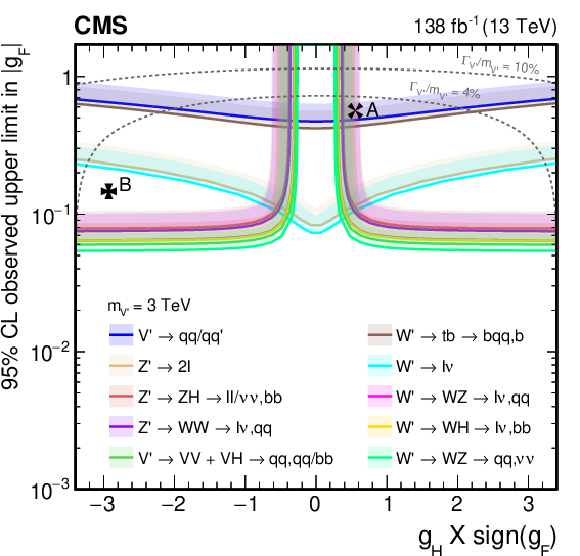
png pdf |
Figure 39-c:
Observed upper limits, at 95% CL, on the $ \mathrm{V}^{\prime} $ couplings $ g_\mathrm{F} $ and $ g_{\mathrm{H}} $ within the HVT model for $ \mathrm{V}^{\prime} $ masses of (upper left) 1, (upper right) 2, (lower left) 3, and (lower right) 4 TeV, from DY production, derived from VH channels of Refs. [109,110,111] discussed in this report and the VV channels of Refs.[109,111,197,196], as well as results from dijet [201], $ \mathrm{t}\mathrm{b} $ [199], as well as results from dijet [201], $ \mathrm{t}\mathrm{b} $ [199], $ \ell\ell $ [198] and $ \ell\nu $ [200] final states. Excluded areas are indicated by the direction of the shading along the exclusion contours. The dotted lines denote coupling values above which the relative width of the resonance, $ \Gamma_{\mathrm{V}^{\prime}}/m_{V^{\prime}} $, exceeds 4 and 10%, respectively, implying that the narrow width approximation no longer applies. The couplings corresponding to the heavy vector triplet models A and B are indicated by cross markers. |
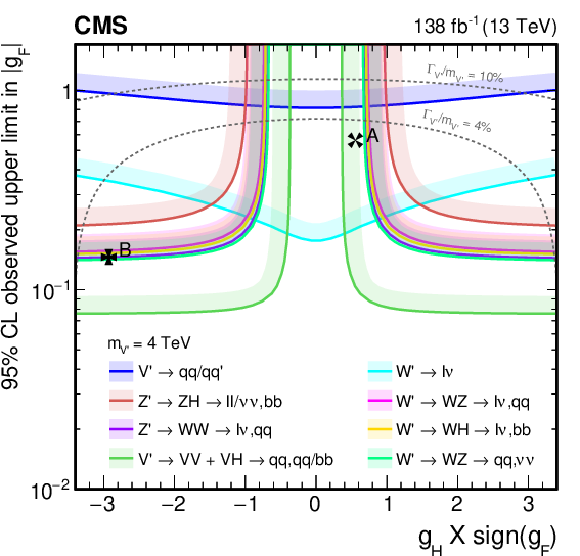
png pdf |
Figure 39-d:
Observed upper limits, at 95% CL, on the $ \mathrm{V}^{\prime} $ couplings $ g_\mathrm{F} $ and $ g_{\mathrm{H}} $ within the HVT model for $ \mathrm{V}^{\prime} $ masses of (upper left) 1, (upper right) 2, (lower left) 3, and (lower right) 4 TeV, from DY production, derived from VH channels of Refs. [109,110,111] discussed in this report and the VV channels of Refs.[109,111,197,196], as well as results from dijet [201], $ \mathrm{t}\mathrm{b} $ [199], as well as results from dijet [201], $ \mathrm{t}\mathrm{b} $ [199], $ \ell\ell $ [198] and $ \ell\nu $ [200] final states. Excluded areas are indicated by the direction of the shading along the exclusion contours. The dotted lines denote coupling values above which the relative width of the resonance, $ \Gamma_{\mathrm{V}^{\prime}}/m_{V^{\prime}} $, exceeds 4 and 10%, respectively, implying that the narrow width approximation no longer applies. The couplings corresponding to the heavy vector triplet models A and B are indicated by cross markers. |

png pdf |
Figure 40:
Obseved upper limits, at 95% CL, on the coupling $ g_{\mathrm{H}} $ within the heavy vector triplet model, as a function of the $ \mathrm{V}^{\prime} $ mass. The limits are shown for the vecotr boson fusion production mode in the context of model C, in which $ g_\mathrm{F} = $ 0. The results are shown (left) for the WH and ZH analyses of Refs. [109,110,111], individually, and for a combination with the WZ final states of Refs. [196,111,109] (right), where the WH and ZH results from all-hadronic final states have been combined with the corresponding VV channels. The dotted lines denote coupling values above which the relative width of the resonance, $ \Gamma_{\mathrm{V}^{\prime}}/m_{V^{\prime}} $, exceeds 4 and 10%, respectively, implying the narrow width approximation no longer applies. |
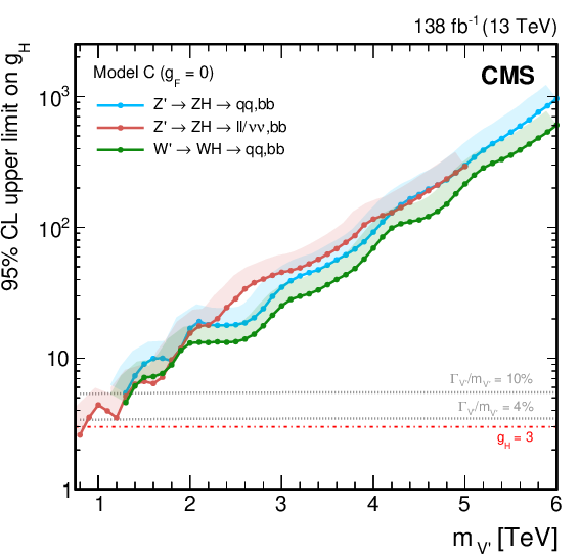
png pdf |
Figure 40-a:
Obseved upper limits, at 95% CL, on the coupling $ g_{\mathrm{H}} $ within the heavy vector triplet model, as a function of the $ \mathrm{V}^{\prime} $ mass. The limits are shown for the vecotr boson fusion production mode in the context of model C, in which $ g_\mathrm{F} = $ 0. The results are shown (left) for the WH and ZH analyses of Refs. [109,110,111], individually, and for a combination with the WZ final states of Refs. [196,111,109] (right), where the WH and ZH results from all-hadronic final states have been combined with the corresponding VV channels. The dotted lines denote coupling values above which the relative width of the resonance, $ \Gamma_{\mathrm{V}^{\prime}}/m_{V^{\prime}} $, exceeds 4 and 10%, respectively, implying the narrow width approximation no longer applies. |
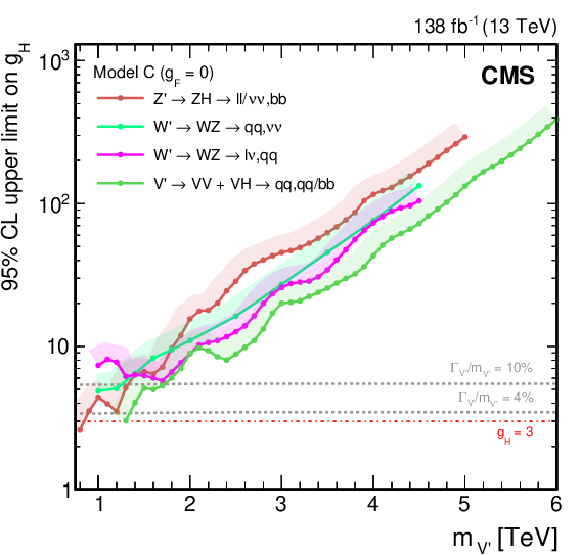
png pdf |
Figure 40-b:
Obseved upper limits, at 95% CL, on the coupling $ g_{\mathrm{H}} $ within the heavy vector triplet model, as a function of the $ \mathrm{V}^{\prime} $ mass. The limits are shown for the vecotr boson fusion production mode in the context of model C, in which $ g_\mathrm{F} = $ 0. The results are shown (left) for the WH and ZH analyses of Refs. [109,110,111], individually, and for a combination with the WZ final states of Refs. [196,111,109] (right), where the WH and ZH results from all-hadronic final states have been combined with the corresponding VV channels. The dotted lines denote coupling values above which the relative width of the resonance, $ \Gamma_{\mathrm{V}^{\prime}}/m_{V^{\prime}} $, exceeds 4 and 10%, respectively, implying the narrow width approximation no longer applies. |
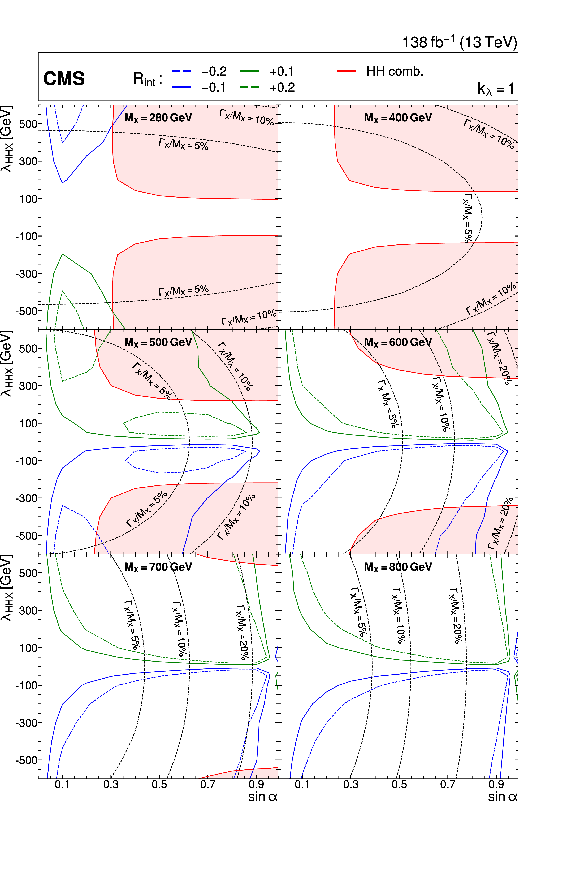
png pdf |
Figure 41:
Contours of the variable $ R_{\text{int}} $ as defined in Eq. (13) and discussed in the text, in the ($ \sin\alpha $, $ \lambda_{\mathrm{H}\mathrm{H}\mathrm{X}} $) plane for the singlet model with $ k_{\lambda} = $ 1 and different resonance masses $ m_{\mathrm{X}} $ between (upper left) 280 and (lower right) 800 GeV. Contours are shown for $ R_{\text{int}} $ values of (dashed blue) $-$0.2, (solid blue) $-$0.1, (solid green) $ + $0.1, and (dashed green) $ + $0.2. Regions that are excluded, at 95% CL, from the combined likelihood analysis of the HH analyses presented in this report are indicated by red filled areas. Dashed black lines indicate constant relative widths of 5, 10, and 20%. |
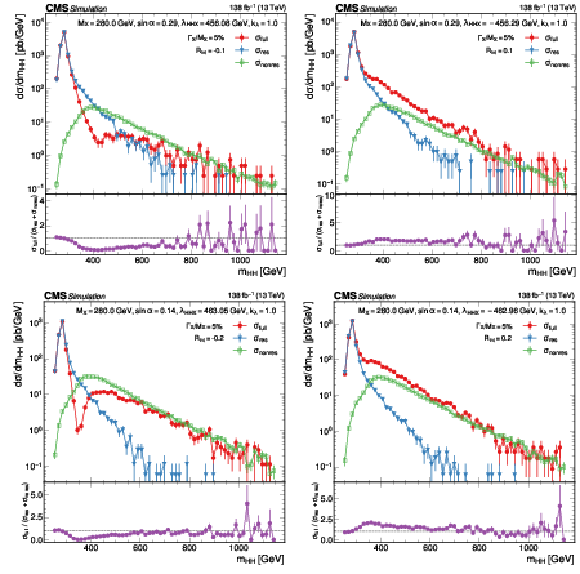
png pdf |
Figure 42:
Expected differential cross sections for HH production, as a function of $ m_{{\mathrm{H}\mathrm{H}}} $, for the real-singlet model with $ m_{\mathrm{X}} = $ 280 GeV and $ \Gamma_{\mathrm{X}}/m_{\mathrm{X}} = 5% $. The parameters $ \sin\alpha $ and $ \lambda_{\mathrm{H}\mathrm{H}\mathrm{X}} $ have been chosen such that (upper row) $ R_{\text{int}}=\pm 10% $ and (lower row) $ R_{\text{int}}=\pm 20% $, for (left) negative and (right) positive values of $ R_{\text{int}} $. The total cross section for HH production $ \sigma^{\text{full}} $ (red line, labelled as $ \sigma_{\text{full}} $) is compared to the cross sections $ \sigma^{\text{ resonant-only}} $ (blue line, labelled as $ \sigma_{\text{res}} $) and $ \sigma^{ \text{nonresonant}} $ (green line, labelled as $ \sigma_{\text{nores}} $) considering only resonant and nonresonant production. In the lower panels the ratio of $ \sigma^{\text{full}} $ over $ (\sigma^{\text{resonant-only}}+\sigma^{ \text{nonresonant}}) $ is shown. |
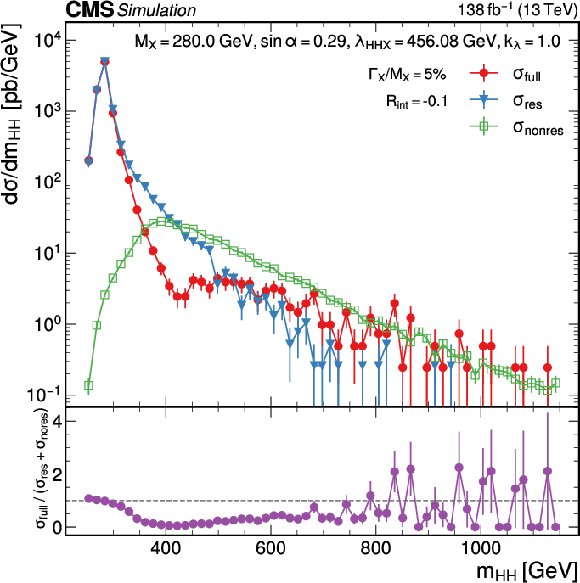
png pdf |
Figure 42-a:
Expected differential cross sections for HH production, as a function of $ m_{{\mathrm{H}\mathrm{H}}} $, for the real-singlet model with $ m_{\mathrm{X}} = $ 280 GeV and $ \Gamma_{\mathrm{X}}/m_{\mathrm{X}} = 5% $. The parameters $ \sin\alpha $ and $ \lambda_{\mathrm{H}\mathrm{H}\mathrm{X}} $ have been chosen such that (upper row) $ R_{\text{int}}=\pm 10% $ and (lower row) $ R_{\text{int}}=\pm 20% $, for (left) negative and (right) positive values of $ R_{\text{int}} $. The total cross section for HH production $ \sigma^{\text{full}} $ (red line, labelled as $ \sigma_{\text{full}} $) is compared to the cross sections $ \sigma^{\text{ resonant-only}} $ (blue line, labelled as $ \sigma_{\text{res}} $) and $ \sigma^{ \text{nonresonant}} $ (green line, labelled as $ \sigma_{\text{nores}} $) considering only resonant and nonresonant production. In the lower panels the ratio of $ \sigma^{\text{full}} $ over $ (\sigma^{\text{resonant-only}}+\sigma^{ \text{nonresonant}}) $ is shown. |

png pdf |
Figure 42-b:
Expected differential cross sections for HH production, as a function of $ m_{{\mathrm{H}\mathrm{H}}} $, for the real-singlet model with $ m_{\mathrm{X}} = $ 280 GeV and $ \Gamma_{\mathrm{X}}/m_{\mathrm{X}} = 5% $. The parameters $ \sin\alpha $ and $ \lambda_{\mathrm{H}\mathrm{H}\mathrm{X}} $ have been chosen such that (upper row) $ R_{\text{int}}=\pm 10% $ and (lower row) $ R_{\text{int}}=\pm 20% $, for (left) negative and (right) positive values of $ R_{\text{int}} $. The total cross section for HH production $ \sigma^{\text{full}} $ (red line, labelled as $ \sigma_{\text{full}} $) is compared to the cross sections $ \sigma^{\text{ resonant-only}} $ (blue line, labelled as $ \sigma_{\text{res}} $) and $ \sigma^{ \text{nonresonant}} $ (green line, labelled as $ \sigma_{\text{nores}} $) considering only resonant and nonresonant production. In the lower panels the ratio of $ \sigma^{\text{full}} $ over $ (\sigma^{\text{resonant-only}}+\sigma^{ \text{nonresonant}}) $ is shown. |

png pdf |
Figure 42-c:
Expected differential cross sections for HH production, as a function of $ m_{{\mathrm{H}\mathrm{H}}} $, for the real-singlet model with $ m_{\mathrm{X}} = $ 280 GeV and $ \Gamma_{\mathrm{X}}/m_{\mathrm{X}} = 5% $. The parameters $ \sin\alpha $ and $ \lambda_{\mathrm{H}\mathrm{H}\mathrm{X}} $ have been chosen such that (upper row) $ R_{\text{int}}=\pm 10% $ and (lower row) $ R_{\text{int}}=\pm 20% $, for (left) negative and (right) positive values of $ R_{\text{int}} $. The total cross section for HH production $ \sigma^{\text{full}} $ (red line, labelled as $ \sigma_{\text{full}} $) is compared to the cross sections $ \sigma^{\text{ resonant-only}} $ (blue line, labelled as $ \sigma_{\text{res}} $) and $ \sigma^{ \text{nonresonant}} $ (green line, labelled as $ \sigma_{\text{nores}} $) considering only resonant and nonresonant production. In the lower panels the ratio of $ \sigma^{\text{full}} $ over $ (\sigma^{\text{resonant-only}}+\sigma^{ \text{nonresonant}}) $ is shown. |

png pdf |
Figure 42-d:
Expected differential cross sections for HH production, as a function of $ m_{{\mathrm{H}\mathrm{H}}} $, for the real-singlet model with $ m_{\mathrm{X}} = $ 280 GeV and $ \Gamma_{\mathrm{X}}/m_{\mathrm{X}} = 5% $. The parameters $ \sin\alpha $ and $ \lambda_{\mathrm{H}\mathrm{H}\mathrm{X}} $ have been chosen such that (upper row) $ R_{\text{int}}=\pm 10% $ and (lower row) $ R_{\text{int}}=\pm 20% $, for (left) negative and (right) positive values of $ R_{\text{int}} $. The total cross section for HH production $ \sigma^{\text{full}} $ (red line, labelled as $ \sigma_{\text{full}} $) is compared to the cross sections $ \sigma^{\text{ resonant-only}} $ (blue line, labelled as $ \sigma_{\text{res}} $) and $ \sigma^{ \text{nonresonant}} $ (green line, labelled as $ \sigma_{\text{nores}} $) considering only resonant and nonresonant production. In the lower panels the ratio of $ \sigma^{\text{full}} $ over $ (\sigma^{\text{resonant-only}}+\sigma^{ \text{nonresonant}}) $ is shown. |
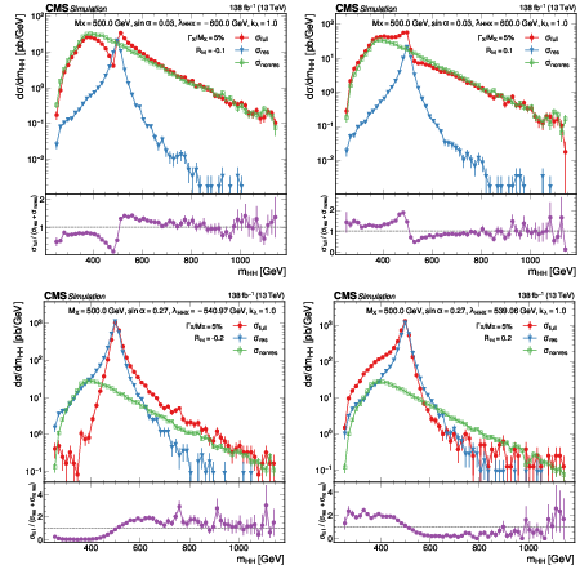
png pdf |
Figure 43:
Expected differential cross sections for HH production, as a function of $ m_{{\mathrm{H}\mathrm{H}}} $ for the real-singlet model with $ m_{\mathrm{X}} = $ 500 GeV and $ \Gamma_{\mathrm{X}}/m_{\mathrm{X}} = 5% $. The parameters $ \sin\alpha $ and $ \lambda_{\mathrm{H}\mathrm{H}\mathrm{X}} $ have been chosen such that (upper row) $ R_{\text{int}}=\pm 10% $ and (lower row) $ R_{\text{int}}=\pm 20% $, for (left) negative and (right) positive values of $ R_{\text{int}} $. The total cross section for HH production $ \sigma^{\text{full}} $ (red line, labelled as $ \sigma_{\text{full}} $) is compared to the cross sections $ \sigma^{\text{ resonant-only}} $ (blue line, labelled as $ \sigma_{\text{res}} $) and $ \sigma^{ \text{nonresonant}} $ (green line, labelled as $ \sigma_{\text{nores}} $) considering only resonant and nonresonant production. In the lower panels the ratio of $ \sigma^{\text{full}} $ over $ (\sigma^{\text{resonant-only}}+\sigma^{ \text{nonresonant}}) $ is shown. |
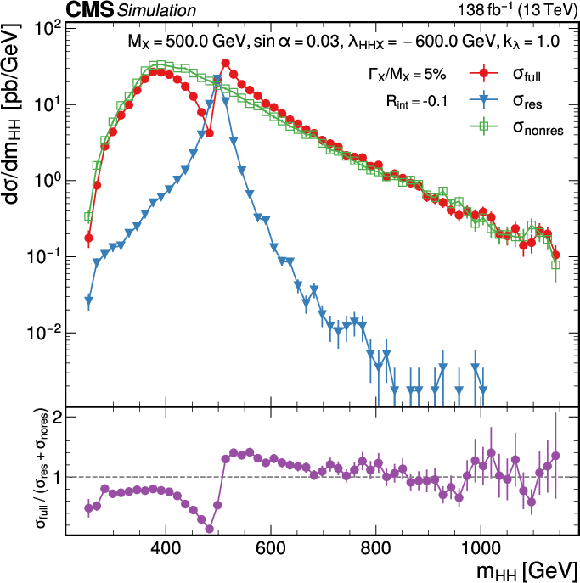
png pdf |
Figure 43-a:
Expected differential cross sections for HH production, as a function of $ m_{{\mathrm{H}\mathrm{H}}} $ for the real-singlet model with $ m_{\mathrm{X}} = $ 500 GeV and $ \Gamma_{\mathrm{X}}/m_{\mathrm{X}} = 5% $. The parameters $ \sin\alpha $ and $ \lambda_{\mathrm{H}\mathrm{H}\mathrm{X}} $ have been chosen such that (upper row) $ R_{\text{int}}=\pm 10% $ and (lower row) $ R_{\text{int}}=\pm 20% $, for (left) negative and (right) positive values of $ R_{\text{int}} $. The total cross section for HH production $ \sigma^{\text{full}} $ (red line, labelled as $ \sigma_{\text{full}} $) is compared to the cross sections $ \sigma^{\text{ resonant-only}} $ (blue line, labelled as $ \sigma_{\text{res}} $) and $ \sigma^{ \text{nonresonant}} $ (green line, labelled as $ \sigma_{\text{nores}} $) considering only resonant and nonresonant production. In the lower panels the ratio of $ \sigma^{\text{full}} $ over $ (\sigma^{\text{resonant-only}}+\sigma^{ \text{nonresonant}}) $ is shown. |
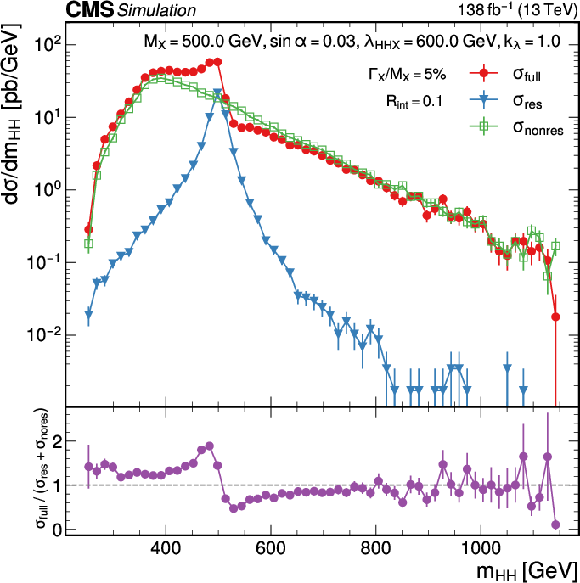
png pdf |
Figure 43-b:
Expected differential cross sections for HH production, as a function of $ m_{{\mathrm{H}\mathrm{H}}} $ for the real-singlet model with $ m_{\mathrm{X}} = $ 500 GeV and $ \Gamma_{\mathrm{X}}/m_{\mathrm{X}} = 5% $. The parameters $ \sin\alpha $ and $ \lambda_{\mathrm{H}\mathrm{H}\mathrm{X}} $ have been chosen such that (upper row) $ R_{\text{int}}=\pm 10% $ and (lower row) $ R_{\text{int}}=\pm 20% $, for (left) negative and (right) positive values of $ R_{\text{int}} $. The total cross section for HH production $ \sigma^{\text{full}} $ (red line, labelled as $ \sigma_{\text{full}} $) is compared to the cross sections $ \sigma^{\text{ resonant-only}} $ (blue line, labelled as $ \sigma_{\text{res}} $) and $ \sigma^{ \text{nonresonant}} $ (green line, labelled as $ \sigma_{\text{nores}} $) considering only resonant and nonresonant production. In the lower panels the ratio of $ \sigma^{\text{full}} $ over $ (\sigma^{\text{resonant-only}}+\sigma^{ \text{nonresonant}}) $ is shown. |

png pdf |
Figure 43-c:
Expected differential cross sections for HH production, as a function of $ m_{{\mathrm{H}\mathrm{H}}} $ for the real-singlet model with $ m_{\mathrm{X}} = $ 500 GeV and $ \Gamma_{\mathrm{X}}/m_{\mathrm{X}} = 5% $. The parameters $ \sin\alpha $ and $ \lambda_{\mathrm{H}\mathrm{H}\mathrm{X}} $ have been chosen such that (upper row) $ R_{\text{int}}=\pm 10% $ and (lower row) $ R_{\text{int}}=\pm 20% $, for (left) negative and (right) positive values of $ R_{\text{int}} $. The total cross section for HH production $ \sigma^{\text{full}} $ (red line, labelled as $ \sigma_{\text{full}} $) is compared to the cross sections $ \sigma^{\text{ resonant-only}} $ (blue line, labelled as $ \sigma_{\text{res}} $) and $ \sigma^{ \text{nonresonant}} $ (green line, labelled as $ \sigma_{\text{nores}} $) considering only resonant and nonresonant production. In the lower panels the ratio of $ \sigma^{\text{full}} $ over $ (\sigma^{\text{resonant-only}}+\sigma^{ \text{nonresonant}}) $ is shown. |
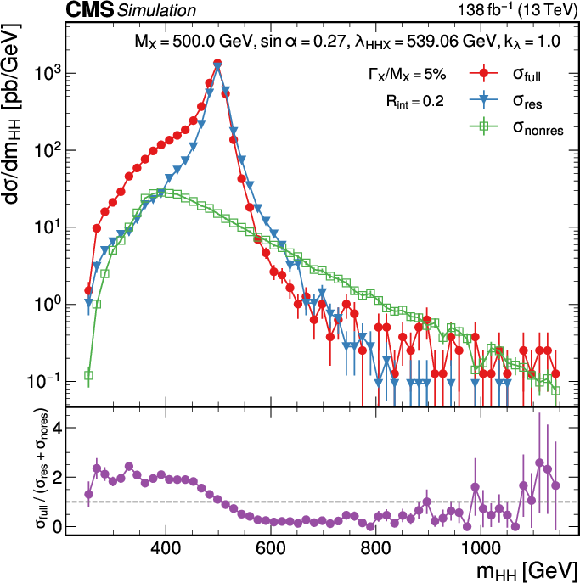
png pdf |
Figure 43-d:
Expected differential cross sections for HH production, as a function of $ m_{{\mathrm{H}\mathrm{H}}} $ for the real-singlet model with $ m_{\mathrm{X}} = $ 500 GeV and $ \Gamma_{\mathrm{X}}/m_{\mathrm{X}} = 5% $. The parameters $ \sin\alpha $ and $ \lambda_{\mathrm{H}\mathrm{H}\mathrm{X}} $ have been chosen such that (upper row) $ R_{\text{int}}=\pm 10% $ and (lower row) $ R_{\text{int}}=\pm 20% $, for (left) negative and (right) positive values of $ R_{\text{int}} $. The total cross section for HH production $ \sigma^{\text{full}} $ (red line, labelled as $ \sigma_{\text{full}} $) is compared to the cross sections $ \sigma^{\text{ resonant-only}} $ (blue line, labelled as $ \sigma_{\text{res}} $) and $ \sigma^{ \text{nonresonant}} $ (green line, labelled as $ \sigma_{\text{nores}} $) considering only resonant and nonresonant production. In the lower panels the ratio of $ \sigma^{\text{full}} $ over $ (\sigma^{\text{resonant-only}}+\sigma^{ \text{nonresonant}}) $ is shown. |
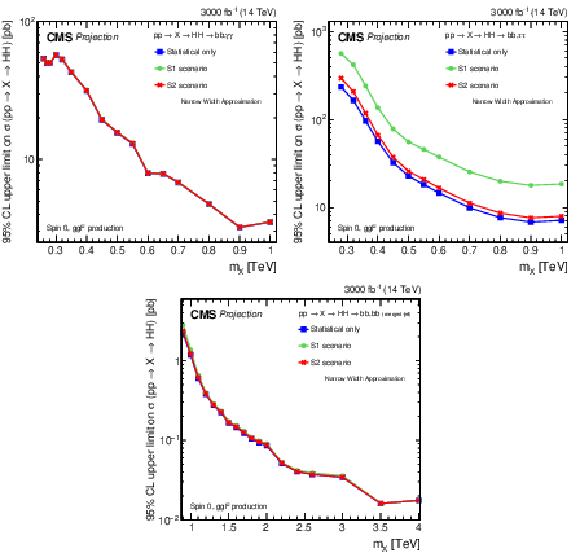
png pdf |
Figure 44:
Expected upper limits at 95% CL, on the product of the cross section for the production of a spin-0 resonance X and the branching fraction $ \mathcal{B}(\mathrm{X} \to\mathrm{H}\mathrm{H}) $, as functions of $ m_{\mathrm{X}} $ from the (upper left) $ \mathrm{b}\mathrm{b}\tau\tau $ [115], (upper right) $ \mathrm{b}\mathrm{b}\gamma\gamma $ [116], and (lower) $ \mathrm{b}\mathrm{b}\mathrm{b}\mathrm{b} $ with two merged $ \mathrm{b}\mathrm{b} $ jets [117] analyses discussed in this report, projected to an integrated luminosity of 3000 fb$ ^{-1} $ under the assumption of different systematic uncertainty scenarios, as discussed in the text. All estimates include the anticipated statistical uncertainties. |

png pdf |
Figure 44-a:
Expected upper limits at 95% CL, on the product of the cross section for the production of a spin-0 resonance X and the branching fraction $ \mathcal{B}(\mathrm{X} \to\mathrm{H}\mathrm{H}) $, as functions of $ m_{\mathrm{X}} $ from the (upper left) $ \mathrm{b}\mathrm{b}\tau\tau $ [115], (upper right) $ \mathrm{b}\mathrm{b}\gamma\gamma $ [116], and (lower) $ \mathrm{b}\mathrm{b}\mathrm{b}\mathrm{b} $ with two merged $ \mathrm{b}\mathrm{b} $ jets [117] analyses discussed in this report, projected to an integrated luminosity of 3000 fb$ ^{-1} $ under the assumption of different systematic uncertainty scenarios, as discussed in the text. All estimates include the anticipated statistical uncertainties. |
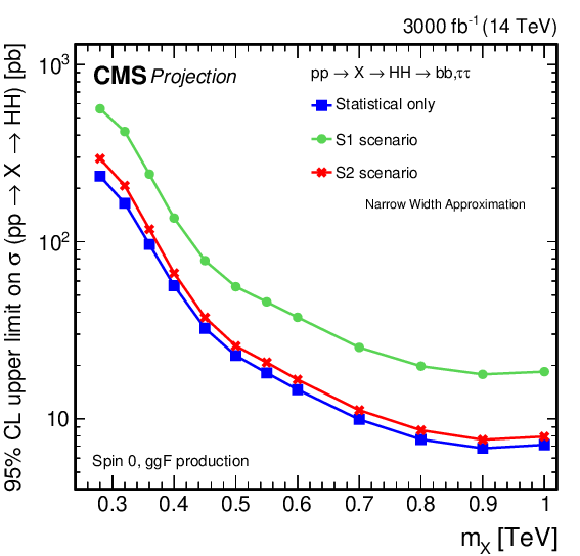
png pdf |
Figure 44-b:
Expected upper limits at 95% CL, on the product of the cross section for the production of a spin-0 resonance X and the branching fraction $ \mathcal{B}(\mathrm{X} \to\mathrm{H}\mathrm{H}) $, as functions of $ m_{\mathrm{X}} $ from the (upper left) $ \mathrm{b}\mathrm{b}\tau\tau $ [115], (upper right) $ \mathrm{b}\mathrm{b}\gamma\gamma $ [116], and (lower) $ \mathrm{b}\mathrm{b}\mathrm{b}\mathrm{b} $ with two merged $ \mathrm{b}\mathrm{b} $ jets [117] analyses discussed in this report, projected to an integrated luminosity of 3000 fb$ ^{-1} $ under the assumption of different systematic uncertainty scenarios, as discussed in the text. All estimates include the anticipated statistical uncertainties. |
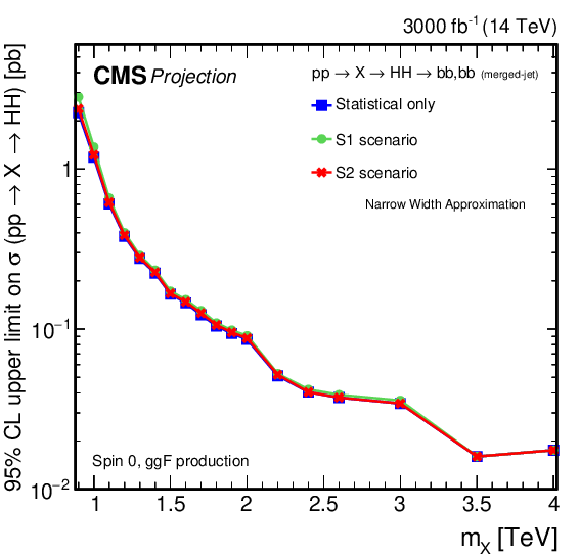
png pdf |
Figure 44-c:
Expected upper limits at 95% CL, on the product of the cross section for the production of a spin-0 resonance X and the branching fraction $ \mathcal{B}(\mathrm{X} \to\mathrm{H}\mathrm{H}) $, as functions of $ m_{\mathrm{X}} $ from the (upper left) $ \mathrm{b}\mathrm{b}\tau\tau $ [115], (upper right) $ \mathrm{b}\mathrm{b}\gamma\gamma $ [116], and (lower) $ \mathrm{b}\mathrm{b}\mathrm{b}\mathrm{b} $ with two merged $ \mathrm{b}\mathrm{b} $ jets [117] analyses discussed in this report, projected to an integrated luminosity of 3000 fb$ ^{-1} $ under the assumption of different systematic uncertainty scenarios, as discussed in the text. All estimates include the anticipated statistical uncertainties. |
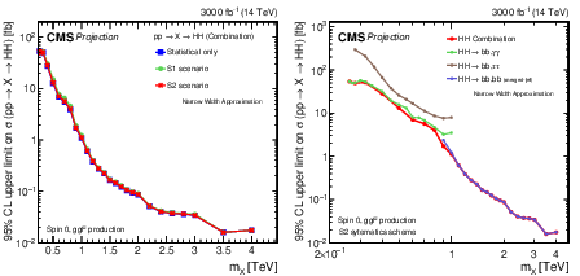
png pdf |
Figure 45:
Expected upper limits at 95% CL, on the product of the cross section for the production of a spin-0 resonance X and the branching fraction $ \mathcal{B}(\mathrm{X} \to\mathrm{H}\mathrm{H}) $, as a function of $ m_{\mathrm{X}} $, for an integrated luminosity of 3000 fb$ ^{-1} $ and the combination of the three analyses shown in Fig. 44. Shown are the effects of the different systematic uncertainty scenarios (left), and the reach of the individual analyses for the S2 systematic scenario (right). All estimates include the anticipated statistical uncertainties. |
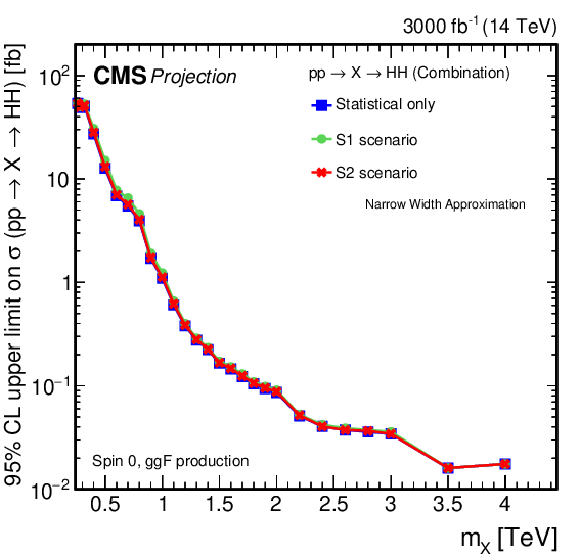
png pdf |
Figure 45-a:
Expected upper limits at 95% CL, on the product of the cross section for the production of a spin-0 resonance X and the branching fraction $ \mathcal{B}(\mathrm{X} \to\mathrm{H}\mathrm{H}) $, as a function of $ m_{\mathrm{X}} $, for an integrated luminosity of 3000 fb$ ^{-1} $ and the combination of the three analyses shown in Fig. 44. Shown are the effects of the different systematic uncertainty scenarios (left), and the reach of the individual analyses for the S2 systematic scenario (right). All estimates include the anticipated statistical uncertainties. |

png pdf |
Figure 45-b:
Expected upper limits at 95% CL, on the product of the cross section for the production of a spin-0 resonance X and the branching fraction $ \mathcal{B}(\mathrm{X} \to\mathrm{H}\mathrm{H}) $, as a function of $ m_{\mathrm{X}} $, for an integrated luminosity of 3000 fb$ ^{-1} $ and the combination of the three analyses shown in Fig. 44. Shown are the effects of the different systematic uncertainty scenarios (left), and the reach of the individual analyses for the S2 systematic scenario (right). All estimates include the anticipated statistical uncertainties. |
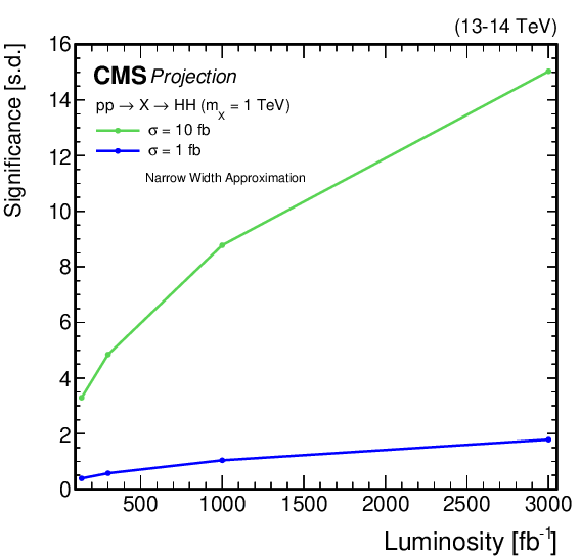
png pdf |
Figure 46:
Expected discovery significance for a spin-0 resonance X with $ m_{\mathrm{X}}= $ 1 TeV and cross sections of 1 and 10 fb, obtained for the combined likelihood analysis of the resonant HH searches as discussed in Section 5 and shown in Figs. 44 and 45, shown as function of the integrated luminosity. |
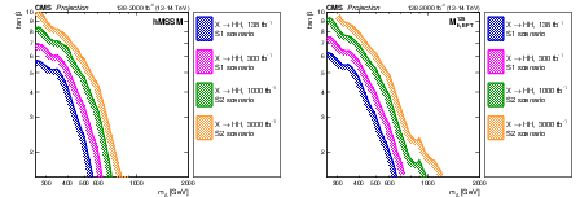
png pdf |
Figure 47:
Expected exclusion contours at 95% CL, in the ($ \tan\beta $, $ m_{{\mathrm{A}}} $) plane of the (left) hMSSM and (right) $ M^{125}_{\text{h,EFT}} $ scenarios obtained from the combined likelihood analysis of the HH searches discussed in Section 4.1 and shown in Figs. 31 and 32, for different integrated luminosities and compared to the Run 2 result obtained at $ \sqrt{s}= $ 13 TeV. The projections assume $ \sqrt{s}= $ 14 TeV. |
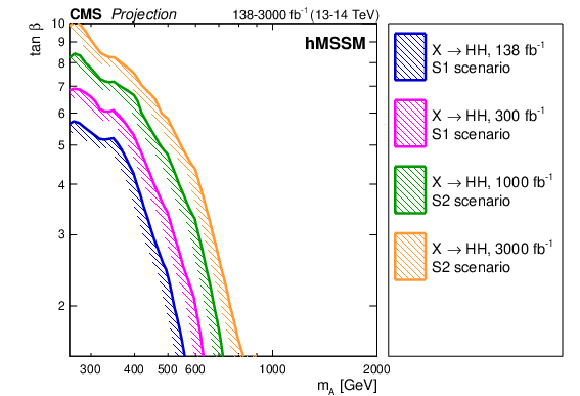
png pdf |
Figure 47-a:
Expected exclusion contours at 95% CL, in the ($ \tan\beta $, $ m_{{\mathrm{A}}} $) plane of the (left) hMSSM and (right) $ M^{125}_{\text{h,EFT}} $ scenarios obtained from the combined likelihood analysis of the HH searches discussed in Section 4.1 and shown in Figs. 31 and 32, for different integrated luminosities and compared to the Run 2 result obtained at $ \sqrt{s}= $ 13 TeV. The projections assume $ \sqrt{s}= $ 14 TeV. |

png pdf |
Figure 47-b:
Expected exclusion contours at 95% CL, in the ($ \tan\beta $, $ m_{{\mathrm{A}}} $) plane of the (left) hMSSM and (right) $ M^{125}_{\text{h,EFT}} $ scenarios obtained from the combined likelihood analysis of the HH searches discussed in Section 4.1 and shown in Figs. 31 and 32, for different integrated luminosities and compared to the Run 2 result obtained at $ \sqrt{s}= $ 13 TeV. The projections assume $ \sqrt{s}= $ 14 TeV. |
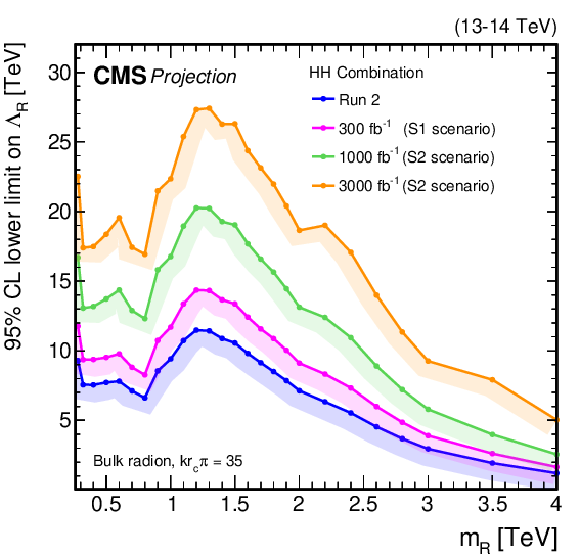
png pdf |
Figure 48:
Expected lower limit at 95% CL, on $ \Lambda_{\mathrm{R}} $ in the warped extra dimensions bulk scenario for the production of a radion R, as a function of $ m_{{\mathrm{R}} } $. The limits are derived from the combined likelihood analysis of the HH searches discussed in Section 4.2 and shown in Fig. 35, for different values of the integrated luminosity. Excluded areas are indicated by the direction of the hatching along the exclusion contours. |
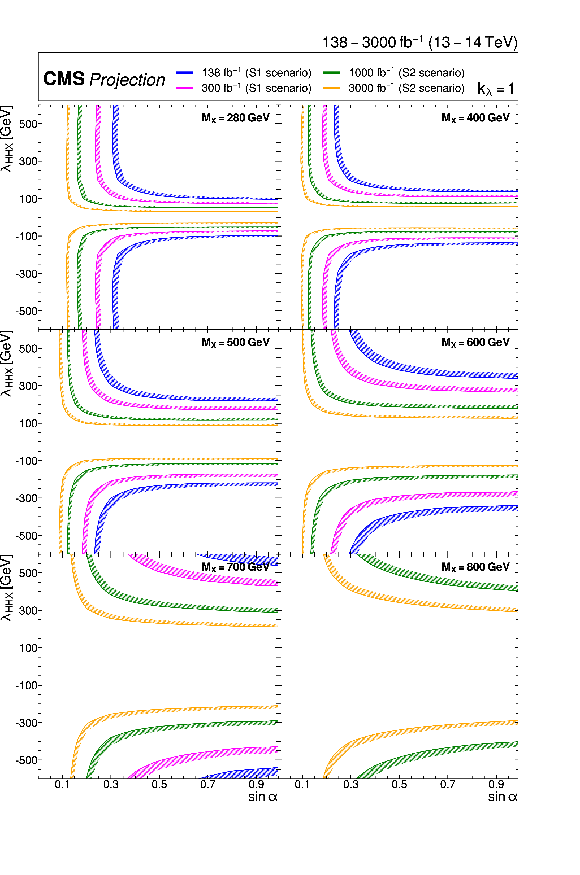
png pdf |
Figure 49:
Exclusion contours at 95% CL, in the ($ \sin\alpha $, $ \lambda_{\mathrm{H}\mathrm{H}\mathrm{X}} $) plane for $ k_{\lambda} = $ 1 in the real-singlet model. These contours are obtained from the combined likelihood analysis of the HH searches discussed in Section 4.1 for (upper left to lower right) $ m_{\mathrm{X}} = $ 280, 400, 500, 600, 700, and 1000 GeV. The expected limits from the Run 2 dataset have been projected to integrated luminosities of 300, 1000, and 3000 fb$ ^{-1} $. Excluded areas are indicated by the direction of the hatching along the exclusion contours. |
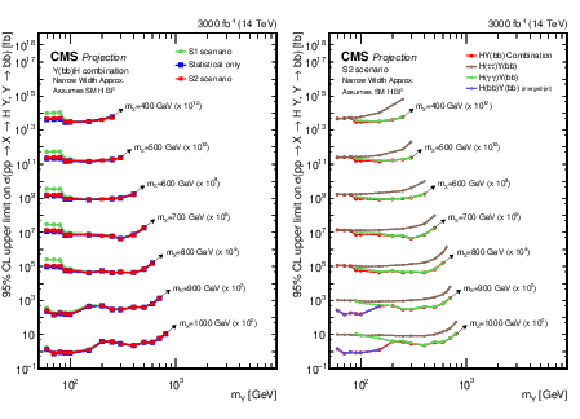
png pdf |
Figure 50:
Expected upper limits at 95% CL, on the product of the cross section $ \sigma $ for the production of a resonance X via gluon-gluon fusion and the branching fraction $ \mathcal{B} $ for the $ \mathrm{X}\to{\mathrm{Y}}(\mathrm{b}\mathrm{b})\mathrm{H} $ decay, as functions of $ m_{{\mathrm{Y}}} $, for $ m_{\mathrm{X}}\leq $ 1 TeV. For the branching fractions of the $ \mathrm{H}\to\tau\tau $, $ \mathrm{H}\to\gamma\gamma $ and $ \mathrm{H}\to\mathrm{b}\mathrm{b} $ decays, the SM values are assumed. The limits are obtained from the combined likelihood analysis of all analyses discussed in Section 3.3 and shown in Fig. 29, projected to an integrated luminosity of 3000 fb$ ^{-1} $. Shown are the projections for the combined likelihood analysis for different systematic uncertainty scenarios (left), and the projections for the combined likelihood analysis and the individual contributing analyses assuming the S2 scenario (right). For presentation purposes, the limits have been scaled in successive steps by two orders of magnitude. For each set of graphs, a black arrow points to the $ m_{\mathrm{X}} $ related legend. |

png pdf |
Figure 50-a:
Expected upper limits at 95% CL, on the product of the cross section $ \sigma $ for the production of a resonance X via gluon-gluon fusion and the branching fraction $ \mathcal{B} $ for the $ \mathrm{X}\to{\mathrm{Y}}(\mathrm{b}\mathrm{b})\mathrm{H} $ decay, as functions of $ m_{{\mathrm{Y}}} $, for $ m_{\mathrm{X}}\leq $ 1 TeV. For the branching fractions of the $ \mathrm{H}\to\tau\tau $, $ \mathrm{H}\to\gamma\gamma $ and $ \mathrm{H}\to\mathrm{b}\mathrm{b} $ decays, the SM values are assumed. The limits are obtained from the combined likelihood analysis of all analyses discussed in Section 3.3 and shown in Fig. 29, projected to an integrated luminosity of 3000 fb$ ^{-1} $. Shown are the projections for the combined likelihood analysis for different systematic uncertainty scenarios (left), and the projections for the combined likelihood analysis and the individual contributing analyses assuming the S2 scenario (right). For presentation purposes, the limits have been scaled in successive steps by two orders of magnitude. For each set of graphs, a black arrow points to the $ m_{\mathrm{X}} $ related legend. |
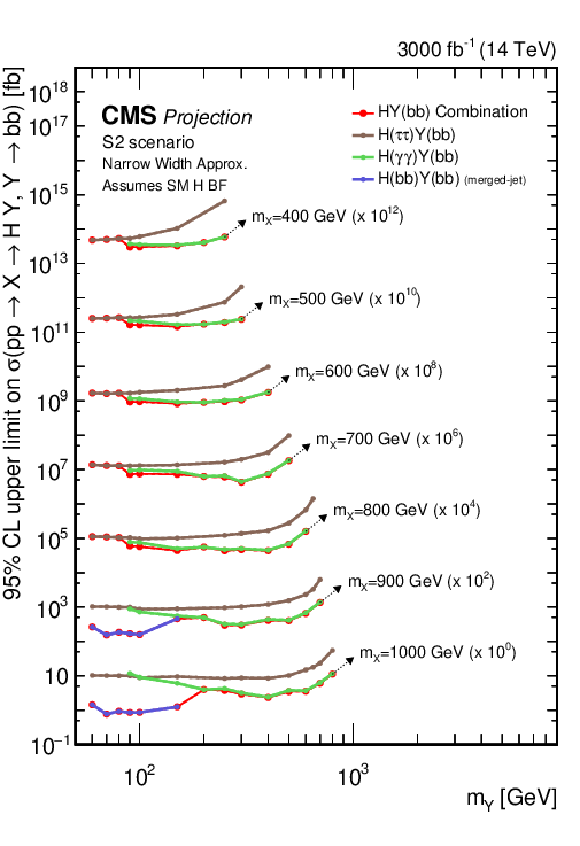
png pdf |
Figure 50-b:
Expected upper limits at 95% CL, on the product of the cross section $ \sigma $ for the production of a resonance X via gluon-gluon fusion and the branching fraction $ \mathcal{B} $ for the $ \mathrm{X}\to{\mathrm{Y}}(\mathrm{b}\mathrm{b})\mathrm{H} $ decay, as functions of $ m_{{\mathrm{Y}}} $, for $ m_{\mathrm{X}}\leq $ 1 TeV. For the branching fractions of the $ \mathrm{H}\to\tau\tau $, $ \mathrm{H}\to\gamma\gamma $ and $ \mathrm{H}\to\mathrm{b}\mathrm{b} $ decays, the SM values are assumed. The limits are obtained from the combined likelihood analysis of all analyses discussed in Section 3.3 and shown in Fig. 29, projected to an integrated luminosity of 3000 fb$ ^{-1} $. Shown are the projections for the combined likelihood analysis for different systematic uncertainty scenarios (left), and the projections for the combined likelihood analysis and the individual contributing analyses assuming the S2 scenario (right). For presentation purposes, the limits have been scaled in successive steps by two orders of magnitude. For each set of graphs, a black arrow points to the $ m_{\mathrm{X}} $ related legend. |
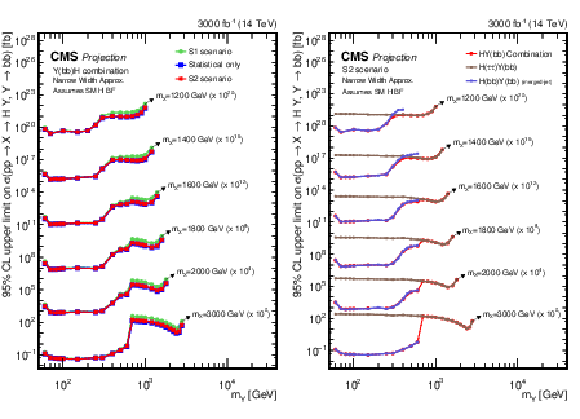
png pdf |
Figure 51:
Expected upper limits at 95% CL, on the product of the cross section $ \sigma $ for the production of a resonance X via gluon-gluon fusion and the branching fraction $ \mathcal{B} $ for the $ \mathrm{X}\to{\mathrm{Y}}(\mathrm{b}\mathrm{b})\mathrm{H} $ decay, as functions of $ m_{{\mathrm{Y}}} $, for $ m_{\mathrm{X}}\geq $ 1.2 TeV. For the branching fractions of the $ \mathrm{H}\to\tau\tau $ and $ \mathrm{H}\to\mathrm{b}\mathrm{b} $ decays, the SM values are assumed. The limits are obtained from the combined likelihood analysis of all analyses discussed in Section 3.3 and shown in Fig. 30, projected to an integrated luminosity of 3000 fb$ ^{-1} $. Shown are the projections for the combined likelihood analysis for different systematic uncertainty scenarios (left), and the projections for the combined likelihood analysis and the individual contributing analyses assuming the S2 scenario (right). For presentation purposes, the limits have been scaled in successive steps by four orders of magnitude. For each set of graphs, a black arrow points to the $ m_{\mathrm{X}} $ related legend. |
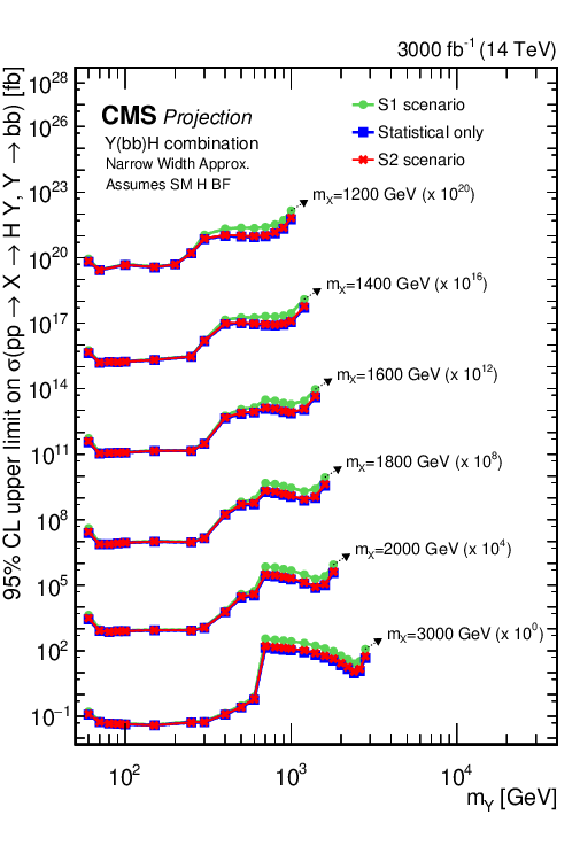
png pdf |
Figure 51-a:
Expected upper limits at 95% CL, on the product of the cross section $ \sigma $ for the production of a resonance X via gluon-gluon fusion and the branching fraction $ \mathcal{B} $ for the $ \mathrm{X}\to{\mathrm{Y}}(\mathrm{b}\mathrm{b})\mathrm{H} $ decay, as functions of $ m_{{\mathrm{Y}}} $, for $ m_{\mathrm{X}}\geq $ 1.2 TeV. For the branching fractions of the $ \mathrm{H}\to\tau\tau $ and $ \mathrm{H}\to\mathrm{b}\mathrm{b} $ decays, the SM values are assumed. The limits are obtained from the combined likelihood analysis of all analyses discussed in Section 3.3 and shown in Fig. 30, projected to an integrated luminosity of 3000 fb$ ^{-1} $. Shown are the projections for the combined likelihood analysis for different systematic uncertainty scenarios (left), and the projections for the combined likelihood analysis and the individual contributing analyses assuming the S2 scenario (right). For presentation purposes, the limits have been scaled in successive steps by four orders of magnitude. For each set of graphs, a black arrow points to the $ m_{\mathrm{X}} $ related legend. |
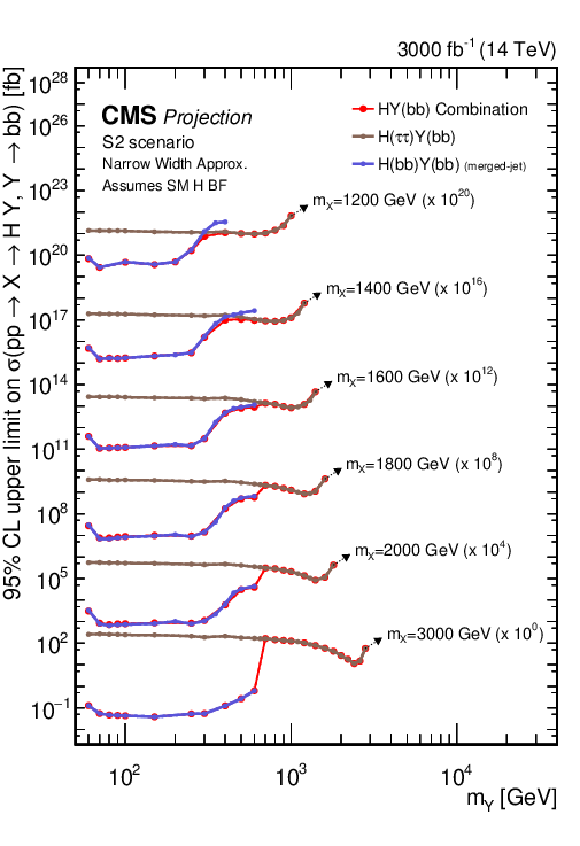
png pdf |
Figure 51-b:
Expected upper limits at 95% CL, on the product of the cross section $ \sigma $ for the production of a resonance X via gluon-gluon fusion and the branching fraction $ \mathcal{B} $ for the $ \mathrm{X}\to{\mathrm{Y}}(\mathrm{b}\mathrm{b})\mathrm{H} $ decay, as functions of $ m_{{\mathrm{Y}}} $, for $ m_{\mathrm{X}}\geq $ 1.2 TeV. For the branching fractions of the $ \mathrm{H}\to\tau\tau $ and $ \mathrm{H}\to\mathrm{b}\mathrm{b} $ decays, the SM values are assumed. The limits are obtained from the combined likelihood analysis of all analyses discussed in Section 3.3 and shown in Fig. 30, projected to an integrated luminosity of 3000 fb$ ^{-1} $. Shown are the projections for the combined likelihood analysis for different systematic uncertainty scenarios (left), and the projections for the combined likelihood analysis and the individual contributing analyses assuming the S2 scenario (right). For presentation purposes, the limits have been scaled in successive steps by four orders of magnitude. For each set of graphs, a black arrow points to the $ m_{\mathrm{X}} $ related legend. |
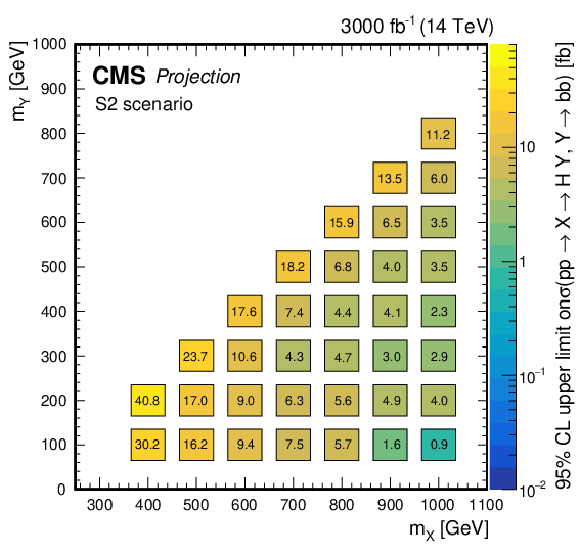
png pdf |
Figure 52:
Expected upper limits at 95 % CL on the product of the cross section $ \sigma $ for the production of a resonance X via gluon-gluon fusion and the branching fraction $ \mathcal{B} $ for the $ \mathrm{X}\to{\mathrm{Y}}(\mathrm{b}\mathrm{b})\mathrm{H} $ decay, as obtained from the combined likelihood analysis of the individual analyses presented in Section 3.3 and Figure 29. The results are shown in the plane spanned by $ m_{{\mathrm{Y}}} $ and $ m_{\mathrm{X}} $ for $ m_{\mathrm{X}}\le $ 1 TeV, and projected to an integrated luminosity of 3000 fb$ ^{-1} $, assuming the S2 systematic uncertainty scenario. The numbers in the boxes are given in fb. |

png pdf |
Figure 53:
Interpretation of the upper limits at 95% CL, on the product of the cross section $ \sigma $ for the production of a resonance X via gluon-gluon fusion and the branching fraction $ \mathcal{B} $ for the $ \mathrm{X}\to{\mathrm{Y}}(\mathrm{b}\mathrm{b})\mathrm{H} $ decay, obtained from the projections to an integrated luminosity of 3000 fb$ ^{-1} $ of the (upper left) $ {\mathrm{Y}}(\mathrm{b}\mathrm{b})\mathrm{H}(\gamma\gamma) $ [116], (upper right) $ {\mathrm{Y}}(\mathrm{b}\mathrm{b})\mathrm{H}(\tau\tau) $ [115], and (lower row) $ {\mathrm{Y}}(\mathrm{b}\mathrm{b})\mathrm{H}(\mathrm{b}\mathrm{b}) $ [117] analyses, assuming the S2 systematic uncertainty scenario. The projected limits are mapped onto the ($ m_{\mathrm{X}} $, $ m_{{\mathrm{Y}}} $) plane, and compared with the maximally allowed cross sections of the NMSSM (left and upper right), and TRSM models (lower right) discussed in Section 4.1.3. The points indicate the available theory predictions. The mass dependences of both the projected experimental limits and the maximally allowed theory cross sections have been interpolated to obtain approximate exclusion contours. The NMSSM predictions based on NMSSMTOOLS version 5.6.2 are adapted from Ref. [193], whereas the TRSM is described in Ref. [12]. In both cases, the model predictions have been scaled to $ \sqrt{s}= $ 14 TeV. |
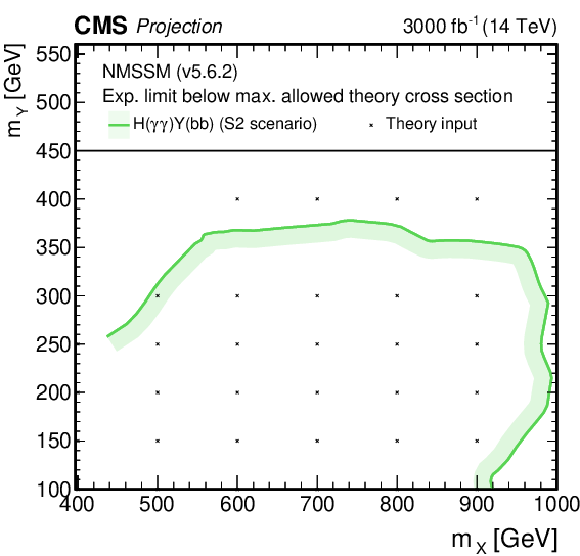
png pdf |
Figure 53-a:
Interpretation of the upper limits at 95% CL, on the product of the cross section $ \sigma $ for the production of a resonance X via gluon-gluon fusion and the branching fraction $ \mathcal{B} $ for the $ \mathrm{X}\to{\mathrm{Y}}(\mathrm{b}\mathrm{b})\mathrm{H} $ decay, obtained from the projections to an integrated luminosity of 3000 fb$ ^{-1} $ of the (upper left) $ {\mathrm{Y}}(\mathrm{b}\mathrm{b})\mathrm{H}(\gamma\gamma) $ [116], (upper right) $ {\mathrm{Y}}(\mathrm{b}\mathrm{b})\mathrm{H}(\tau\tau) $ [115], and (lower row) $ {\mathrm{Y}}(\mathrm{b}\mathrm{b})\mathrm{H}(\mathrm{b}\mathrm{b}) $ [117] analyses, assuming the S2 systematic uncertainty scenario. The projected limits are mapped onto the ($ m_{\mathrm{X}} $, $ m_{{\mathrm{Y}}} $) plane, and compared with the maximally allowed cross sections of the NMSSM (left and upper right), and TRSM models (lower right) discussed in Section 4.1.3. The points indicate the available theory predictions. The mass dependences of both the projected experimental limits and the maximally allowed theory cross sections have been interpolated to obtain approximate exclusion contours. The NMSSM predictions based on NMSSMTOOLS version 5.6.2 are adapted from Ref. [193], whereas the TRSM is described in Ref. [12]. In both cases, the model predictions have been scaled to $ \sqrt{s}= $ 14 TeV. |
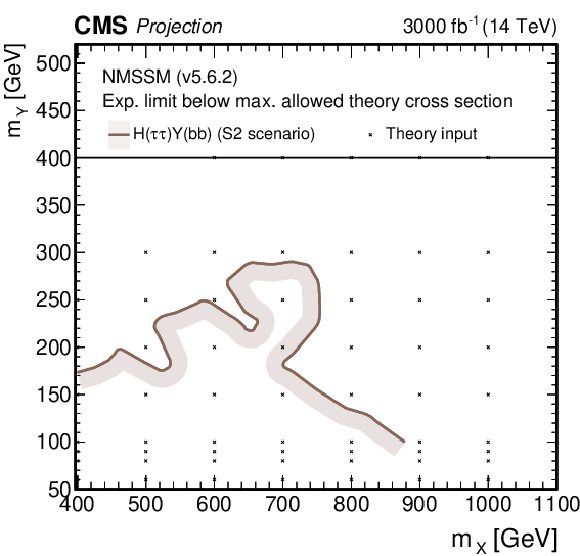
png pdf |
Figure 53-b:
Interpretation of the upper limits at 95% CL, on the product of the cross section $ \sigma $ for the production of a resonance X via gluon-gluon fusion and the branching fraction $ \mathcal{B} $ for the $ \mathrm{X}\to{\mathrm{Y}}(\mathrm{b}\mathrm{b})\mathrm{H} $ decay, obtained from the projections to an integrated luminosity of 3000 fb$ ^{-1} $ of the (upper left) $ {\mathrm{Y}}(\mathrm{b}\mathrm{b})\mathrm{H}(\gamma\gamma) $ [116], (upper right) $ {\mathrm{Y}}(\mathrm{b}\mathrm{b})\mathrm{H}(\tau\tau) $ [115], and (lower row) $ {\mathrm{Y}}(\mathrm{b}\mathrm{b})\mathrm{H}(\mathrm{b}\mathrm{b}) $ [117] analyses, assuming the S2 systematic uncertainty scenario. The projected limits are mapped onto the ($ m_{\mathrm{X}} $, $ m_{{\mathrm{Y}}} $) plane, and compared with the maximally allowed cross sections of the NMSSM (left and upper right), and TRSM models (lower right) discussed in Section 4.1.3. The points indicate the available theory predictions. The mass dependences of both the projected experimental limits and the maximally allowed theory cross sections have been interpolated to obtain approximate exclusion contours. The NMSSM predictions based on NMSSMTOOLS version 5.6.2 are adapted from Ref. [193], whereas the TRSM is described in Ref. [12]. In both cases, the model predictions have been scaled to $ \sqrt{s}= $ 14 TeV. |
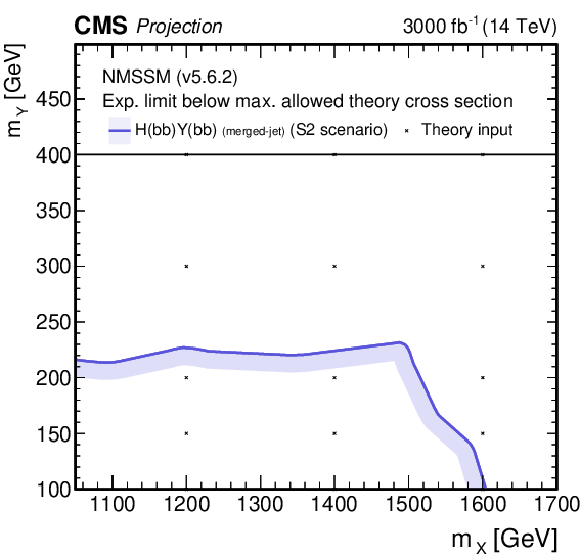
png pdf |
Figure 53-c:
Interpretation of the upper limits at 95% CL, on the product of the cross section $ \sigma $ for the production of a resonance X via gluon-gluon fusion and the branching fraction $ \mathcal{B} $ for the $ \mathrm{X}\to{\mathrm{Y}}(\mathrm{b}\mathrm{b})\mathrm{H} $ decay, obtained from the projections to an integrated luminosity of 3000 fb$ ^{-1} $ of the (upper left) $ {\mathrm{Y}}(\mathrm{b}\mathrm{b})\mathrm{H}(\gamma\gamma) $ [116], (upper right) $ {\mathrm{Y}}(\mathrm{b}\mathrm{b})\mathrm{H}(\tau\tau) $ [115], and (lower row) $ {\mathrm{Y}}(\mathrm{b}\mathrm{b})\mathrm{H}(\mathrm{b}\mathrm{b}) $ [117] analyses, assuming the S2 systematic uncertainty scenario. The projected limits are mapped onto the ($ m_{\mathrm{X}} $, $ m_{{\mathrm{Y}}} $) plane, and compared with the maximally allowed cross sections of the NMSSM (left and upper right), and TRSM models (lower right) discussed in Section 4.1.3. The points indicate the available theory predictions. The mass dependences of both the projected experimental limits and the maximally allowed theory cross sections have been interpolated to obtain approximate exclusion contours. The NMSSM predictions based on NMSSMTOOLS version 5.6.2 are adapted from Ref. [193], whereas the TRSM is described in Ref. [12]. In both cases, the model predictions have been scaled to $ \sqrt{s}= $ 14 TeV. |
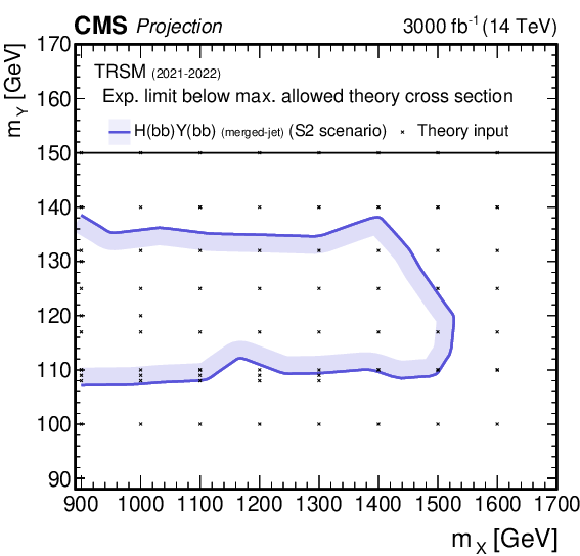
png pdf |
Figure 53-d:
Interpretation of the upper limits at 95% CL, on the product of the cross section $ \sigma $ for the production of a resonance X via gluon-gluon fusion and the branching fraction $ \mathcal{B} $ for the $ \mathrm{X}\to{\mathrm{Y}}(\mathrm{b}\mathrm{b})\mathrm{H} $ decay, obtained from the projections to an integrated luminosity of 3000 fb$ ^{-1} $ of the (upper left) $ {\mathrm{Y}}(\mathrm{b}\mathrm{b})\mathrm{H}(\gamma\gamma) $ [116], (upper right) $ {\mathrm{Y}}(\mathrm{b}\mathrm{b})\mathrm{H}(\tau\tau) $ [115], and (lower row) $ {\mathrm{Y}}(\mathrm{b}\mathrm{b})\mathrm{H}(\mathrm{b}\mathrm{b}) $ [117] analyses, assuming the S2 systematic uncertainty scenario. The projected limits are mapped onto the ($ m_{\mathrm{X}} $, $ m_{{\mathrm{Y}}} $) plane, and compared with the maximally allowed cross sections of the NMSSM (left and upper right), and TRSM models (lower right) discussed in Section 4.1.3. The points indicate the available theory predictions. The mass dependences of both the projected experimental limits and the maximally allowed theory cross sections have been interpolated to obtain approximate exclusion contours. The NMSSM predictions based on NMSSMTOOLS version 5.6.2 are adapted from Ref. [193], whereas the TRSM is described in Ref. [12]. In both cases, the model predictions have been scaled to $ \sqrt{s}= $ 14 TeV. |
| Tables | |

png pdf |
Table 1:
Summary of all analyses discussed in Section 2. Note that the list of sub-channels is not exhaustive in all cases. All analyses listed under YH also contribute to the HH measurements. |

png pdf |
Table 2:
Searches for resonant HH and YH production considered for the projection study. |
| Summary |
| The analyses searching for the production of the Higgs (H) boson through decays of heavy resonances, performed by the CMS Collaboration using the Run 2 data set, are reviewed. This review covers final states with two bosons with at least one an H boson, namely an H boson and a vector boson (VH), a pair of H bosons (HH), and an H boson joined by a new boson Y (YH), where V represents a W or a Z boson. The analyses cover a wide range of H boson decay modes, in particular, decays into photons, b quarks, $ \tau $ leptons, and W bosons. The Y boson is exclusively searched for in b quark final states. Topologies involving both resolved and merged jet objects are used to cover a wide range of the phase space. Multivariate methods are employed in various ways to improve the performance. The results are presented as summary plots which show the sensitivity of all channels in direct comparison. For the HH and YH final states, the results obtained by combining all decay channels are presented for the first time. The results are interpreted in the context of relevant beyond-the-standard model scenarios for resonances decaying into VH, HH and YH final states. These include various extended Higgs sector models, warped extra-dimension models, and heavy vector triplet models. The results from resonant H boson production searches are compared with results from searches in other channels. While all presented analyses assume the validity of the narrow-width approximation, a dedicated study of the impact of finite width and interference is performed for the first time in CMS for the real singlet extension of the standard model. This study shows the modification of the HH cross section and line shape in regions of the parameter space where the narrow-width approximation is not valid anymore. The expected sensitivity of the analyses in the HH and YH final states is estimated for future data sets with integrated luminosities of 300, 1000, and 3000 fb$ ^{-1} $, the last number corresponding to the baseline scenario of the High-Luminosity LHC (HL-LHC) over its full lifetime. The expected upper limits for resonant HH production for the HL-LHC scenario range from about 50 fb at a resonance mass of 300 GeV to nearly 0.01 fb for masses of 3 TeV and above. The exclusions in terms of $ \tan\beta $ in the hMSSM and $ M^{125}_{\text{h,EFT}} $ scenarios are expanded by almost a factor of two compared to the Run 2 data set. This review shows how the specific strengths of many different experimental signatures can be combined to chart very thoroughly the territory where resonant Higgs boson production might reveal beyond the standard model physics, and gives a promising outlook towards the achievement potential of future measurements in this sector. |
| Additional Figures | |
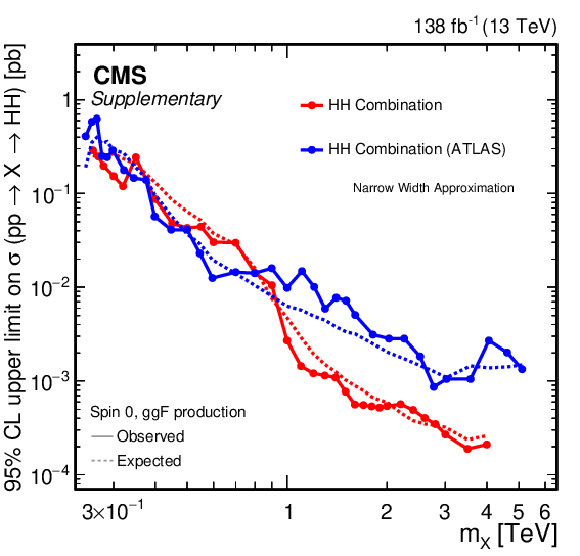
png pdf |
Additional Figure 1:
Observed and expected 95% CL upper limits on the product of the cross section $ \sigma $ for the production of a spin-0 resonance X, via gluon-gluon fusion and the branching fraction $ \mathcal{B} $ for the decay into a pair of H bosons. The combined results of the CMS analyses are shown in red, while the combination from ATLAS [168] is shown in blue. The observed limits are indicated by markers connected with solid lines and the expected limits by dashed lines. |
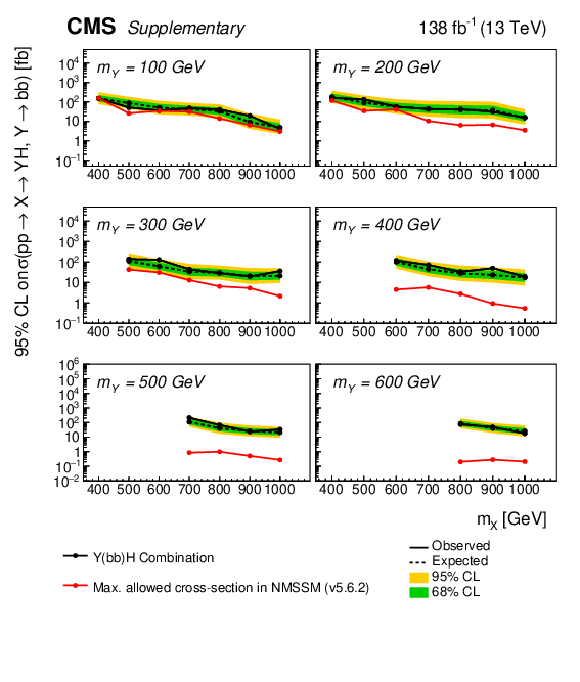
png pdf |
Additional Figure 2:
Observed and expected upper limits at 95% CL, on the product of the cross section $ \sigma $ for the production of a resonance X via gluon-gluon fusion and the branching fraction $ \mathcal{B} $ for the $ \mathrm{X}\to{\mathrm{Y}}(\mathrm{b}\mathrm{b})\mathrm{H} $ decay, as obtained from a combined likelihood analysis of several individual channels. The results are presented as a function of $ m_{\mathrm{X}} $ for six values of $ m_{{\mathrm{Y}}} $. The corresponding maximally allowed values of $ \sigma\mathcal{B} $ in the NMSSM are also shown for comparison, as adapted from Ref. [193], which accounts for experimental constraints as defined in version 5.6.2 of the program NMSSMTOOLS. |
| References | ||||
| 1 | ATLAS Collaboration | Observation of a new particle in the search for the standard model Higgs boson with the ATLAS detector at the LHC | PLB 716 (2012) 1 | 1207.7214 |
| 2 | CMS Collaboration | Observation of a new boson at a mass of 125 GeV with the CMS experiment at the LHC | PLB 716 (2012) 30 | CMS-HIG-12-028 1207.7235 |
| 3 | CMS Collaboration | Observation of a new boson with mass near 125 GeV in pp collisions at $ \sqrt{s} = $ 7 and 8 TeV | JHEP 06 (2013) 081 | CMS-HIG-12-036 1303.4571 |
| 4 | CMS Collaboration | A portrait of the Higgs boson by the CMS experiment ten years after the discovery | Nature 607 (2022) 60 | CMS-HIG-22-001 2207.00043 |
| 5 | T. D. Lee | A theory of spontaneous $ T $ violation | PRD 8 (1973) 1226 | |
| 6 | G. C. Branco et al. | Theory and phenomenology of two-Higgs-doublet models | Phys. Rept. 516 (2012) 1 | 1106.0034 |
| 7 | H. E. Haber and O. St \aa l | New LHC benchmarks for the $ \mathcal{CP} $-conserving two-Higgs-doublet model | EPJC 75 (2015) 491 | 1507.04281 |
| 8 | F. Kling, J. M. No, and S. Su | Anatomy of exotic Higgs decays in 2HDM | JHEP 09 (2016) 093 | 1604.01406 |
| 9 | G. Chalons and F. Domingo | Analysis of the Higgs potentials for two doublets and a singlet | PRD 86 (2012) 115024 | 1209.6235 |
| 10 | C.-Y. Chen, M. Freid, and M. Sher | Next-to-minimal two Higgs doublet model | PRD 89 (2014) 075009 | 1312.3949 |
| 11 | M. Mühlleitner, M. O. P. Sampaio, R. Santos, and J. Wittbrodt | The N2HDM under theoretical and experimental scrutiny | JHEP 03 (2017) 094 | 1612.01309 |
| 12 | T. Robens, T. Stefaniak, and J. Wittbrodt | Two-real-scalar-singlet extension of the SM: LHC phenomenology and benchmark scenarios | EPJC 80 (2020) 151 | 1908.08554 |
| 13 | J. F. Gunion and H. E. Haber | Higgs bosons in supersymmetric models (1) | NPB 272 (1986) 1 | |
| 14 | J. F. Gunion and H. E. Haber | Higgs bosons in supersymmetric models (II). Implications for phenomenology | NPB 278 (1986) 449 | |
| 15 | G. Degrassi et al. | Towards high precision predictions for the MSSM Higgs sector | EPJC 28 (2003) 133 | hep-ph/0212020 |
| 16 | A. Djouadi | The anatomy of electroweak symmetry breaking Tome II: The Higgs bosons in the minimal supersymmetric model | Phys. Rept. 459 (2008) 1 | hep-ph/0503173 |
| 17 | M. Maniatis | The next-to-minimal supersymmetric extension of the standard model reviewed | Int. J. Mod. Phys. A 25 (2010) 3505 | 0906.0777 |
| 18 | U. Ellwanger, C. Hugonie, and A. M. Teixeira | The next-to-minimal supersymmetric standard model | Phys. Rept. 496 (2010) 1 | 0910.1785 |
| 19 | S. F. King, M. Mühlleitner, and R. Nevzorov | NMSSM Higgs benchmarks near 125 GeV | Nucl. Phys. B. 860 (2012) 207 | 1201.2671 |
| 20 | L. Randall and R. Sundrum | Large mass hierarchy from a small extra dimension | PRL 83 (1999) 3370 | hep-ph/9905221 |
| 21 | W. D. Goldberger and M. B. Wise | Modulus stabilization with bulk fields | PRL 83 (1999) 4922 | hep-ph/9907447 |
| 22 | O. DeWolfe, D. Z. Freedman, S. S. Gubser, and A. Karch | Modeling the fifth dimension with scalars and gravity | PRD 62 (2000) 046008 | hep-th/9909134 |
| 23 | C. Csàki, M. Graesser, L. Randall, and J. Terning | Cosmology of brane models with radion stabilization | PRD 62 (2000) 045015 | hep-ph/9911406 |
| 24 | H. Davoudiasl, J. L. Hewett, and T. G. Rizzo | Phenomenology of the Randall--Sundrum gauge hierarchy model | PRL 84 (2000) 2080 | hep-ph/9909255 |
| 25 | C. Csaki, M. L. Graesser, and G. D. Kribs | Radion dynamics and electroweak physics | PRD 63 (2001) 065002 | hep-th/0008151 |
| 26 | K. Agashe, H. Davoudiasl, G. Perez, and A. Soni | Warped gravitons at the CERN LHC and beyond | PRD 76 (2007) 036006 | hep-ph/0701186 |
| 27 | A. L. Fitzpatrick, J. Kaplan, L. Randall, and L.-T. Wang | Searching for the Kaluza-Klein graviton in bulk RS models | JHEP 09 (2007) 013 | hep-ph/0701150 |
| 28 | A. Oliveira | Gravity particles from warped extra dimensions, predictions for LHC | 1404.0102 | |
| 29 | G. F. Giudice, R. Rattazzi, and J. D. Wells | Graviscalars from higher-dimensional metrics and curvature-Higgs mixing | NPB 595 (2001) 250 | hep-ph/0002178 |
| 30 | D. Pappadopulo, A. Thamm, R. Torre, and A. Wulzer | Heavy vector triplets: Bridging theory and data | JHEP 09 (2014) 060 | 1402.4431 |
| 31 | CMS Collaboration | HEPData record for this analysis | link | |
| 32 | P. W. Higgs | Broken symmetries, massless particles and gauge fields | PL 12 (1964) 132 | |
| 33 | P. W. Higgs | Spontaneous symmetry breakdown without massless bosons | PR 145 (1966) 1156 | |
| 34 | F. Englert and R. Brout | Broken symmetry and the mass of gauge vector mesons | PRL 13 (1964) 321 | |
| 35 | M. Cepeda et al. | Handbook of LHC Higgs cross sections: 4. Deciphering the nature of the Higgs sector | CERN Report CERN-2017-002-M, 2016 link |
1610.07922 |
| 36 | ATLAS Collaboration | Measurement of the Higgs boson mass with $ \mathrm{H}\to\gamma\gamma $ decays in 140 fb$ ^{-1} $ of $ \sqrt{s}= $13\,TeV pp collisions with the ATLAS detector | PLB 847 (2023) 138315 | 2308.07216 |
| 37 | CMS Collaboration | Measurement of the Higgs boson width and evidence of its off-shell contributions to ZZ production | Nature Phys. 18 (2022) 1329 | CMS-HIG-21-013 2202.06923 |
| 38 | LHC Higgs Cross Section Working Group | Handbook of LHC Higgs Cross Sections: 3. Higgs Properties: Report of the LHC Higgs Cross Section Working Group | in CERN Yellow Reports: Monographs, 2013 CERN-2013-004 |
|
| 39 | F. Bezrukov and M. Shaposhnikov | Inflation, LHC and the Higgs boson | C. R. Phys. 16 (2015) 994 | |
| 40 | F. L. Bezrukov and M. Shaposhnikov | The standard model Higgs boson as the inflaton | PLB 659 (2008) 703 | 0710.3755 |
| 41 | Y. Hamada and M. Yamada | Baryogenesis in false vacuum | EPJC 77 (2017) 643 | 1605.06897 |
| 42 | I. P. Ivanov | Building and testing models with extended Higgs sectors | Prog. Part. Nucl. Phys. 95 (2017) 160 | 1702.03776 |
| 43 | S. Dawson, C. Englert, and T. Plehn | Higgs Physics: It ain't over till it's over | Phys. Rept. 816 (2019) 1 | 1808.01324 |
| 44 | J. Steggemann | Extended scalar sectors | Ann. Rev. Nucl. Part. Sci. 70 (2020) 197 | |
| 45 | Particle Data Group | Review of particle physics | Prog. Theor. Exp. Phys. 2022 (2022) 083C01 | |
| 46 | C. Englert et al. | Precision measurements of Higgs couplings: Implications for new physics scales | JPG 41 (2014) 113001 | 1403.7191 |
| 47 | CMS Collaboration | Combined measurements of Higgs boson couplings in proton-proton collisions at $ \sqrt{s}=$ 13 TeV | EPJC 79 (2019) 421 | CMS-HIG-17-031 1809.10733 |
| 48 | ATLAS Collaboration | Combined measurements of Higgs boson production and decay using up to 80 fb$ ^{-1} $ of proton-proton collision data at $ \sqrt{s}= $ 13 TeV collected with the ATLAS experiment | PRD 101 (2020) 012002 | 1909.02845 |
| 49 | ATLAS Collaboration | A detailed map of Higgs boson interactions by the ATLAS experiment ten years after the discovery | Nature 607 (2022) 52 | 2207.00092 |
| 50 | A. Datta and A. Raychaudhuri | Next-to-minimal Higgs: Mass bounds and search prospects | PRD 57 (1998) 2940 | hep-ph/9708444 |
| 51 | V. Barger et al. | Complex singlet extension of the standard model | PRD 79 (2009) 015018 | 0811.0393 |
| 52 | R. Costa, M. Mühlleitner, M. O. P. Sampaio, and R. Santos | Singlet extensions of the standard model at LHC Run 2: Benchmarks and comparison with the NMSSM | JHEP 06 (2016) 034 | 1512.05355 |
| 53 | T. Robens and T. Stefaniak | Status of the Higgs singlet extension of the standard model after LHC Run 1 | EPJC 75 (2015) 104 | 1501.02234 |
| 54 | J. Haller et al. | Update of the global electroweak fit and constraints on two-Higgs-doublet models | EPJC 78 (2018) 675 | 1803.01853 |
| 55 | D. Eriksson, J. Rathsman, and O. Stal | 2HDMC: Two-Higgs-doublet model calculator physics and manual | Comput. Phys. Commun. 181 (2010) 189 | 0902.0851 |
| 56 | R. Harlander et al. | Interim recommendations for the evaluation of Higgs production cross sections and branching ratios at the LHC in the two-Higgs-doublet model | 1312.5571 | |
| 57 | A. Djouadi and J. Quevillon | The MSSM Higgs sector at a high $ M_{\text{SUSY}} $: Reopening the low $ \tan\beta $ regime and heavy Higgs searches | JHEP 10 (2013) 028 | 1304.1787 |
| 58 | A. Djouadi et al. | The post-Higgs MSSM scenario: Habemus MSSM? | EPJC 73 (2013) 2650 | 1307.5205 |
| 59 | A. Djouadi et al. | Fully covering the MSSM Higgs sector at the LHC | JHEP 06 (2015) 168 | 1502.05653 |
| 60 | H. Bahl, S. Liebler, and T. Stefaniak | MSSM Higgs benchmark scenarios for Run 2 and beyond: The low $ \tan\beta $ region | EPJC 79 (2019) 279 | 1901.05933 |
| 61 | E. A. Bagnaschi et al. | Benchmark scenarios for MSSM Higgs boson searches at the LHC | Technical Report LHCHWG-2021-001, 2021 link |
|
| 62 | LHC Higgs Working Group -- MSSM subgroup | LHCHWG MSSM ROOT files | ||
| 63 | E. Bagnaschi et al. | MSSM Higgs boson searches at the LHC: Benchmark scenarios for Run 2 and beyond | EPJC 79 (2019) 617 | 1808.07542 |
| 64 | CMS Collaboration | Searches for additional Higgs bosons and for vector leptoquarks in $ \tau\tau $ final states in proton-proton collisions at $ \sqrt{s} = $ 13 TeV | JHEP 07 (2023) 073 | CMS-HIG-21-001 2208.02717 |
| 65 | I. Engeln, M. Mühlleitner, and J. Wittbrodt | N2HDECAY: Higgs boson decays in the different phases of the N2HDM | Comput. Phys. Commun. 234 (2019) 256 | 1805.00966 |
| 66 | H. Abouabid et al. | Benchmarking di-Higgs production in various extended Higgs sector models | JHEP 09 (2022) 011 | 2112.12515 |
| 67 | S. Baum and N. R. Shah | Two Higgs doublets and a complex singlet: Disentangling the decay topologies and associated phenomenology | JHEP 12 (2018) 044 | 1808.02667 |
| 68 | U. Ellwanger and M. Rodriguez-Vazquez | Simultaneous search for extra light and heavy Higgs bosons via cascade decays | JHEP 11 (2017) 008 | 1707.08522 |
| 69 | S. Baum, N. R. Shah, and K. Freese | The NMSSM is within reach of the LHC: Mass correlations \& decay signatures | JHEP 04 (2019) 011 | 1901.02332 |
| 70 | D. Dominici, B. Grzadkowski, J. F. Gunion, and M. Toharia | The scalar sector of the Randall--Sundrum model | NPB 671 (2003) 243 | hep-ph/0206192 |
| 71 | I. Antoniadis and R. Sturani | Higgs graviscalar mixing in type I string theory | NPB 631 (2002) 66 | hep-th/0201166 |
| 72 | N. Desai, U. Maitra, and B. Mukhopadhyaya | An updated analysis of radion-Higgs mixing in the light of LHC data | JHEP 10 (2013) 093 | 1307.3765 |
| 73 | A. Oliveira and R. Rosenfeld | Graviscalars from higher-dimensional metrics and curvature-Higgs mixing | PLB 702 (2011) 201 | 1009.4497 |
| 74 | CMS Collaboration | Search for high-mass resonances in dilepton final states in proton-proton collisions at $ \sqrt{s}= $ 13 TeV | JHEP 06 (2018) 120 | CMS-EXO-16-047 1803.06292 |
| 75 | C. Grojean, E. Salvioni, and R. Torre | A weakly constrained $ \mathrm{W^{'}} $ at the early LHC | JHEP 07 (2011) 002 | 1103.2761 |
| 76 | E. Salvioni, G. Villadoro, and F. Zwirner | Minimal $ \mathrm{Z}^{'} $ models: Present bounds and early LHC reach | JHEP 11 (2009) 068 | 0909.1320 |
| 77 | G. Altarelli, B. Mele, and M. Ruiz-Altaba | Searching for new heavy vector bosons in $ \mathrm{p}\overline{\mathrm{p}} $ colliders | Z. Phys. C 45 (1989) 109 | |
| 78 | M. Schmaltz and D. Tucker-Smith | Little Higgs review | Ann. Rev. Nucl. Part. Sci. 55 (2005) 229 | hep-ph/0502182 |
| 79 | N. Arkani-Hamed, A. G. Cohen, E. Katz, and A. E. Nelson | The littlest Higgs | JHEP 07 (2002) 034 | hep-ph/0206021 |
| 80 | B. Bellazzini, C. Csàki, and J. Serra | Composite Higgses | EPJC 74 (2014) 2766 | 1401.2457 |
| 81 | R. Contino, D. Marzocca, D. Pappadopulo, and R. Rattazzi | On the effect of resonances in composite Higgs phenomenology | JHEP 10 (2011) 081 | 1109.1570 |
| 82 | D. Marzocca, M. Serone, and J. Shu | General composite Higgs models | JHEP 08 (2012) 013 | 1205.0770 |
| 83 | D. Greco and D. Liu | Hunting composite vector resonances at the LHC: Naturalness facing data | JHEP 12 (2014) 126 | 1410.2883 |
| 84 | K. Lane and L. Pritchett | The light composite Higgs boson in strong extended technicolor | JHEP 06 (2017) 140 | 1604.07085 |
| 85 | V. D. Barger, W.-Y. Keung, and E. Ma | A gauge model with light W and Z bosons | PRD 22 (1980) 727 | |
| 86 | CMS Collaboration | Search for heavy resonances decaying into two Higgs bosons or into a Higgs boson and a W or Z boson in proton-proton collisions at 13 TeV | JHEP 01 (2019) 051 | 1808.01365 |
| 87 | CMS Collaboration | Search for heavy resonances decaying into a vector boson and a Higgs boson in final states with charged leptons, neutrinos and b quarks at $ \sqrt{s}= $ 13 TeV | JHEP 11 (2018) 172 | 1807.02826 |
| 88 | CMS Collaboration | Search for heavy resonances that decay into a vector boson and a Higgs boson in hadronic final states at $ \sqrt{s}= $ 13 TeV | EPJC 77 (2017) 636 | 1707.01303 |
| 89 | CMS Collaboration | Search for heavy resonances decaying into a vector boson and a Higgs boson in final states with charged leptons, neutrinos, and b quarks | PLB 768 (2017) 137 | 1610.08066 |
| 90 | CMS Collaboration | Search for massive $ {\mathrm{W}\mathrm{H}} $ resonances decaying into the $ {\ell\nu\mathrm{b}\overline{\mathrm{b}}} $ final state at $ \sqrt{s}= $ 8 TeV | EPJC 76 (2016) 237 | CMS-EXO-14-010 1601.06431 |
| 91 | CMS Collaboration | Search for a massive resonance decaying into a Higgs boson and a W or Z boson in hadronic final states in proton-proton collisions at $ \sqrt{s}= $ 8 TeV | JHEP 02 (2016) 145 | CMS-EXO-14-009 1506.01443 |
| 92 | CMS Collaboration | Search for narrow high-mass resonances in proton-proton collisions at $ \sqrt{s}= $ 8 TeV decaying to a Z and a Higgs boson | PLB 748 (2015) 255 | CMS-EXO-13-007 1502.04994 |
| 93 | ATLAS Collaboration | Search for heavy resonances decaying into a Z or W boson and a Higgs boson in final states with leptons and b jets in 139 $ $fb$ ^{-1} $ of pp collisions at $ \sqrt{s}=13 $TeV with the ATLAS detector | JHEP 06 (2023) 016 | 2207.00230 |
| 94 | ATLAS Collaboration | Search for resonances decaying into a weak vector boson and a Higgs boson in the fully hadronic final state produced in proton-proton collisions at $ \sqrt{s} = $ 13 TeV with the ATLAS detector | PRD 102 (2020) 112008 | 2007.05293 |
| 95 | ATLAS Collaboration | Combination of searches for heavy resonances decaying into bosonic and leptonic final states using 36 fb$ ^{-1} $ of proton-proton collision data at $ \sqrt{s} = $ 13 TeV with the ATLAS detector | PRD 98 (2018) 052008 | 1808.02380 |
| 96 | ATLAS Collaboration | Search for heavy resonances decaying to a photon and a hadronically decaying $ \mathrm{Z}/\mathrm{W}/\mathrm{H} $ boson in pp collisions at $ \sqrt{s}= $ 13 TeV with the ATLAS detector | PRD 98 (2018) 032015 | 1805.01908 |
| 97 | ATLAS Collaboration | Search for heavy resonances decaying into a W or Z boson and a Higgs boson in final states with leptons and b-jets in 36 fb$ ^{-1} $ of $ \sqrt{s} = $ 13 TeV pp collisions with the ATLAS detector | JHEP 03 (2018) 174 | 1712.06518 |
| 98 | ATLAS Collaboration | Search for a new resonance decaying to a W or Z boson and a Higgs boson in the $ {\ell\ell/\ell\nu/\nu\nu}+\mathrm{b}\overline{\mathrm{b}} $ final states with the ATLAS detector | EPJC 75 (2015) 263 | 1503.08089 |
| 99 | ATLAS Collaboration | Search for new resonances decaying to a W or Z boson and a Higgs boson in the $ \ell^+ \ell^- b\bar b $, $ \ell \nu b\bar b $, and $ \nu\bar{\nu} b\bar b $ channels with pp collisions at $ \sqrt s = $ 13 TeV with the ATLAS detector | PLB 765 (2017) 32 | 1607.05621 |
| 100 | ATLAS Collaboration | Search for high-mass diboson resonances with boson-tagged jets in proton-proton collisions at $ \sqrt{s}= $ 8 TeV with the ATLAS detector | JHEP 12 (2015) 055 | 1506.00962 |
| 101 | ATLAS Collaboration | Search for a heavy Higgs boson decaying into a Z boson and another heavy Higgs boson in the $ \ell \ell bb $ and $ \ell \ell WW $ final states in pp collisions at $ \sqrt{s}= $ 13 $ \text {TeV} $ with the ATLAS detector | EPJC 81 (2021) 396 | 2011.05639 |
| 102 | ATLAS Collaboration | Search for Higgs boson pair production in the two bottom quarks plus two photons final state in pp collisions at $ \sqrt{s}= $ 13 TeV with the ATLAS detector | PRD 106 (2022) 052001 | 2112.11876 |
| 103 | ATLAS Collaboration | Search for resonant and non-resonant Higgs boson pair production in the $ \mathrm{b}\overline{\mathrm{b}}{\tau}^{+}{\tau}^{-} $ decay channel using 13 TeV pp collision data from the ATLAS detector | JHEP 07 (2023) 040 | 2209.10910 |
| 104 | ATLAS Collaboration | Search for resonant pair production of Higgs bosons in the $ \mathrm{b}\overline{\mathrm{b}}\mathrm{b}\overline{\mathrm{b}} $ final state using pp collisions at $ \sqrt{s} = $ 13 TeV with the ATLAS detector | PRD 105 (2022) 092002 | 2202.07288 |
| 105 | ATLAS Collaboration | Search for a new heavy scalar particle decaying into a Higgs boson and a new scalar singlet in final states with one or two light leptons and a pair of $\tau$-leptons with the ATLAS detector | JHEP 10 (2023) 009 | 2307.11120 |
| 106 | ATLAS Collaboration | Anomaly detection search for new resonances decaying into a Higgs boson and a generic new particle $ X $ in hadronic final states using $ \sqrt{s} = $ 13 TeV pp collisions with the ATLAS detector | PRD 108 (2023) 052009 | 2306.03637 |
| 107 | CMS Collaboration | Search for a heavy pseudoscalar Higgs boson decaying into a 125 GeV Higgs boson and a Z boson in final states with two tau and two light leptons at $ \sqrt{s}= $ 13 TeV | JHEP 03 (2020) 065 | CMS-HIG-18-023 1910.11634 |
| 108 | CMS Collaboration | Search for a heavy pseudoscalar boson decaying to a Z and a Higgs boson at $ \sqrt{s} = $ 13 TeV | EPJC 79 (2019) 564 | CMS-HIG-18-005 1903.00941 |
| 109 | CMS Collaboration | Search for heavy resonances decaying to $ {\mathrm{W}\mathrm{W}} $, $ {\mathrm{W}\mathrm{Z}} $, or $ {\mathrm{W}\mathrm{H}} $ boson pairs in the lepton plus merged jet final state in proton-proton collisions at $ \sqrt{s} = $ 13 TeV | PRD 105 (2022) 032008 | 2109.06055 |
| 110 | CMS Collaboration | Search for a heavy vector resonance decaying to a Z boson and a Higgs boson in proton-proton collisions at $ \sqrt{s} =$ 13 TeV | EPJC 81 (2021) 688 | 2102.08198 |
| 111 | CMS Collaboration | Search for new heavy resonances decaying to WW, WZ, ZZ, WH, or ZH boson pairs in the all-jets final state in proton-proton collisions at $ \sqrt{s}= $ 13 TeV | PLB 844 (2023) 137813 | 2210.00043 |
| 112 | CMS Collaboration | Search for Higgs boson pair production in the bbWW decay mode in proton-proton collisions at $ \sqrt{s} = $ 13 TeV | Submitted to JHEP, 2024 | CMS-HIG-21-005 2403.09430 |
| 113 | CMS Collaboration | Search for heavy resonances decaying to a pair of Lorentz-boosted higgs bosons in final states with leptons and a bottom quark pair at $ \sqrt{s} = $ 13 TeV | JHEP 05 (2022) 005 | 2112.03161 |
| 114 | CMS Collaboration | Search for Higgs boson pairs decaying to $ \mathrm{W}\mathrm{W}\mathrm{W}\mathrm{W} $, $ \mathrm{W}\mathrm{W}\tau\tau $, and $ \tau\tau\tau\tau $ in proton-proton collisions at $ \sqrt{s} = $ 13 TeV | JHEP 07 (2023) 095 | CMS-HIG-21-002 2206.10268 |
| 115 | CMS Collaboration | Search for a heavy Higgs boson decaying into two lighter Higgs bosons in the $ \tau\tau $bb final state at 13 TeV | JHEP 11 (2021) 057 | CMS-HIG-20-014 2106.10361 |
| 116 | CMS Collaboration | Search for a new resonance decaying into two spin-0 bosons in a final state with two photons and two bottom quarks in proton-proton collisions at $ \sqrt{s} = $ 13 TeV | submitted to JHEP | CMS-HIG-21-011 2310.01643 |
| 117 | CMS Collaboration | Search for a massive scalar resonance decaying to a light scalar and a Higgs boson in the four b quarks final state with boosted topology | PLB 842 (2023) 137392 | 2204.12413 |
| 118 | M. Gouzevitch et al. | Scale-invariant resonance tagging in multijet events and new physics in Higgs pair production | JHEP 07 (2013) 148 | 1303.6636 |
| 119 | A. J. Larkoski, I. Moult, and B. Nachman | Jet substructure at the Large Hadron Collider: A review of recent advances in theory and machine learning | Phys. Rept. 841 (2020) 1 | 1709.04464 |
| 120 | R. Kogler, B. Nachman, A. Schmidt (editors) et al. | Jet substructure at the Large Hadron Collider | Rev. Mod. Phys. 91 (2019) 045003 | 1803.06991 |
| 121 | R. Kogler | Advances in jet substructure at the LHC: Algorithms, measurements and searches for new physical phenomena | volume 284 of Springer Tracts Mod. Phys. Springer, ISBN~978-3-030-72857-1, 978-3-030-72858-8, 2021 link |
|
| 122 | CMS Collaboration | The CMS experiment at the CERN LHC | JINST 3 (2008) S08004 | |
| 123 | CMS Collaboration | Performance of the CMS Level-1 trigger in proton-proton collisions at $ \sqrt{s} = $ 13 TeV | JINST 15 (2020) P10017 | CMS-TRG-17-001 2006.10165 |
| 124 | CMS Collaboration | The CMS trigger system | JINST 12 (2017) P01020 | CMS-TRG-12-001 1609.02366 |
| 125 | CMS Collaboration | Particle-flow reconstruction and global event description with the CMS detector | JINST 12 (2017) P10003 | CMS-PRF-14-001 1706.04965 |
| 126 | CMS Collaboration | Technical proposal for the Phase-II upgrade of the Compact Muon Solenoid | CMS Technical Proposal CMS-TDR-15-02, 2015 CDS |
|
| 127 | M. Cacciari, G. P. Salam, and G. Soyez | The anti-$ k_{\mathrm{T}} $ jet clustering algorithm | JHEP 04 (2008) 063 | 0802.1189 |
| 128 | M. Cacciari, G. P. Salam, and G. Soyez | FastJet user manual | EPJC 72 (2012) 1896 | 1111.6097 |
| 129 | CMS Collaboration | Jet energy scale and resolution in the CMS experiment in pp collisions at 8 TeV | JINST 12 (2017) P02014 | CMS-JME-13-004 1607.03663 |
| 130 | D. Bertolini, P. Harris, M. Low, and N. Tran | Pileup per particle identification | JHEP 10 (2014) 59 | 1407.6013 |
| 131 | CMS Collaboration | Pileup mitigation at CMS in 13 TeV data | JINST 15 (2020) P09018 | CMS-JME-18-001 2003.00503 |
| 132 | CMS Collaboration | Performance of missing transverse momentum reconstruction in proton-proton collisions at $ \sqrt{s} = $ 13 TeV using the CMS detector | JINST 14 (2019) P07004 | CMS-JME-17-001 1903.06078 |
| 133 | CMS Collaboration | Jet algorithms performance in 13 TeV data | CMS Physics Analysis Summary, 2017 CMS-PAS-JME-16-003 |
CMS-PAS-JME-16-003 |
| 134 | A. J. Larkoski, S. Marzani, G. Soyez, and J. Thaler | Soft drop | JHEP 05 (2014) 146 | 1402.2657 |
| 135 | M. Dasgupta, A. Fregoso, S. Marzani, and G. P. Salam | Towards an understanding of jet substructure | JHEP 09 (2013) 029 | 1307.0007 |
| 136 | J. M. Butterworth, A. R. Davison, M. Rubin, and G. P. Salam | Jet substructure as a new Higgs search channel at the LHC | PRL 100 (2008) 242001 | 0802.2470 |
| 137 | CMS Collaboration | Identification of heavy-flavour jets with the CMS detector in pp collisions at 13 TeV | JINST 13 (2018) P05011 | CMS-BTV-16-002 1712.07158 |
| 138 | E. Bols et al. | Jet flavour classification using DeepJet | JINST 15 (2020) P12012 | 2008.10519 |
| 139 | Y. L. Dokshitzer, G. D. Leder, S. Moretti, and B. R. Webber | Better jet clustering algorithms | JHEP 08 (1997) 001 | hep-ph/9707323 |
| 140 | M. Wobisch and T. Wengler | Hadronization corrections to jet cross-sections in deep inelastic scattering | in Workshop on Monte Carlo Generators for HERA Physics, 1998 | hep-ph/9907280 |
| 141 | CMS Collaboration | Identification of heavy, energetic, hadronically decaying particles using machine-learning techniques | JINST 15 (2020) P06005 | CMS-JME-18-002 2004.08262 |
| 142 | H. Qu and L. Gouskos | ParticleNet: Jet tagging via particle clouds | PRD 101 (2020) 056019 | 1902.08570 |
| 143 | CMS Collaboration | Performance of the DeepJet b tagging algorithm using 41.9 fb$ ^{-1} $ of data from proton-proton collisions at 13 TeV with Phase 1 CMS detector | Detector performance note CMS-DP-2018-058, 2018 CDS |
|
| 144 | J. Thaler and K. Van Tilburg | Identifying boosted objects with N-subjettiness | JHEP 03 (2011) 015 | 1011.2268 |
| 145 | J. Dolen et al. | Thinking outside the ROCs: Designing decorrelated taggers (DDT) for jet substructure | JHEP 05 (2016) 156 | 1603.00027 |
| 146 | CMS Collaboration | Performance of electron reconstruction and selection with the CMS detector in proton-proton collisions at $ \sqrt{s} = $ 8 TeV | JINST 10 (2015) P06005 | CMS-EGM-13-001 1502.02701 |
| 147 | CMS Collaboration | Electron and photon reconstruction and identification with the CMS experiment at the CERN LHC | JINST 16 (2021) P05014 | CMS-EGM-17-001 2012.06888 |
| 148 | CMS Collaboration | Performance of CMS muon reconstruction in pp collision events at $ \sqrt{s}= $ 7 TeV | JINST 7 (2012) P10002 | CMS-MUO-10-004 1206.4071 |
| 149 | CMS Collaboration | Performance of the CMS muon detector and muon reconstruction with proton-proton collisions at $ \sqrt{s}= $ 13 TeV | JINST 13 (2018) P06015 | CMS-MUO-16-001 1804.04528 |
| 150 | CMS Collaboration | Performance of reconstruction and identification of $ \tau $ leptons decaying to hadrons and $ \nu_\tau $ in pp collisions at $ \sqrt{s}= $ 13 TeV | JINST 13 (2018) P10005 | CMS-TAU-16-003 1809.02816 |
| 151 | CMS Collaboration | Identification of hadronic tau lepton decays using a deep neural network | JINST 17 (2022) P07023 | CMS-TAU-20-001 2201.08458 |
| 152 | L. Bianchini et al. | Reconstruction of the Higgs mass in events with Higgs bosons decaying into a pair of $ \tau $ leptons using matrix element techniques | NIM A 862 (2017) 54 | 1603.05910 |
| 153 | CMS Collaboration | Combination of CMS searches for heavy resonances decaying to pairs of bosons or leptons | PLB 798 (2019) 134952 | 1906.00057 |
| 154 | CMS Collaboration | Search for a heavy resonance decaying into a Z boson and a vector boson in the $ \nu \overline{\nu}\mathrm{q}\overline{\mathrm{q}} $ final state | JHEP 07 (2018) 075 | 1803.03838 |
| 155 | CMS Collaboration | Search for a heavy resonance decaying into a Z boson and a Z or W boson in 2$\ell$2q final states at $ \sqrt{s}= $ 13 TeV | JHEP 09 (2018) 101 | 1803.10093 |
| 156 | CMS Collaboration | A multi-dimensional search for new heavy resonances decaying to boosted WW, WZ, or ZZ boson pairs in the dijet final state at 13 TeV | EPJC 80 (2020) 237 | 1906.05977 |
| 157 | M. Erdmann, E. Geiser, Y. Rath, and M. Rieger | Lorentz boost networks: Autonomous physics-inspired feature engineering | JINST 14 (2019) P06006 | 1812.09722 |
| 158 | CMS Collaboration | Evidence for associated production of a Higgs boson with a top quark pair in final states with electrons, muons, and hadronically decaying $ \tau $ leptons at $ \sqrt{s} = $ 13 TeV | JHEP 08 (2018) 066 | CMS-HIG-17-018 1803.05485 |
| 159 | T. Huang et al. | Resonant di-Higgs boson production in the $ \mathrm{b}\overline{\mathrm{b}}\mathrm{W}\mathrm{W} $ channel: Probing the electroweak phase transition at the LHC | PRD 96 (2017) 035007 | 1701.04442 |
| 160 | CMS Collaboration | Measurements of Higgs boson production in the decay channel with a pair of $ \tau $ leptons in proton-proton collisions at $ \sqrt{s} = $ 13 TeV | EPJC 83 (2023) 562 | CMS-HIG-19-010 2204.12957 |
| 161 | CMS Collaboration | A deep neural network for simultaneous estimation of b jet energy and resolution | Comput. Softw. Big Sci. 4 (2020) 10 | CMS-HIG-18-027 1912.06046 |
| 162 | S. Wunsch, R. Friese, R. Wolf, and G. Quast | Identifying the relevant dependencies of the neural network response on characteristics of the input space | Comput. Softw. Big Sci. 2 (2018) 5 | 1803.08782 |
| 163 | CMS Collaboration | Observation of the diphoton decay of the Higgs boson and measurement of its properties | EPJC 74 (2014) 3076 | CMS-HIG-13-001 1407.0558 |
| 164 | CMS Collaboration | Search for nonresonant Higgs boson pair production in final states with two bottom quarks and two photons in proton-proton collisions at $ \sqrt{s} = $ 13 TeV | JHEP 03 (2021) 257 | CMS-HIG-19-018 2011.12373 |
| 165 | T. Junk | Confidence level computation for combining searches with small statistics | NIM A 434 (1999) 435 | hep-ex/9902006 |
| 166 | A. L. Read | Presentation of search results: The $ \text{CL}_\text{s} $ technique | JPG 28 (2002) 2693 | |
| 167 | G. Cowan, K. Cranmer, E. Gross, and O. Vitells | Asymptotic formulae for likelihood-based tests of new physics | EPJC 71 (2011) 1554 | 1007.1727 |
| 168 | ATLAS Collaboration | Combination of searches for resonant Higgs boson pair production using pp collisions at $ \sqrt{s}= $ 13 TeV with the ATLAS detector | 2311.15956 | |
| 169 | CMS Collaboration | Search for heavy Higgs bosons decaying to a top quark pair in proton-proton collisions at $ \sqrt{s} = $ 13 TeV | JHEP 04 (2020) 171 | CMS-HIG-17-027 1908.01115 |
| 170 | CMS Collaboration | Search for a heavy Higgs boson decaying to a pair of W bosons in proton-proton collisions at $ \sqrt{s} = $ 13 TeV | JHEP 03 (2020) 034 | CMS-HIG-17-033 1912.01594 |
| 171 | A. Djouadi, J. Kalinowski, and M. Spira | HDECAY: A Program for Higgs boson decays in the standard model and its supersymmetric extension | Comput. Phys. Commun. 108 (1998) 56 | hep-ph/9704448 |
| 172 | A. Djouadi, J. Kalinowski, M. Mühlleitner, and M. Spira | HDECAY: Twenty$ {++} $ years after | Comput. Phys. Commun. 238 (2019) 214 | 1801.09506 |
| 173 | R. V. Harlander, S. Liebler, and H. Mantler | SusHi: A program for the calculation of Higgs production in gluon fusion and bottom-quark annihilation in the standard model and the MSSM | Comput. Phys. Commun. 184 (2013) 1605 | 1212.3249 |
| 174 | R. V. Harlander, S. Liebler, and H. Mantler | SusHi bento: Beyond NNLO and the heavy-top limit | Comput. Phys. Commun. 212 (2017) 239 | 1605.03190 |
| 175 | M. Spira, A. Djouadi, D. Graudenz, and P. M. Zerwas | Higgs boson production at the LHC | NPB 453 (1995) 17 | hep-ph/9504378 |
| 176 | R. Harlander and P. Kant | Higgs production and decay: Analytic results at next-to-leading order QCD | JHEP 12 (2005) 015 | hep-ph/0509189 |
| 177 | R. V. Harlander and W. B. Kilgore | Next-to-next-to-leading order Higgs production at hadron colliders | PRL 88 (2002) 201801 | hep-ph/0201206 |
| 178 | C. Anastasiou and K. Melnikov | Higgs boson production at hadron colliders in NNLO QCD | NPB 646 (2002) 220 | hep-ph/0207004 |
| 179 | V. Ravindran, J. Smith, and W. L. van Neerven | NNLO corrections to the total cross-section for Higgs boson production in hadron hadron collisions | NPB 665 (2003) 325 | hep-ph/0302135 |
| 180 | R. V. Harlander and W. B. Kilgore | Production of a pseudoscalar Higgs boson at hadron colliders at next-to-next-to leading order | JHEP 10 (2002) 017 | hep-ph/0208096 |
| 181 | C. Anastasiou and K. Melnikov | Pseudoscalar Higgs boson production at hadron colliders in NNLO QCD | PRD 67 (2003) 037501 | hep-ph/0208115 |
| 182 | U. Aglietti, R. Bonciani, G. Degrassi, and A. Vicini | Two loop light fermion contribution to Higgs production and decays | PLB 595 (2004) 432 | hep-ph/0404071 |
| 183 | R. Bonciani, G. Degrassi, and A. Vicini | On the generalized harmonic polylogarithms of one complex variable | Comput. Phys. Commun. 182 (2011) 1253 | 1007.1891 |
| 184 | S. Heinemeyer, W. Hollik, and G. Weiglein | FeynHiggs: A program for the calculation of the masses of the neutral CP even Higgs bosons in the MSSM | Comput. Phys. Commun. 124 (2000) 76 | hep-ph/9812320 |
| 185 | S. Heinemeyer, W. Hollik, and G. Weiglein | The masses of the neutral CP-even Higgs bosons in the MSSM: Accurate analysis at the two loop level | EPJC 9 (1999) 343 | hep-ph/9812472 |
| 186 | M. Frank et al. | The Higgs boson masses and mixings of the complex MSSM in the Feynman-diagrammatic approach | JHEP 02 (2007) 047 | hep-ph/0611326 |
| 187 | T. Hahn et al. | High-precision predictions for the light CP-even Higgs boson mass of the minimal supersymmetric standard model | PRL 112 (2014) 141801 | 1312.4937 |
| 188 | H. Bahl and W. Hollik | Precise prediction for the light MSSM Higgs boson mass combining effective field theory and fixed-order calculations | EPJC 76 (2016) 499 | 1608.01880 |
| 189 | H. Bahl, S. Heinemeyer, W. Hollik, and G. Weiglein | Reconciling EFT and hybrid calculations of the light MSSM Higgs-boson mass | EPJC 78 (2018) 57 | 1706.00346 |
| 190 | H. Bahl et al. | Precision calculations in the MSSM Higgs-boson sector with FeynHiggs 2.14 | Comput. Phys. Commun. 249 (2020) 107099 | 1811.09073 |
| 191 | A. Bredenstein, A. Denner, S. Dittmaier, and M. M. Weber | Precise predictions for the Higgs-boson decay $ \mathrm{H}\to \mathrm{W}\mathrm{W}/\mathrm{Z}\mathrm{Z} \to $ 4 leptons | PRD 74 (2006) 013004 | hep-ph/0604011 |
| 192 | A. Bredenstein, A. Denner, S. Dittmaier, and M. M. Weber | Radiative corrections to the semileptonic and hadronic Higgs-boson decays $ \mathrm{H}\to \mathrm{W}\mathrm{W}/\mathrm{Z}\mathrm{Z} \to $ 4 fermions | JHEP 02 (2007) 080 | hep-ph/0611234 |
| 193 | U. Ellwanger and C. Hugonie | Benchmark planes for Higgs-to-Higgs decays in the NMSSM | EPJC 82 (2022) 406 | 2203.05049 |
| 194 | T. Robens | TRSM benchmark planes -- EPS-HEP2023 update | in European Physical Society Conference on High Energy Physics, 2023 | 2310.18045 |
| 195 | CMS Collaboration | Search for a new scalar resonance decaying to a pair of Z bosons in proton-proton collisions at $ \sqrt{s}= $ 13 TeV | JHEP 06 (2018) 127 | CMS-HIG-17-012 1804.01939 |
| 196 | CMS Collaboration | Search for heavy resonances decaying to $ \mathrm{Z}(\nu\bar{\nu})\mathrm{V}(\mathrm{q}\overline{\mathrm{q}}^{\prime}) $ in proton-proton collisions at $ \sqrt{s} = $ 13 TeV | PRD 106 (2022) 012004 | 2109.08268 |
| 197 | CMS Collaboration | Search for heavy resonances decaying to ZZ or ZW and axion-like particles mediating nonresonant ZZ or ZH production at $ \sqrt{s} = $ 13 TeV | JHEP 04 (2022) 087 | 2111.13669 |
| 198 | CMS Collaboration | Search for resonant and nonresonant new phenomena in high-mass dilepton final states at $ \sqrt{s} = $ 13 TeV | JHEP 07 (2021) 208 | CMS-EXO-19-019 2103.02708 |
| 199 | CMS Collaboration | Search for W' bosons decaying to a top and a bottom quark at $ \sqrt{s}= $ 13 TeV in the hadronic final state | PLB 820 (2021) 136535 | 2104.04831 |
| 200 | CMS Collaboration | Search for new physics in the lepton plus missing transverse momentum final state in proton-proton collisions at $ \sqrt{s} = $ 13 TeV | JHEP 07 (2022) 067 | CMS-EXO-19-017 2202.06075 |
| 201 | CMS Collaboration | Search for high mass dijet resonances with a new background prediction method in proton-proton collisions at $ \sqrt{s} = $ 13 TeV | JHEP 05 (2020) 033 | CMS-EXO-19-012 1911.03947 |
| 202 | M. Carena, Z. Liu, and M. Riembau | Probing the electroweak phase transition via enhanced di-Higgs boson production | PRD 97 (2018) | |
| 203 | R. Grober, M. Mühlleitner, and M. Spira | Higgs pair production at NLO QCD for CP-violating Higgs sectors | NPB 925 (2017) 1 | 1705.05314 |
| 204 | D. O'Connell, M. J. Ramsey-Musolf, and M. B. Wise | Minimal Extension of the Standard Model Scalar Sector | PRD 75 (2007) 037701 | hep-ph/0611014 |
| 205 | A. Papaefstathiou and G. White | The electro-weak phase transition at colliders: confronting theoretical uncertainties and complementary channels | JHEP 05 (2021) 099 | 2010.00597 |
| 206 | A. Papaefstathiou and G. White | The Electro-Weak Phase Transition at Colliders: Discovery Post-Mortem | JHEP 02 (2022) 185 | 2108.11394 |
| 207 | J. Alwall et al. | The automated computation of tree-level and next-to-leading order differential cross sections, and their matching to parton shower simulations | JHEP 07 (2014) | 1405.0301 |
| 208 | A. Alloul et al. | FeynRules 2.0 -- A complete toolbox for tree-level phenomenology | Comput. Phys. Commun. 185 (2014) 2250 | 1310.1921 |
| 209 | R. Grober, M. Mühlleitner, M. Spira, and J. Streicher | NLO QCD corrections to Higgs pair production including dimension-6 operators | JHEP 09 (2015) 092 | 1504.06577 |
| 210 | M. Cepeda et al. | Report from Working Group 2: Higgs physics at the HL-LHC and HE-LHC | CERN Yellow Rep. Monogr. 7 (2019) 221 | 1902.00134 |
| 211 | I. Zurbano Fernandez et al. | High-Luminosity Large Hadron Collider (HL-LHC): Technical design report | technical report, 2020 link |
|
| 212 | A. Dainese et al., eds. | Report on the Physics at the HL-LHC, and Perspectives for the HE-LHC | volume 7/ of CERN Yellow Reports: Monographs, ISBN~978-92-9083-549-3, 2019 link |
|

|
Compact Muon Solenoid LHC, CERN |

|

|

|

|

|

|